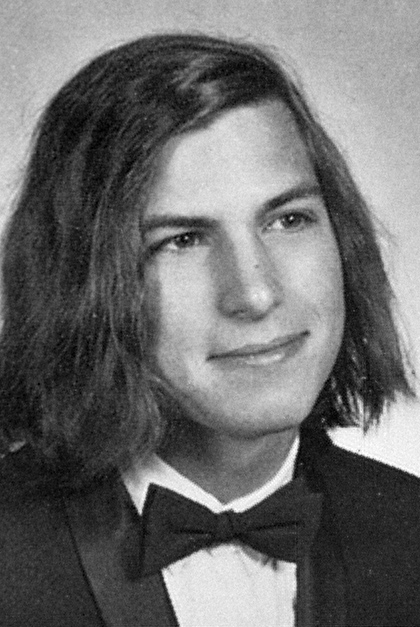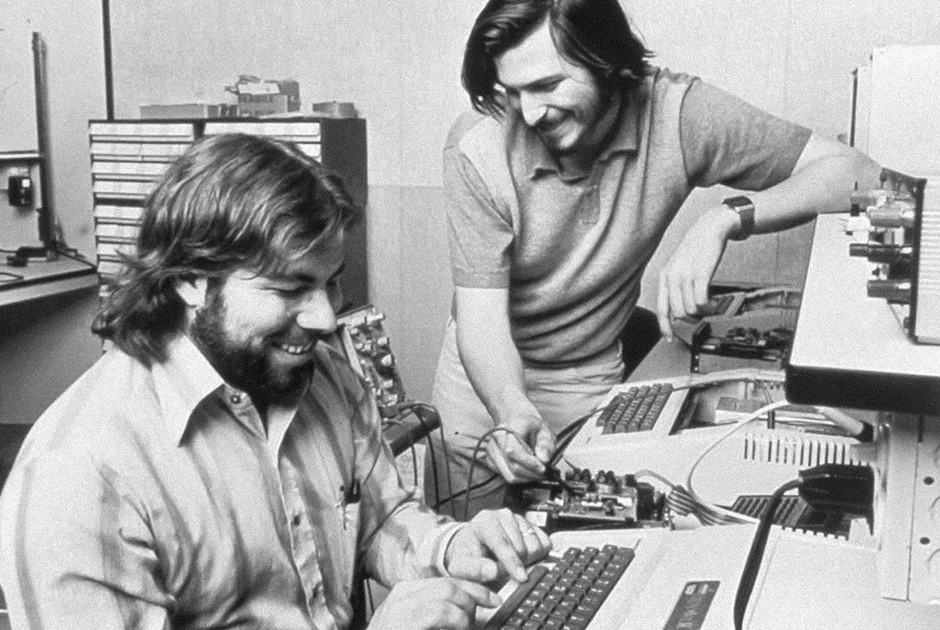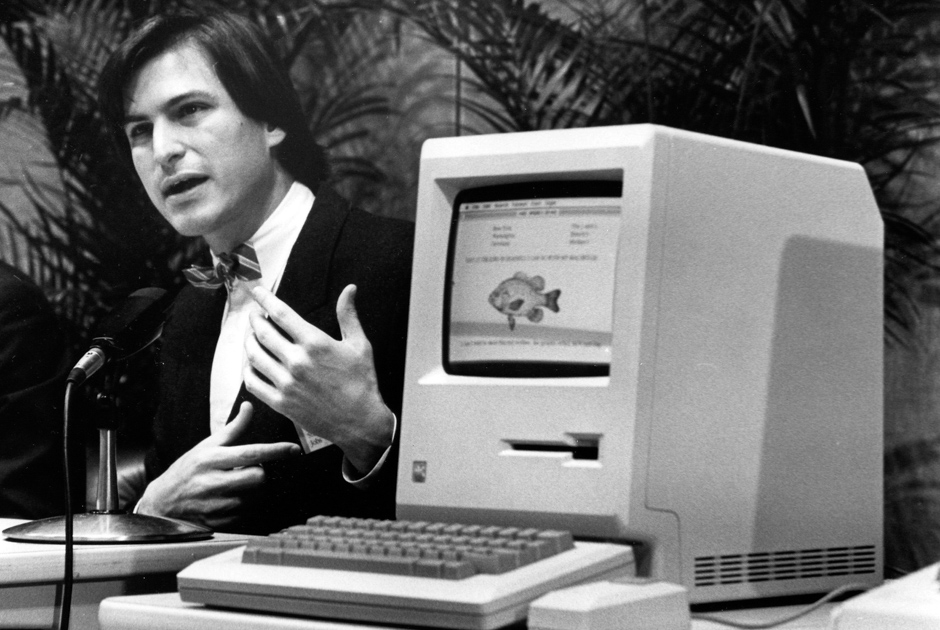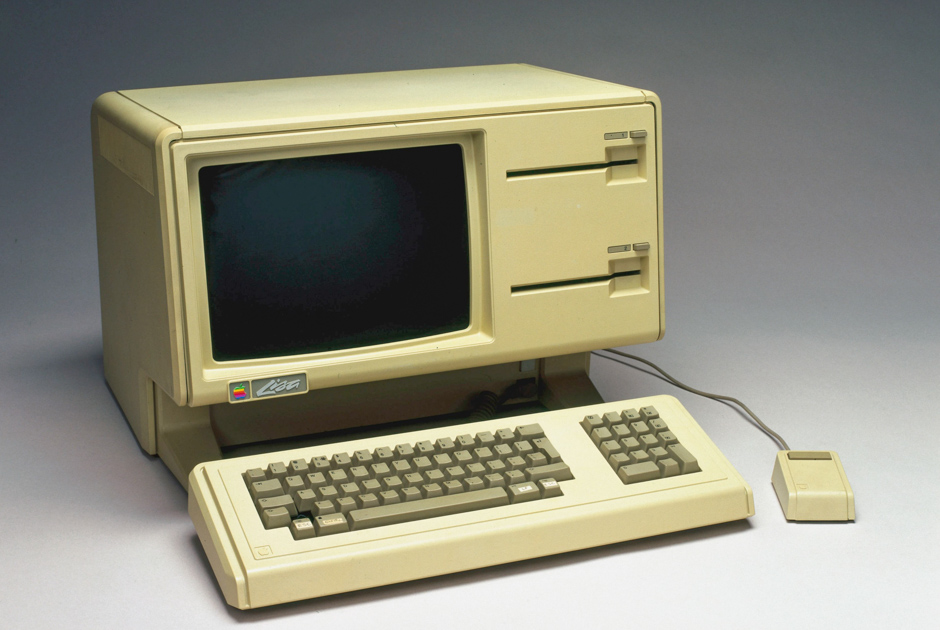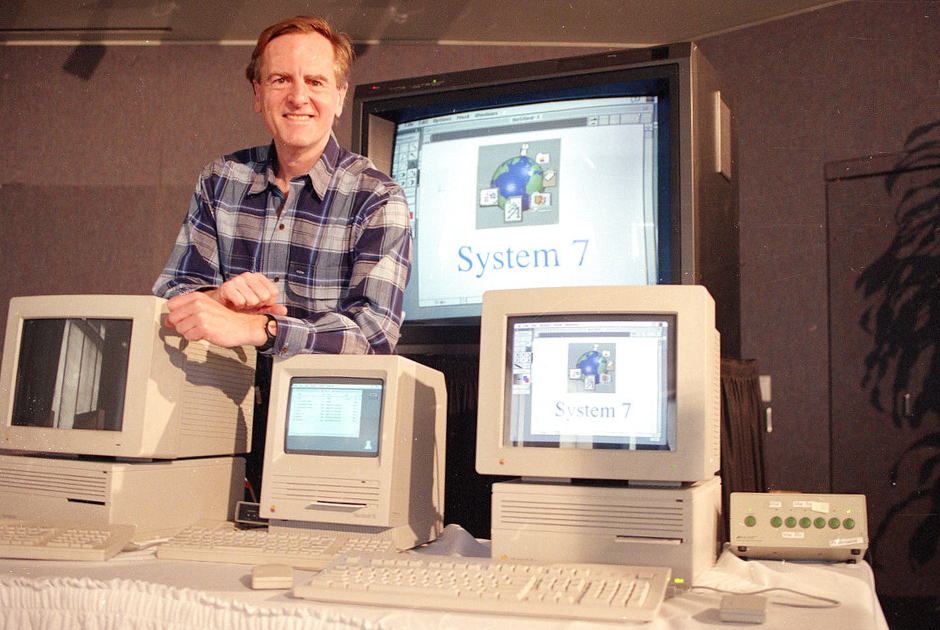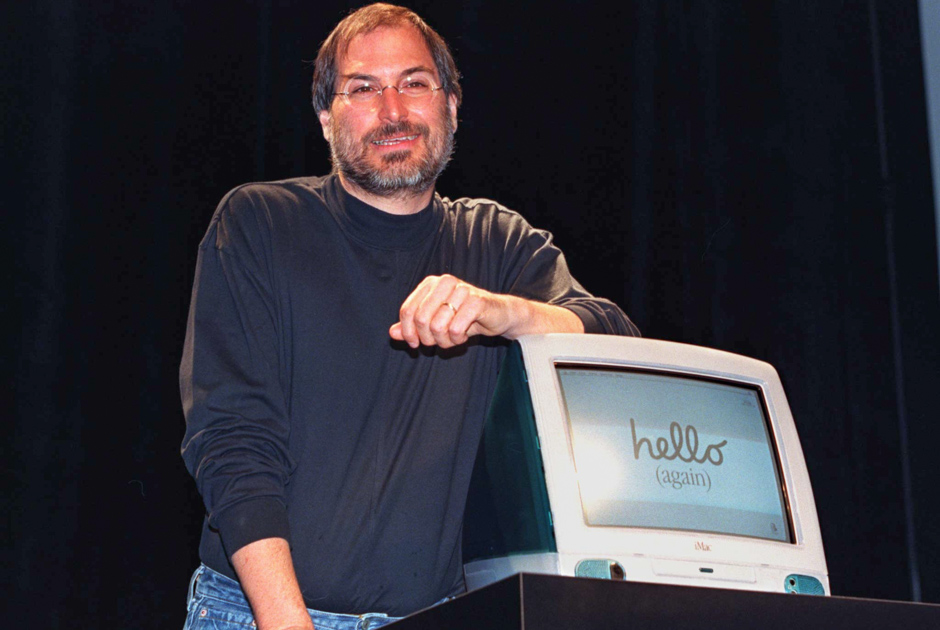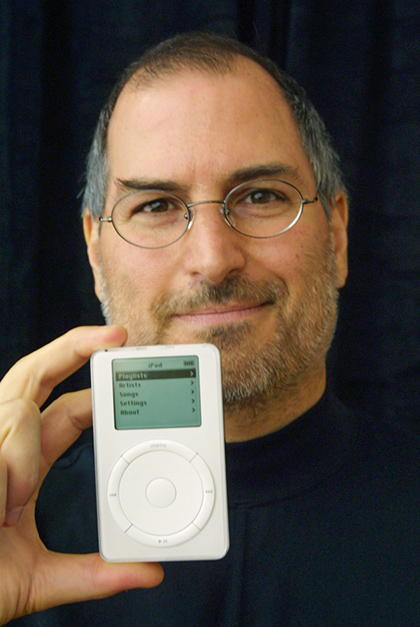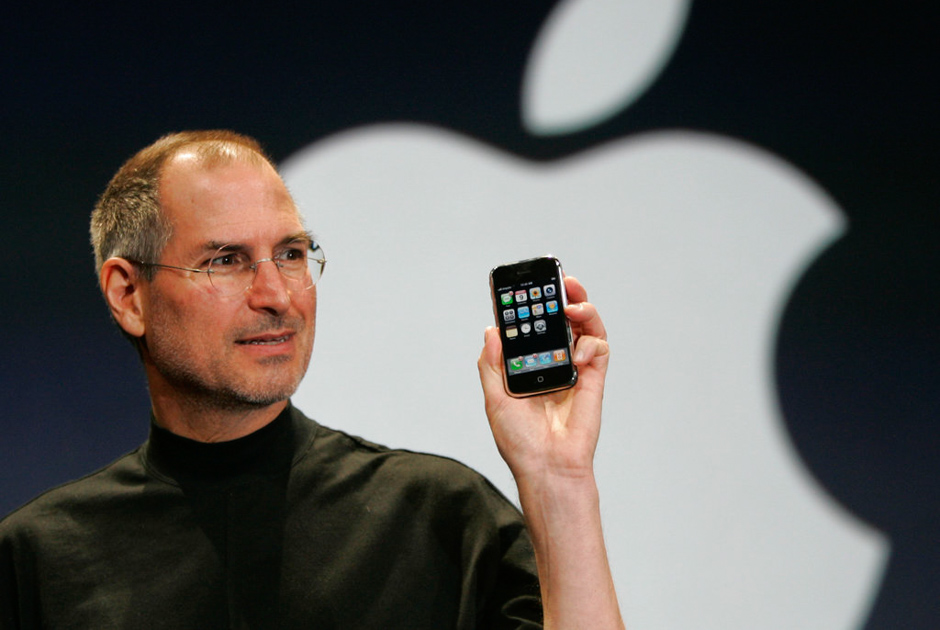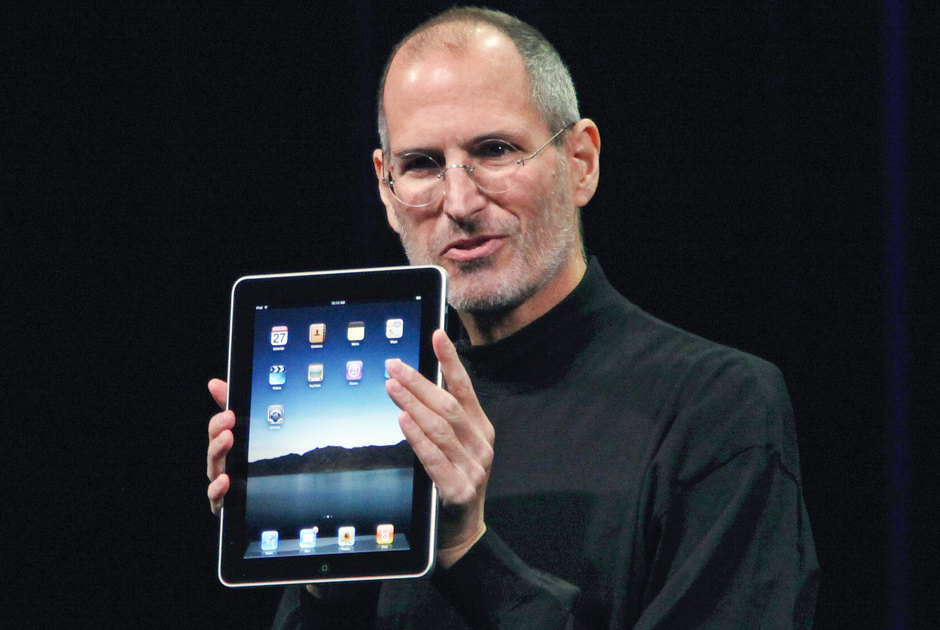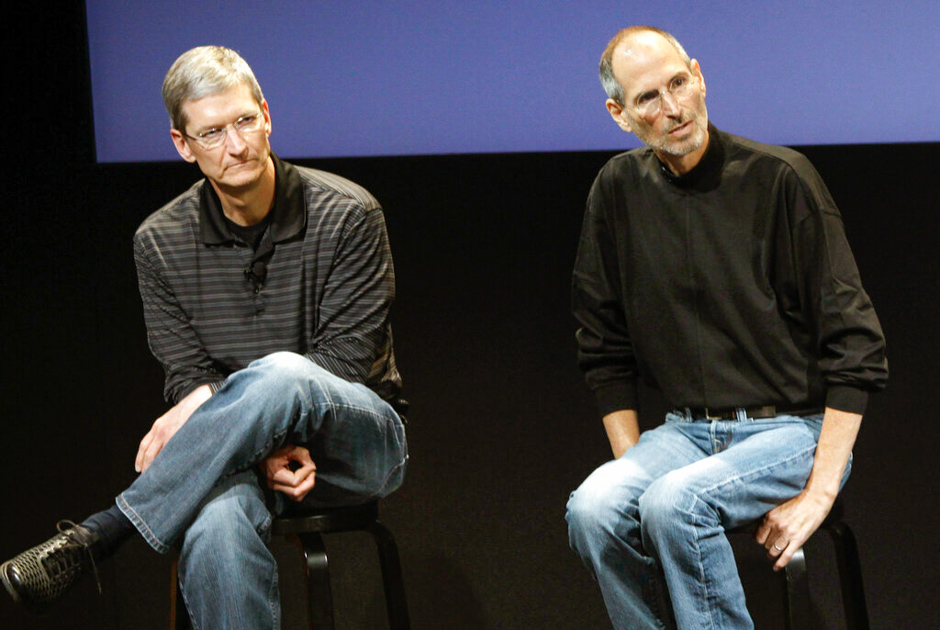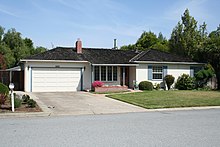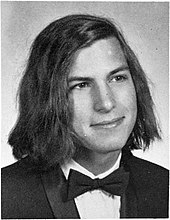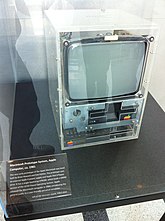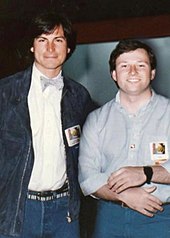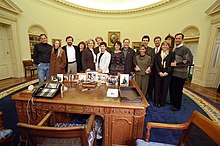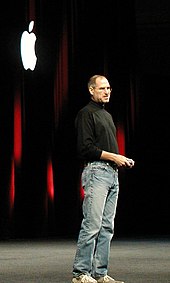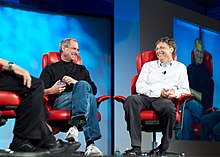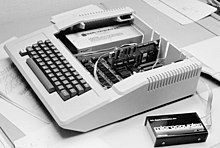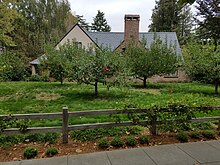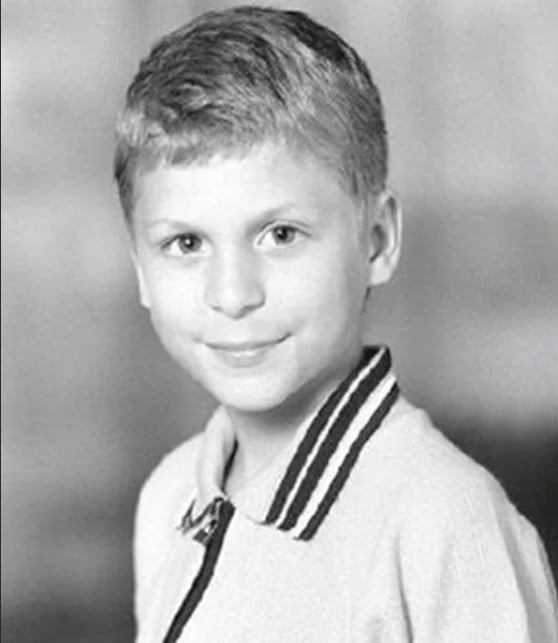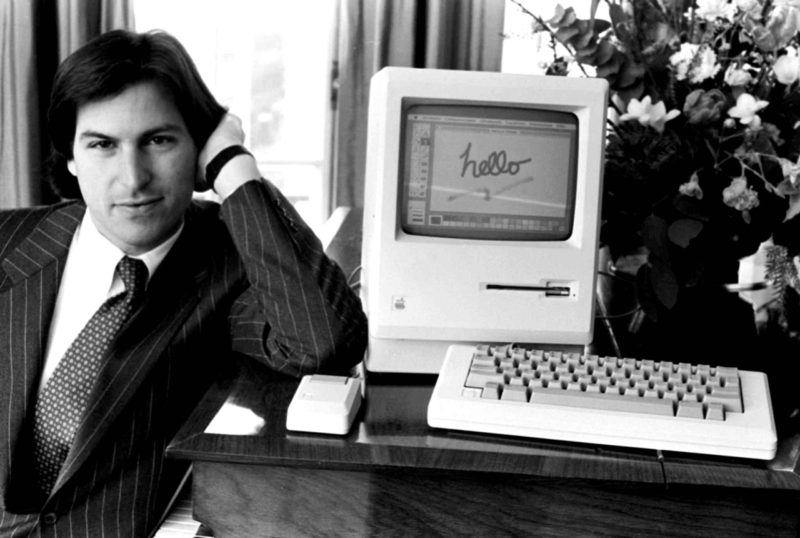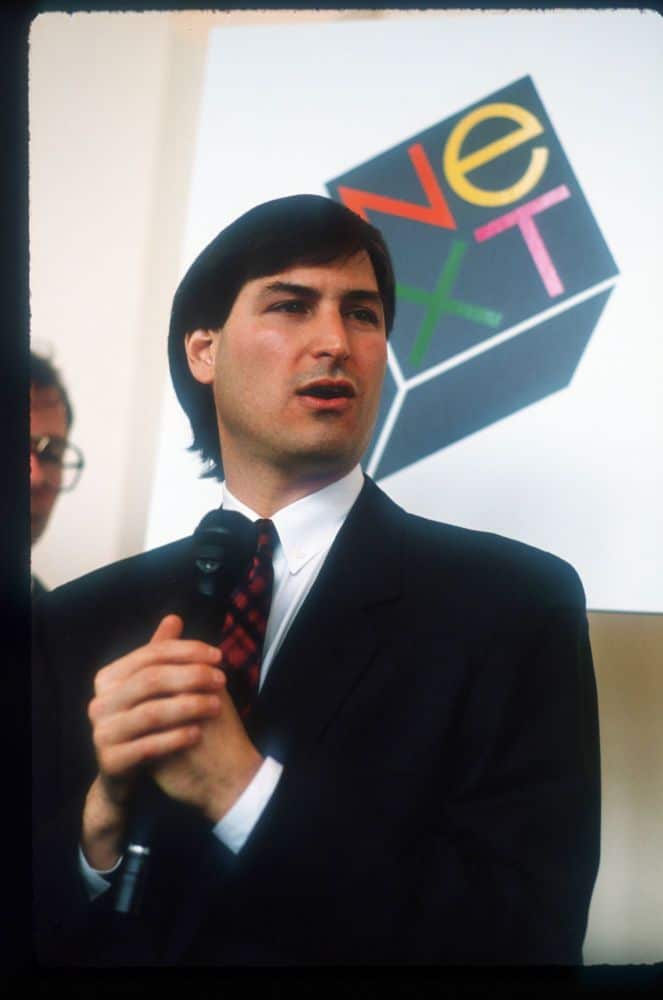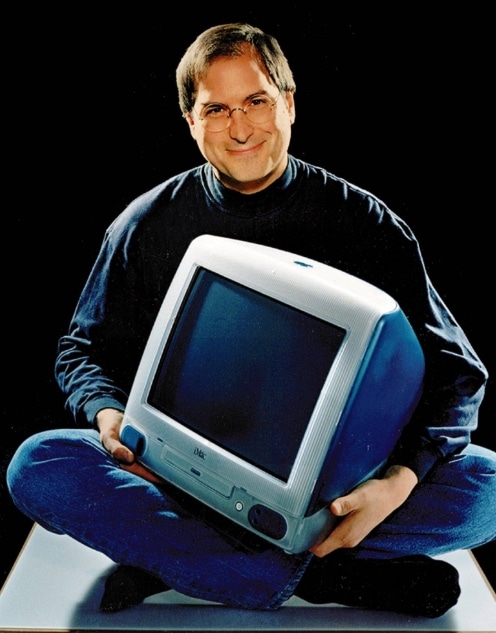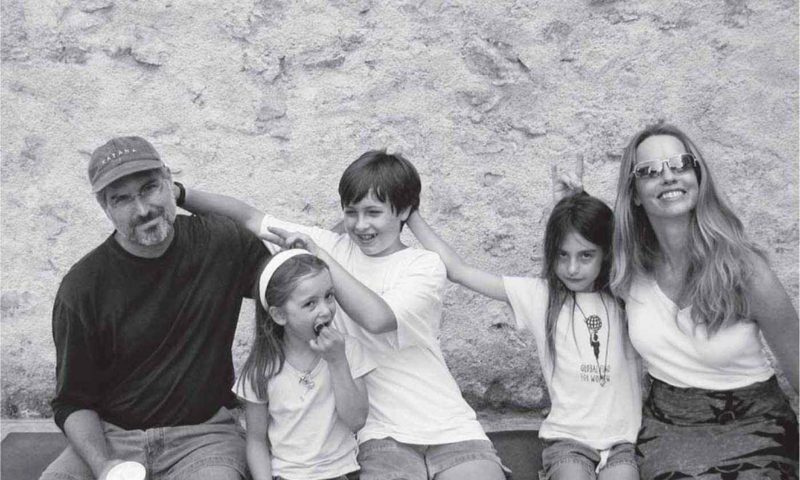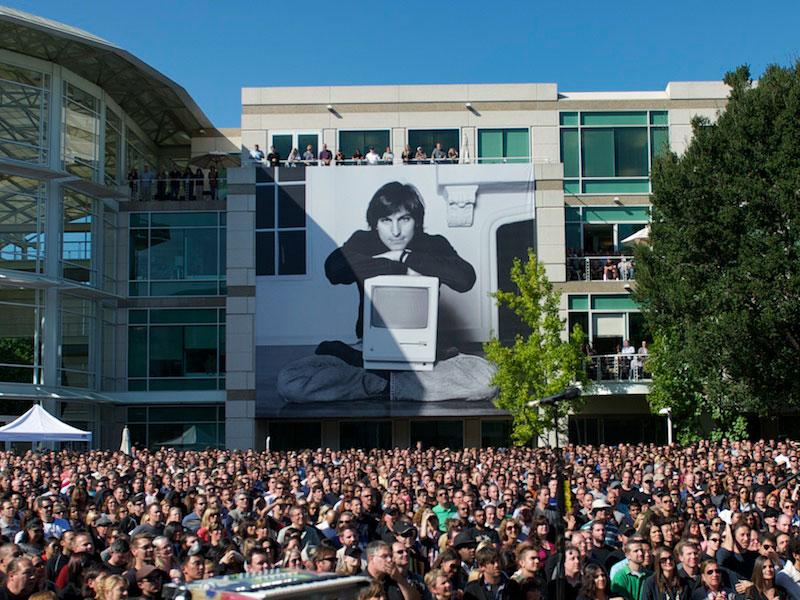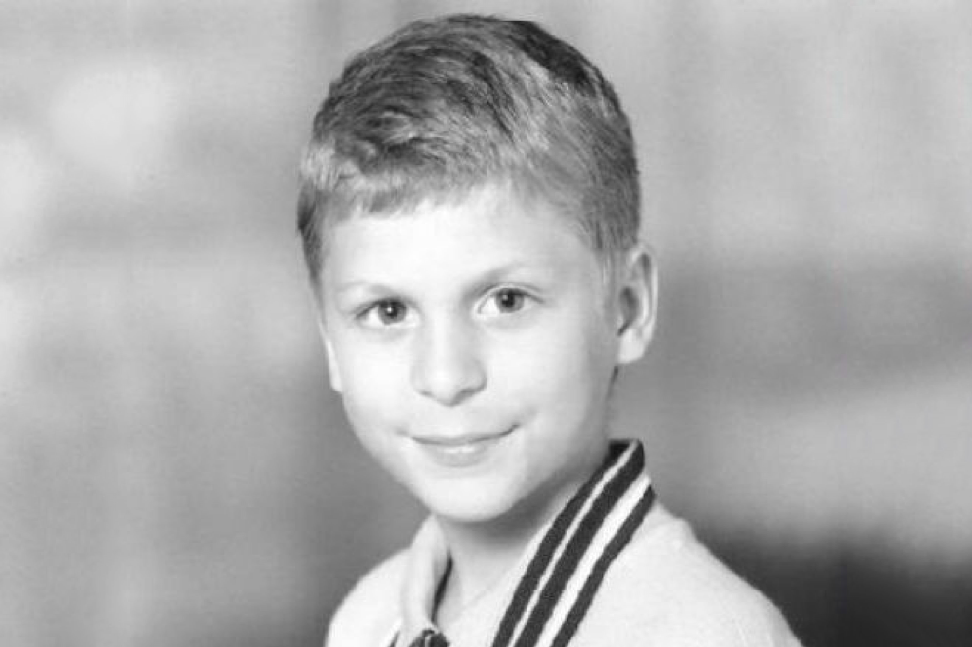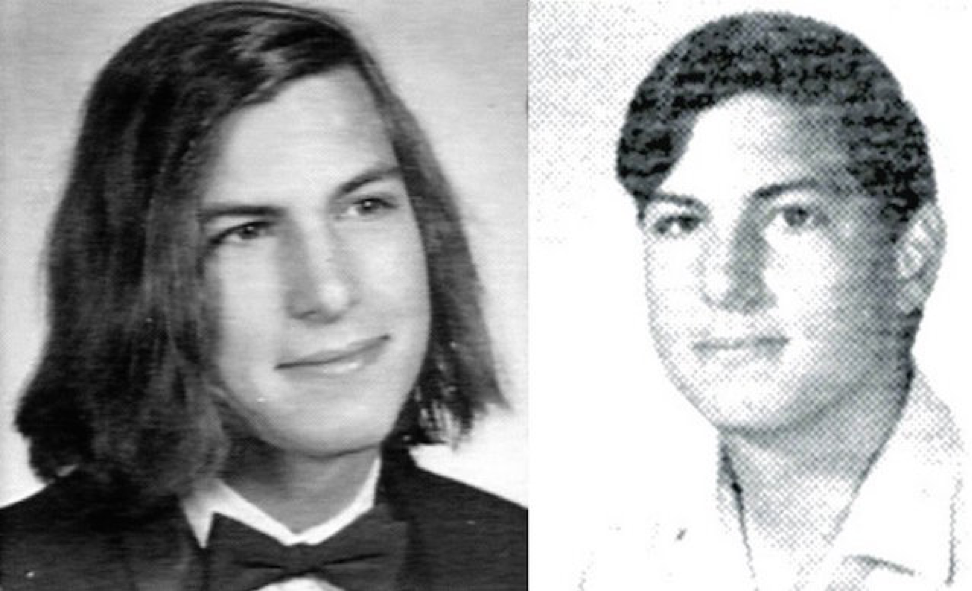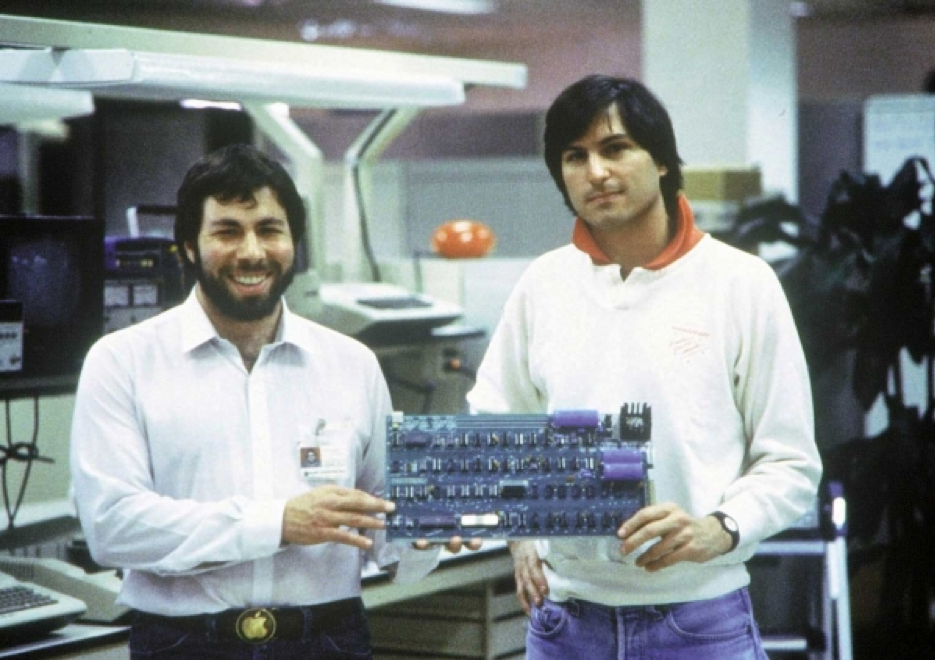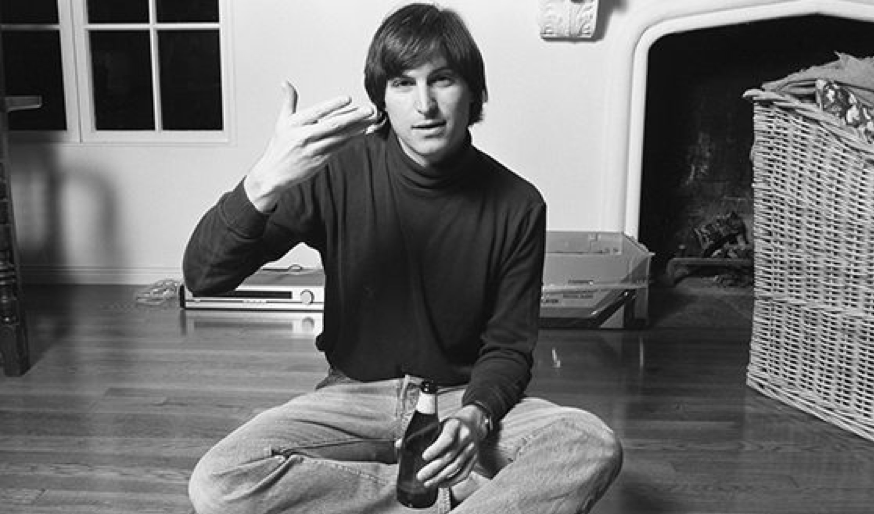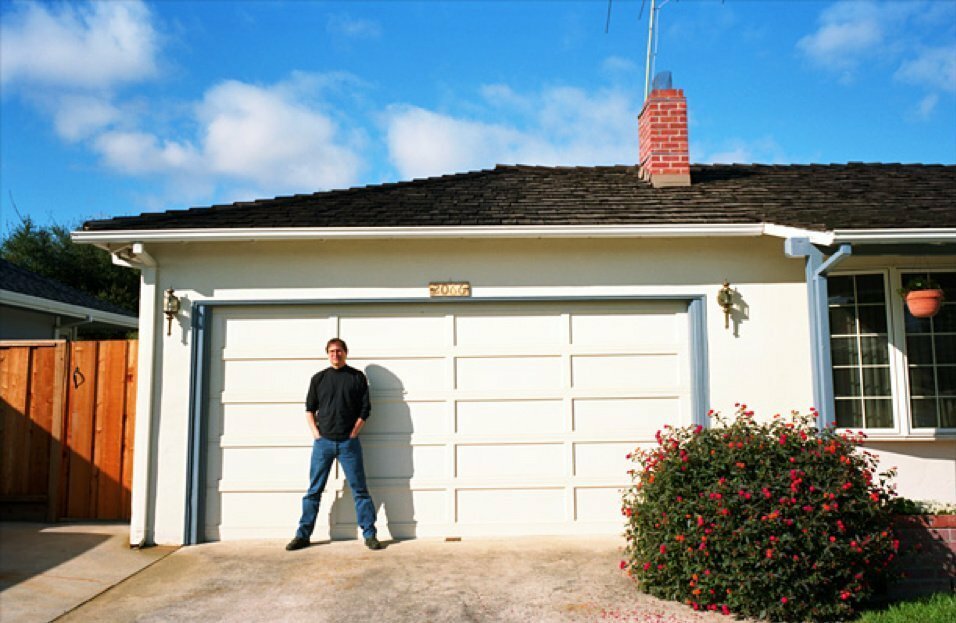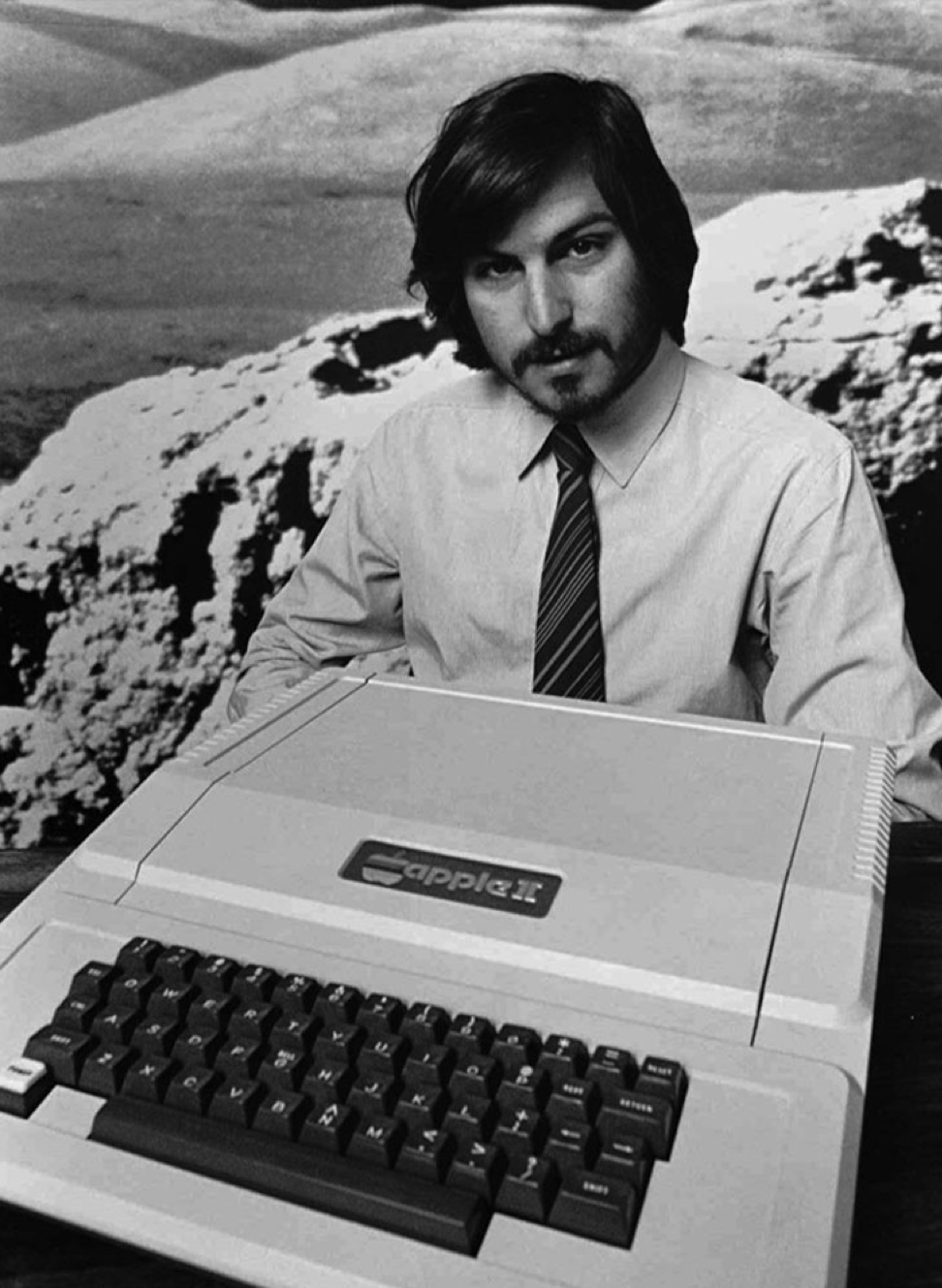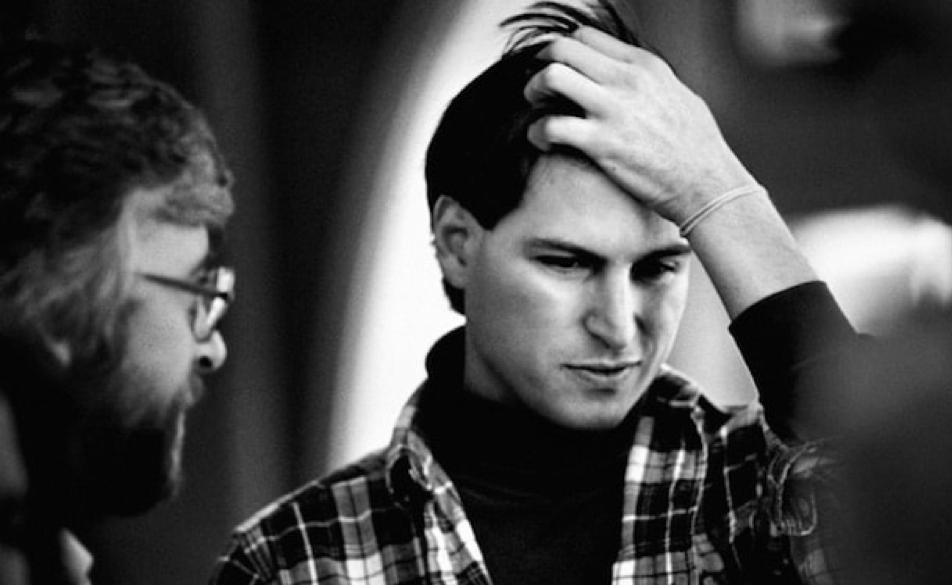Стив Джобс, основатель на сегодняшний день самой дорогой в мире компании Apple, умер 10 лет назад, 5 октября 2011 года. Многие считают его чуть ли не мошенником, который мастерски впаривал потребителям «никому не нужные гаджеты втридорога». Армия фанатов Apple боготворит его, зачастую не понимая, за что. А миллионы людей, которые пользуются айфонами и другой техникой, производимой компанией, нередко вообще не знают, кто создал эту фирму и почему она стала именно тем, чем является сейчас. В годовщину смерти Стива Джобса «Лента.ру» рассказывает, кем предприниматель и шоумен был на самом деле.
Стив Джобс родился 24 февраля 1955 года. Его биологическим отцом был сириец Абдулфаттах Джандали, учившийся в США и встречавшийся с его матерью Джоан Шибле. Вскоре после того, как Шибле забеременела, она рассталась с Джандали и уехала в Сан-Франциско, где родила мальчика, которого отдали в приемную семью Клары и Пола Джобсов.
Маленький Стив рос порядочным сорванцом. В школе он не слушал учителей, все делал по-своему и любил подшучивать над одноклассниками. После школы поступил в престижный Рид-колледж в Портленде, штат Орегон, из которого вскоре ушел, так как, по его словам, не хотел терять там ни времени, ни денег родителей.
Уже в 1974 году его приняла на работу молодая развивающаяся компания Atari, занимавшаяся разработкой компьютерных игр. Джобс занял позицию инженера, при этом не имея никаких особых знаний и квалификации. Ему удалось это сделать потому, что во время собеседования он принес с собой схему клона видеоигры Pong, которую спаял его друг Стив Возняк, и выдал ее за свою разработку.
Стив Джобс, фото из школьного альбома
Фото: Homestead High School
До того как Джобс начал работать в Atari, Возняк собирал для него так называемые «синие коробки», устройства, позволявшие бесплатно пользоваться международной связью, а его предприимчивый приятель находил способы их продавать. Нашлось дело и для второго Стива в игровой компании — Джобс пообещал руководству радикально сократить количество микросхем на интегральной плате игры Breakout. Разумеется, сам он ничего делать не стал и поручил эту задачу Возняку, с которой тот мастерски справился.
За это он получил от Джобса аж 350 долларов — тот сказал, что компания выплатила ему за реализацию проекта 700 долларов, и он просто делит деньги пополам. В реальности Atari заплатила 5000 долларов.
Дом и гараж семьи Джобсов
Фото: Mathieu Thouvenin / Flickr
По сути именно Возняк является причиной, по которой появилась Apple. В 1976 году он на чистом энтузиазме разработал дизайн персонального компьютера, который Джобс убедил его начать продавать. Для этого 1 апреля того же года была основана компания Apple. Она состояла из Джобса, Возняка и администратора Рональда Уэйна и поначалу располагалась в гараже дома Джобсов.
Впрочем, если говорить об Apple I, то, согласно плану Джобса, компания должна была продавать просто интегральные схемы для энтузиастов, которые на их основе сами бы собирали рабочую машину. Настоящий успех пришел к фирме тогда, когда он нашел инвесторов, и они с Возняком представили миру Apple II, свой первый потребительский продукт, в последующие годы снискавший огромную популярность. Тем, кто знаком с советской компьютерной индустрией, должен быть знаком его клон — ПК «Агат».
Стив Джобс и Стив Возняк
Фото: Apple / Dpa / Legion-media.ru
Очень скоро Джобс стал миллионером, а его компания стала быстро развиваться. Он переманил на должность генерального директора бывшего руководителя Pepsi Джона Скалли, задав ему вопрос «ты хочешь всю жизнь продавать сладкую воду или изменить мир?»
Проектом, призванным изменить мир, был «Макинтош», персональный компьютер, собранный в едином корпусе: монитор, дисковод, материнская плата и удобная ручка для переноски. В основу его интерфейса легла операционная система, которую Джобс увидел в лаборатории перспективных разработок PARC компании XEROX. ОС большинства тогдашних ПК работали за счет введения команд в командную строку, а тут был знакомый сейчас всем графический интерфейс с окнами, управляемый мышкой.
Разработка «Макинтоша» велась с 1981 года и была завершена в 1984-м. Джобс считал, что новый продукт произведет революцию в индустрии ПК, и потому позиционировал его соответственно. Достаточно вспомнить рекламный ролик «1984», в котором неназванная героиня, символизирующая новую эпоху, врывается в зал, где безликая серая масса слушает с экрана речь «Большого брата», и разбивает этот экран молотом. «24 января Apple Computer покажет «Макинтош», и вы увидите, почему 1984 год не будет похож на «1984»», — гласили титры, завершающие ролик с отсылкой к антиутопии Джорджа Оруэлла «1984».
Стив Джобс представляет «Макинтош» на собрании акционеров 24 января 1984 года
Фото: UPI / Terry Schmitt / Legion-media.ru
Под «Большим братом» здесь понимались компьютеры компании IBM и совместимые с ними, основанные на открытой архитектуре, относительно недорогие и потому популярные в бизнесе. Им Джобс противопоставлял закрытую, но удобную и новаторскую концепцию «Макинтоша». Вскоре он представил компьютер, устроив театрализованную презентацию для прессы, сценарий для которой написал сам.
Но революции не случилось. Хотя «Макинтош» и был действительно уникальным для своего времени устройством, покупать его не спешили, и к 1985 году стало понятно, что проект если и не полностью провалился, то не занял той позиции, которую для него видел Джобс.
В компании тем временем зрело недовольство — везде, от рядовых сотрудников до совета директоров. По сути, Apple Computers в середине 80-х не была единой фирмой: существовало подразделение перспективных разработок, работавшее над «Макинтошем», и остальная компания, занимавшаяся продажами по-прежнему очень прибыльного Apple II под управлением Джона Скалли.
Более того, «Макинтош» был не первым компьютером с графическим интерфейсом, за разработку которого принимался Джобс. С 1978 года в стенах компании существовал проект LISA, направленный на тот же результат, однако совет директоров отстранил от него основателя компании в 1982 году. В результате достаточно громоздкий компьютер, при этом уступающий в мощности «Макинтошу», был выпущен за год до него, в январе 1983 года. Однако стоил он почти 10 тысяч долларов, и продажи его были мизерными.
Компьютер Apple LISA
Фото: Science Museum / Globallookpress.com
LISA расшифровывается как Local Integrated Software Architecture, но в жизни Джобса была и другая Лиза — его дочь от Крисэнн Бреннан. Хотя впоследствии он говорил, что, разумеется, назвал компьютер в честь нее, здесь все было далеко не так мило и трогательно.
Джобс встречался с Бреннан долгое время, а после создания Apple она получила в компании должность, однако их отношения стали постепенно, но верно разрушаться. Молодая женщина уже подумывала бросить все и разъехаться, когда в 1978 году узнала, что беременна. Джобс не только не обрадовался этому известию, но потом дня три ходил сам не свой.
После рождения дочери он не только не признал отцовство, но и распускал слухи, что Бреннан «спала с кем попало», а он сам бесплоден. Даже после того как ДНК-тест показал, что вероятность его отцовства составляет 94,1 процента, Джобс возмущенно говорил, что, согласно этому тесту, «28 процентов американских мужчин могут быть отцом ребенка». К его чести, через несколько лет он совершенно изменил свое отношение к своей первой дочери и ее матери и признавал, что не взял на себя ответственность, когда должен был это сделать, но, как говорится, сделанного не воротишь.
Подобным образом Джобс зачастую вел себя и в компании. С одной стороны, он умел вдохновлять людей и генерировать идеи, с другой — очень часто был несправедлив и вел себя, как взбалмошный тиран. И, разумеется, все это не очень нравилось совету директоров на тот момент уже крупной и известной компании.
Джон Скалли, генеральный директор Apple, 1991 год
Фото: Paul Sakuma / AP
Провал «Макинтоша» стал последней каплей. Генеральный директор Джон Скалли, приличный, опытный и предсказуемый человек, несомненно, больше импонировал руководству, которое поддержало его план реорганизации компании. Согласно ему, Джобс должен был сдать Скалли подразделение, занимавшееся разработкой «Макинтошей», а самому уйти руководить неким отделом «разработки новых продуктов».
Идея эта основателю Apple, конечно, не понравилась, и он в ответ сам попытался выгнать генерального директора из компании. Но голоса совета директоров были не в его пользу, и в сентябре 1985 года Джобс уволился, забрав с собой несколько ключевых сотрудников.
Решив начать все заново, он основал фирму NeXT, которая занялась разработкой еще одного «революционного» ПК — на этот раз направленного на образовательный сектор. Первые компьютеры новой компании были представлены в 1990 году — опять же на пышной презентации.
И, конечно же, несмотря на то, что рабочие станции NeXT были передовыми для своего времени, а программные технологии, которые были разработаны для них, до сих пор используются во многих продуктах, особой прибыли они не приносили, и, вообще, сама компания оставалась убыточной вплоть до 1994 года.
Стив Джобс и Дэвид Норман, президент Businessland, рядом с рабочими станциями NeXT. 1989 год
Фото: Paul Sakuma / AP
Впрочем, дела в Apple шли существенно хуже. К середине 1990-х годов рынок ПК был практически полностью оккупирован IBM-совместимыми компьютерами под управлением ОС Microsoft, и «Яблоку» тут падать действительно было некуда.
Генеральные директора приходили и уходили, компания разрабатывала концепции новых устройств, но ни одно из них не «взлетало» — а зачастую все так и оставалось на стадии умозрительного прототипа. Дорогостоящие же рабочие станции, которые теперь напоминали обычные ПК, мало кто хотел покупать. Попытка лицензировать производство мак-совместимых систем для других компаний тоже не принесла ожидаемых плодов.
В результате руководство компании приняло, пожалуй, единственно правильное решение. На последние деньги оно приобрело NeXT и Стива Джобса вместе с ней, который в 1997 году стал временным генеральным директором Apple и сосредоточился на том, чтобы сделать компанию вновь прибыльной.
Это уже был другой Джобс, с одной стороны, такой же требовательный и горящий идеями, но уже гораздо лучше разбирающийся в людях и производственном процессе в целом. В течение буквально месяцев он полностью перетряс фирму и наладил процесс в компании, набрав новых руководителей, полностью подчиняющихся ему, и повысив тех, кто в старой компании прозябал на вторых ролях при недюжинных талантах. Таким, например, был Джони Айв, впоследствии главный дизайнер Apple, ответственный до недавнего времени за все продукты компании.
Стив Джобс и iMac
Фото: Mousse Mousse / Reuters
Провозгласив стратегию Think Different — «Думай иначе» — Джобс достаточно быстро представил продолжение идеи «Макинтоша» — iMac. Разноцветные пузатые компьютеры размером с монитор сразу вызвали шквал критики. Где дисковод для дискет, почему только CD-ROM? Куда вставлять карты расширения? Кто такое вообще купит?
Но пользователи рассудили по-другому. Сравнительно недорогой iMac не нужно было настраивать, подключать к нему какие-либо провода, устанавливать ПО. Все работало прямо из коробки и работало хорошо. Новый компьютер Apple продавался отлично.
Стив Джобс убрал из своей должности приставку «временный», вновь почувствовав компанию своей. Вскоре вышла совершенно новая операционная система для «маков», основанная на разработках NeXT — Mac OS X. Появились разноцветные ноутбуки iBook со встроенным модулем Wi-Fi, что в те дни было в новинку.
Каждый новый продукт он представлял на очередной презентации, зрелищность которой обеспечивало его безошибочное чутье на то, как заставить человека удивляться, казалось бы, достаточно обыденным вещам. И каждый новый продукт он любил, как собственного ребенка. Но на этот раз у него уже была настоящая семья, жена и трое детей, к которым он возвращался с работы и которые ждали его дома.
Как рассказывал сам Джобс, в Лорен Пауэлл он влюбился с первого взгляда в 1989 году, когда она читала лекцию в Стэнфордской высшей школе бизнеса. Он пригласил ее пообедать, и с тех пор они практически никогда не расставались. В 1990 году они заключили брак на буддистской брачной церемонии, а в 1991 году у них родился первый ребенок, Рид. Потом в 1995-м родилась Эрин, а в 1998-м — Ив.
Остепенившись, Джобс не потерял своего взрывного характера, чрезвычайно жестко реагируя на все, что казалось ему глупым, непродуктивным, на проявления зашоренности сознания и любви к крючкотворству. Зато пришло понимание не только того, что он хочет, но и того, как и благодаря чему этого достичь.
Он не собирался останавливаться на достигнутом и спокойно руководить компанией, которая выпускает только очень хорошие десктопы и ноутбуки. Его внимание привлек цифровой музыкальный рынок, который в тот момент находился в полном раздрае, — благодаря пиратскому сервису Napster люди переставали покупать физические носители и скачивали музыку нелегально. Единого же цифрового магазина, где можно было бы купить любой нужный тебе альбом, просто не существовало.
Благодаря своей способности убеждать людей в чем угодно, Джобсу удалось заставить практически все крупные лейблы подписать контракты с Apple. Так родился музыкальный магазин iTunes.
Стив Джобс и iPod
Фото: Susan Ragan SR / SV / Reuters
Но музыку хотелось на чем-то слушать на ходу, а тогда это можно было делать практически исключительно с помощью плееров на основе CD-дисков и кассет. Поэтому появление iPod — mp3-плеера на основе жесткого диска с ЖК-дисплеем и уникальным и очень удобным элементом управления — колесом, прокручивая которое, было очень удобно выбирать песни, — было предрешено. На презентации Джобс хвастался, что на жесткий диск поместится почти вся медиатека пользователя, а практически любой трек или альбом можно купить в iTunes Store.
За время своей жизни Стив Джобс перепробовал множество разных духовных практик, а вместе с ними и диет. Было время, когда он питался только фруктами, а однажды неделю просидел на одной моркови. Он то ударялся в полное вегетарианство, то заявлял, что не ест только теплокровных…
Так или иначе, но до добра это не довело. Его пищеварительная система находилась не в самой лучшей форме. Однажды в 2004 году во время обследования почек врач указал ему на одно очень нехорошее затемнение на снимке его поджелудочной железы. Опасения подтвердились — это был рак, причем скорее всего неизлечимый.
Казалось бы, здравомыслящий человек должен был сразу лечь на операцию и начать химиотерапию, но не таким был Стив Джобс. Он немедленно ударился во всевозможные практики осознанности и полгода пытался извести новообразование духовной пищей в сочетании с траволечением. Разумеется, это не помогло.
Стив Джобс во время произнесения Стэнфордской речи
Фото: MediaNews Group / The Mercury News / Getty Images
Тогда ему пришлось в первый раз на время доверить бразды правления компании своей правой руке — директору по операционной деятельности Тиму Куку — и лечь под нож. Через некоторое время Джобс вернулся на свой пост и, похоже, многое переосмыслил. Диагноз не остановил его, а только подтолкнул к новым свершениям. «Оставайтесь голодными, оставайтесь безрассудными», — так он закончил свою речь через год после этого в Стэнфордском университете. То есть всех нас ждет смерть, так зачем терять время на бездействие в сытости и спокойствии?
И он больше не остановился ни на секунду. В 2007 году он заявил изумленной публике, что собирается представить три устройства: полноэкранный iPod, устройство для того, чтобы сидеть в сети, и телефон. Разумеется, все эти три устройства помещались в одном — это был первый iPhone.
После презентации большинство крупных игроков на рынке смартфонов не верили, что iPhone кого-то привлечет. В самом деле, ведь на него нельзя устанавливать приложения! У него нет 3G, а у наших флагманов есть! У него нет физической клавиатуры — а как на нем тогда нормально печатать?
Стив Джобс представляет первый iPhone
Фото: Paul Sakuma / AP
Они, конечно же, опять ошиблись. То, чего в iPhone не было, вскоре появилось. Но сам он представлял на тот момент самый удобный интерфейс для общения со смартфона. Нигде еще не было инертной прокрутки, в большинство тачскринов надо было тыкать стилусами, а телефоны BlackBerry, тогдашние бизнес-флагманы в США, управлялись неуклюжим джойстиком и клавиатурой, занимающей пол-устройства. Более того, на них невозможно было открывать нормальные веб-страницы, предназначенные для ПК. Все это и многое другое мог iPhone и справлялся со своей задачей отлично.
Нельзя, впрочем, сказать, что в эру Стива Джобса не было никаких ошибок. Был ужасный запуск облачных сервисов, был совершенно жуткий Power Mac G4, дико неудобная мышка с шариком вместо колесика. Однако из всех неудач всегда делались выводы и тут же исправлялись, а идеология компании, и прежде всего ее основателя, оставалась прежней.
Стив Джобс не изобретал новые категории продуктов, но старался сделать так, чтобы те, которые уже есть, можно было использовать с удобством и при этом было приятно держать в руках или смотреть на них. Для этого он делил Apple на небольшие команды — эдакие стартапы в рамках большой компании — и заставлял соревноваться на рынке идей. Идея победителя — та, которая больше приглянется ее основателю, претворялась в жизнь.
Однако победный марш Джобса длился недолго. В 2008 году болезнь заявила о себе, дав метастазы в печень. Джобс стал очень быстро худеть, и его нездоровый внешний вид стал привлекать внимание журналистов. Пресс-служба давала отписки, дескать у генерального директора небольшие проблемы со здоровьем, все будет хорошо. Но хорошо уже не было никогда.
Стив Джобс представляет iPad
Фото: Kimberly White / Reuters
В 2009 году Стив Джобсу провели операцию по трансплантации печени. Только встав с койки, он сразу поехал в Apple, где уже давно кипела работа над планшетом iPad. Он провел его презентацию в 2010 году, и было видно, что он совсем плох. В последний раз он появился на сцене весной 2011 года, представляя iPad 2.
Летом и ему, и врачам стало понятно, что это конец. Джобс передвигался с огромным трудом, посещал химиотерапию и слабел с каждым днем. Он до последнего старался приезжать в офис Apple, но по сути все операции уже контролировал Тим Кук, который к тому времени был исполняющим обязанности гендиректора. 24 августа 2011 года он приехал в офис в Купертино в последний раз, чтобы подписать отставку и порекомендовать совету директоров назначить на его пост Кука. Сам же он оставил себе должность председателя совета директоров.
Говоря со своим биографом Уолтером Айзексоном, Джобс сказал, что собирается быть вовлеченным во все дела компании, пока ему позволит здоровье. «У меня была очень удачная карьера, очень удачная жизнь. Я сделал все, что я мог», — сказал он тогда.
Тим Кук и Стив Джобс
Фото: Paul Sakuma / AP
Джобс не случайно использовал прошедшее время — в глубине души он знал наверняка, что все кончено. 4 октября 2011 года состоялась большая презентация нового iPhone, на которой он не присутствовал. Руководство Apple старалась вести ее соответственно регламенту, но то, что им не по себе, выдавала монотонная речь и натянутые улыбки.
На следующий день после этой презентации Стив Джобс умер в окружении родных и близких. Его последними словами, как рассказывала его сестра Мона Симпсон, были «Ого! Ого! Ого!»
Что бы ни увидел он впереди, вряд ли в этот момент он волновался за свою компанию. Каток Apple, заряженный идеями Стива Джобса, катится вперед под руководством Тима Кука. Сейчас его компания стоит более двух триллионов долларов и является самой дорогой в мире. Нет тех, кто не знает, что такое iPhone, а новые устройства Apple продолжают захватывать все новые рынки. Как говорится, Джобс умер, но дело его живет.
|
Steve Jobs |
|
|---|---|
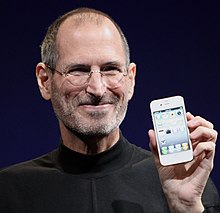
Jobs introducing the iPhone 4 in 2010 |
|
| Born | February 24, 1955
San Francisco, California, U.S. |
| Died | October 5, 2011 (aged 56)
Palo Alto, California, U.S. |
| Resting place | Alta Mesa Memorial Park |
| Education | Reed College (attended) |
| Occupations |
|
| Years active | 1971–2011 |
| Known for |
|
| Title |
|
| Board member of |
|
| Spouse |
Laurene Powell (m. ) |
| Partner | Chrisann Brennan (1972–1977) |
| Children | 4, including Lisa and Eve |
| Relatives |
|
| Awards | |
| Signature | |
Steven Paul Jobs (February 24, 1955 – October 5, 2011) was an American business magnate, industrial designer, media proprietor, and investor. He was the co-founder, chairman, and CEO of Apple; the chairman and majority shareholder of Pixar; a member of The Walt Disney Company’s board of directors following its acquisition of Pixar; and the founder, chairman, and CEO of NeXT. He is widely recognized as a pioneer of the personal computer revolution of the 1970s and 1980s, along with his early business partner and fellow Apple co-founder Steve Wozniak.
Jobs was born in San Francisco to a Syrian father and German-American mother. He was adopted shortly after his birth. Jobs attended Reed College in 1972 before withdrawing that same year. In 1974, he traveled through India seeking enlightenment before later studying Zen Buddhism. He and Wozniak co-founded Apple in 1976 to sell Wozniak’s Apple I personal computer. Together the duo gained fame and wealth a year later with production and sale of the Apple II, one of the first highly successful mass-produced microcomputers. Jobs saw the commercial potential of the Xerox Alto in 1979, which was mouse-driven and had a graphical user interface (GUI). This led to the development of the unsuccessful Apple Lisa in 1983, followed by the breakthrough Macintosh in 1984, the first mass-produced computer with a GUI. The Macintosh introduced the desktop publishing industry in 1985 with the addition of the Apple LaserWriter, the first laser printer to feature vector graphics.
In 1985, Jobs was forced out of Apple after a long power struggle with the company’s board and its then-CEO, John Sculley. That same year, Jobs took a few Apple employees with him to found NeXT, a computer platform development company that specialized in computers for higher-education and business markets. In addition, he helped to develop the visual effects industry when he funded the computer graphics division of George Lucas’s Lucasfilm in 1986. The new company was Pixar, which produced the first 3D computer-animated feature film Toy Story (1995) and went on to become a major animation studio, producing over 25 films since.
In 1997, Jobs returned to Apple as CEO after the company’s acquisition of NeXT. He was largely responsible for reviving Apple, which was on the verge of bankruptcy. He worked closely with English designer Jony Ive to develop a line of products that had larger cultural ramifications, beginning with the «Think different» advertising campaign and leading to the Apple Store, App Store (iOS), iMac, iPad, iPod, iPhone, iTunes, and iTunes Store. In 2001, the original Mac OS was replaced with the completely new Mac OS X (now known as macOS), based on NeXT’s NeXTSTEP platform, giving the operating system a modern Unix-based foundation for the first time. In 2003, Jobs was diagnosed with a pancreatic neuroendocrine tumor. He died of respiratory arrest related to the tumor on October 5, 2011, at the age of 56. In 2022, he was posthumously awarded the Presidential Medal of Freedom.
Background
Family
Steven Paul Jobs was born in San Francisco, California, on February 24, 1955, to Joanne Carole Schieble and Abdulfattah Jandali (Arabic: عبد الفتاح الجندلي).[2] His cousin, Bassma Al Jandaly, maintains that his birth name was Abdul Lateef Jandali.[3] He was adopted by Clara (née Hagopian) and Paul Reinhold Jobs.[2]
Abdulfattah «John» Jandali was born and raised in an Arab Muslim household in Homs, Syria. As an undergraduate at the American University of Beirut in Lebanon, he was a student activist and was imprisoned for his political activities.[4] He pursued a PhD at the University of Wisconsin, where he met Joanne Schieble, an American Catholic of German and Swiss descent.[4][5] Both of the same age, Jandali was a doctoral candidate and a teaching assistant for a course Schieble was taking.[6] Novelist Mona Simpson, Jobs’s biological sister, noted that Schieble’s Catholic parents were unhappy that their daughter was with a Muslim.[7] Jobs’s biographer Walter Isaacson states that Schieble’s dying father «threatened to disown her if she wed Abdulfattah»,[6] so they remained an unmarried couple.[5]
Paul Jobs was a Coast Guard mechanic.[8] After leaving the Coast Guard, he married Clara Hagopian, an American of Armenian descent, in 1946.[9] An ectopic pregnancy led them to consider adoption in 1955.[8][9][10]
Early life
Of all the inventions of humans, the computer is going to rank near or at the top as history unfolds and we look back. It is the most awesome tool that we have ever invented. I feel incredibly lucky to be at exactly the right place in Silicon Valley, at exactly the right time, historically, where this invention has taken form.
—Steve Jobs, 1995[11]
Schieble became pregnant with Jobs in 1954, when she and Jandali spent the summer with his family in Homs. According to Jandali, Schieble deliberately did not involve him in the process: «Without telling me, Joanne upped and left to move to San Francisco to have the baby without anyone knowing, including me.»[12]
Schieble gave birth to Jobs in San Francisco on February 24, 1955, and chose an adoptive couple for him that was «Catholic, well-educated, and wealthy»,[13][14] but the couple later changed their minds.[13] He was then placed with Paul and Clara Jobs, who lacked wealth and college education, and Schieble refused to sign the adoption papers.[15] She asked the court to find a different family,[13] but consented when Paul and Clara pledged to fund his college education.[16]
In his youth, his parents took him to a Lutheran church.[17] When he was in high school, Clara admitted to his girlfriend, Chrisann Brennan, that she «was too frightened to love [Steve] for the first six months of his life … I was scared they were going to take him away from me. Even after we won the case, Steve was so difficult a child that by the time he was two I felt we had made a mistake. I wanted to return him.» When Chrisann shared this comment with Steve, he stated that he was already aware,[13] and later said he had been deeply loved and indulged by Paul and Clara. Many years later, Jobs’s wife Laurene also noted that «he felt he had been really blessed by having the two of them as parents.»[18][page needed] Jobs would «bristle» when Paul and Clara were referred to as his “adoptive parents”, and he regarded them as his parents “1,000%”. Jobs referred to his biological parents as «my sperm and egg bank. That’s not harsh, it’s just the way it was, a sperm bank thing, nothing more.»[8]
Childhood
I always thought of myself as a humanities person as a kid, but I liked electronics… then I read something that one of my heroes, Edwin Land of Polaroid, said about the importance of people who could stand at the intersection of humanities and sciences, and I decided that’s what I wanted to do.
—Steve Jobs[19]
Paul Jobs worked in several jobs that included a try as a machinist,[20]
several other jobs,[21] and then «back to work as a machinist».
Paul and Clara adopted Jobs’s sister Patricia in 1957[22] and by 1959 the family had moved to the Monta Loma neighborhood in Mountain View, California.[23] Paul built a workbench in his garage for his son in order to «pass along his love of mechanics”. Jobs, meanwhile, admired his father’s craftsmanship «because he knew how to build anything. If we needed a cabinet, he would build it. When he built our fence, he gave me a hammer so I could work with him … I wasn’t that into fixing cars … but I was eager to hang out with my dad.»[24] By the time he was ten, Jobs was deeply involved in electronics and befriended many of the engineers who lived in the neighborhood.[25][page needed] He had difficulty making friends with children his own age, however, and was seen by his classmates as a «loner».[25][page needed]
Childhood family home of Steve Jobs on Crist Drive in Los Altos, California, and the original site of Apple Computer. The home was added to a list of historic Los Altos sites in 2013.[26]
Jobs had difficulty functioning in a traditional classroom, tended to resist authority figures, frequently misbehaved, and was suspended a few times. Clara had taught him to read as a toddler, and Jobs stated that he was «pretty bored in school and [had] turned into a little terror… you should have seen us in the third grade, we basically destroyed the teacher.»[25][page needed] He frequently played pranks on others at Monta Loma Elementary School in Mountain View. His father Paul (who was abused as a child) never reprimanded him, however, and instead blamed the school for not challenging his brilliant son.[27]
Jobs would later credit his fourth grade teacher, Imogene «Teddy» Hill, with turning him around: «She taught an advanced fourth grade class, and it took her about a month to get hip to my situation. She bribed me into learning. She would say, ‘I really want you to finish this workbook. I’ll give you five bucks if you finish it.’ That really kindled a passion in me for learning things! I learned more that year than I think I learned in any other year in school. They wanted me to skip the next two years in grade school and go straight to junior high to learn a foreign language, but my parents very wisely wouldn’t let it happen.» Jobs skipped the 5th grade and transferred to the 6th grade at Crittenden Middle School in Mountain View[25][page needed] where he became a «socially awkward loner».[28] Jobs was often «bullied» at Crittenden Middle, and in the middle of 7th grade, he gave his parents an ultimatum: either they would take him out of Crittenden or he would drop out of school.[29]
The Jobs family was not affluent, and only by expending all their savings were they able to buy a new home in 1967, allowing Steve to change schools.[25][page needed] The new house (a three-bedroom home on Crist Drive in Los Altos, California) was in the better Cupertino School District, Cupertino, California,[30] and was embedded in an environment even more heavily populated with engineering families than the Mountain View area was.[25][page needed] The house was declared a historic site in 2013, as the first site of Apple Computer.[26] As of 2013, it was owned by Jobs’s sister, Patty, and occupied by his stepmother, Marilyn.[31]
When he was 13, in 1968, Jobs was given a summer job by Bill Hewlett (of Hewlett-Packard) after Jobs cold-called him to ask for parts for an electronics project.[25][page needed]
Homestead High
The location of the Los Altos home meant that Jobs would be able to attend nearby Homestead High School, which had strong ties to Silicon Valley.[19] He began his first year there in late 1968 along with Bill Fernandez,[25][page needed] who introduced Jobs to Steve Wozniak, and would become Apple’s first employee. Neither Jobs nor Fernandez (whose father was a lawyer) came from engineering households and thus decided to enroll in John McCollum’s Electronics I class.[25][page needed] Jobs had grown his hair long and become involved in the growing counterculture, and the rebellious youth eventually clashed with McCollum and lost interest in the class.[25][page needed]
He underwent a change during mid-1970: «I got stoned for the first time; I discovered Shakespeare, Dylan Thomas, and all that classic stuff. I read Moby Dick and went back as a junior taking creative writing classes.»[25][page needed] Jobs later noted to his official biographer that «I started to listen to music a whole lot, and I started to read more outside of just science and technology—Shakespeare, Plato. I loved King Lear … when I was a senior I had this phenomenal AP English class. The teacher was this guy who looked like Ernest Hemingway. He took a bunch of us snowshoeing in Yosemite.» During his last two years at Homestead High, Jobs developed two different interests: electronics and literature.[32] These dual interests were particularly reflected during Jobs’s senior year as his best friends were Wozniak and his first girlfriend, the artistic Homestead junior Chrisann Brennan.[33]
In 1971, after Wozniak began attending University of California, Berkeley, Jobs would visit him there a few times a week. This experience led him to study in nearby Stanford University’s student union. Instead of joining the electronics club, Jobs put on light shows with a friend for Homestead’s avant-garde jazz program. He was described by a Homestead classmate as «kind of brain and kind of hippie … but he never fit into either group. He was smart enough to be a nerd, but wasn’t nerdy. And he was too intellectual for the hippies, who just wanted to get wasted all the time. He was kind of an outsider. In high school everything revolved around what group you were in, and if you weren’t in a carefully defined group, you weren’t anybody. He was an individual, in a world where individuality was suspect.» By his senior year in late 1971, he was taking freshman English class at Stanford and working on a Homestead underground film project with Chrisann Brennan.[34][35]
Around that time, Wozniak designed a low-cost digital «blue box» to generate the necessary tones to manipulate the telephone network, allowing free long-distance calls. He was inspired by an article titled «Secrets of the Little Blue Box» from the October 1971 issue of Esquire.[36] Jobs decided then to sell them and split the profit with Wozniak. The clandestine sales of the illegal blue boxes went well and perhaps planted the seed in Jobs’s mind that electronics could be both fun and profitable.[37] In a 1994 interview, he recalled that it took six months for him and Wozniak to design the blue boxes.[38] Jobs later reflected that had it not been for Wozniak’s blue boxes, «there wouldn’t have been an Apple».[39] He states it showed them that they could take on large companies and beat them.[40][41]
By his senior year of high school, Jobs began using LSD.[42] He later recalled that on one occasion he consumed it in a wheat field outside Sunnyvale, and experienced «the most wonderful feeling of my life up to that point».[43] In mid-1972, after graduation and before leaving for Reed College, Jobs and Brennan rented a house from their other roommate, Al.[44]
Reed College
In September 1972, Jobs enrolled at Reed College in Portland, Oregon.[45] He insisted on applying only to Reed, although it was an expensive school that Paul and Clara could ill afford.[46] Jobs soon befriended Robert Friedland,[47] who was Reed’s student body president at that time.[25][page needed] Brennan remained involved with Jobs while he was at Reed. He later asked her to come and live with him in a house he rented near the Reed campus, but she refused.[citation needed]
After just one semester, Jobs dropped out of Reed College without telling his parents.[48] Jobs later explained this was because he did not want to spend his parents’ money on an education that seemed meaningless to him. He continued to attend by auditing his classes,[49] including a course on calligraphy that was taught by Robert Palladino. In a 2005 commencement speech at Stanford University, Jobs stated that during this period, he slept on the floor in friends’ dorm rooms, returned Coke bottles for food money, and got weekly free meals at the local Hare Krishna temple. In that same speech, Jobs said: “If I had never dropped in on that single calligraphy course in college, the Mac would have never had multiple typefaces or proportionally spaced fonts.”[50]
1974–1985
I was lucky to get into computers when it was a very young and idealistic industry. There weren’t many degrees offered in computer science, so people in computers were brilliant people from mathematics, physics, music, zoology, whatever. They loved it, and no one was really in it for the money […] There are people around here who start companies just to make money, but the great companies, well, that’s not what they’re about.
—Steve Jobs[51]
Pre-Apple
In February 1974, Jobs returned to his parents’ home in Los Altos and began looking for a job.[52] He was soon hired by Atari, Inc. in Los Gatos, California, as a technician.[52][53] Back in 1973, Steve Wozniak designed his own version of the classic video game Pong and gave its electronics board to Jobs. According to Wozniak, Atari only hired Jobs because he took the board down to the company, and they thought that he had built it himself.[54] Atari’s cofounder Nolan Bushnell later described him as «difficult but valuable», pointing out that «he was very often the smartest guy in the room, and he would let people know that.»[55]
During this period, Jobs and Brennan remained involved with each other while continuing to see other people. By early 1974, Jobs was living what Brennan describes as a “simple life” in a Los Gatos cabin, working at Atari, and saving money for his impending trip to India.[citation needed]
Jobs traveled to India in mid-1974[56] to visit Neem Karoli Baba[57] at his Kainchi ashram with his Reed friend (and eventual Apple employee) Daniel Kottke, searching for spiritual enlightenment. When they got to the Neem Karoli ashram, it was almost deserted because Neem Karoli Baba had died in September 1973. Then they made a long trek up a dry riverbed to an ashram of Haidakhan Babaji.[53]
After seven months, Jobs left India[58] and returned to the US ahead of Daniel Kottke.[53] Jobs had changed his appearance; his head was shaved, and he wore traditional Indian clothing.[59][60] During this time, Jobs experimented with psychedelics, later calling his LSD experiences «one of the two or three most important things [he had] done in [his] life».[61][62] He spent a period at the All One Farm, a commune in Oregon that was owned by Robert Friedland. Brennan joined him there for a period.[citation needed]
During this time period, Jobs and Brennan both became practitioners of Zen Buddhism through the Zen master Kōbun Chino Otogawa. Jobs was living in his parents’ backyard toolshed, which he had converted into a bedroom.[citation needed] Jobs engaged in lengthy meditation retreats at the Tassajara Zen Mountain Center, the oldest Sōtō Zen monastery in the US.[63] He considered taking up monastic residence at Eihei-ji in Japan, and maintained a lifelong appreciation for Zen[64], Japanese cuisine, and artists such as Hasui Kawase.[65]
In mid-1975, after returning to Atari, Jobs was assigned to create a circuit board for the arcade video game Breakout.[66] According to Bushnell, Atari offered $100 (equivalent to about $500 in 2021) for each TTL chip that was eliminated in the machine. Jobs had little specialized knowledge of circuit board design and made a deal with Wozniak to split the fee evenly between them if Wozniak could minimize the number of chips. Much to the amazement of Atari engineers, Wozniak reduced the TTL count to 46, a design so tight that it was impossible to reproduce on an assembly line.[67] According to Wozniak, Jobs told him that Atari paid them only $700 (instead of the actual $5,000), and that Wozniak’s share was thus $350.[68] Wozniak did not learn about the actual bonus until ten years later, but said that if Jobs had told him about it and explained that he needed the money, Wozniak would have given it to him.[69]
Jobs and Wozniak attended meetings of the Homebrew Computer Club in 1975, which was a stepping stone to the development and marketing of the first Apple computer.[14]
Apple (1976–1985)
Basically Steve Wozniak and I invented the Apple because we wanted a personal computer. Not only couldn’t we afford the computers that were on the market, those computers were impractical for us to use. We needed a Volkswagen. The Volkswagen isn’t as fast or comfortable as other ways of traveling, but the VW owners can go where they want, when they want and with whom they want. The VW owners have personal control of their car.
—Steve Jobs[25][page needed]
By March 1976, Wozniak completed the basic design of the Apple I computer and showed it to Jobs, who suggested that they sell it; Wozniak was at first skeptical of the idea but later agreed.[70] In April of that same year, Jobs, Wozniak, and administrative overseer Ronald Wayne founded Apple Computer Company (now called Apple Inc.) as a business partnership in Jobs’s parents’ Crist Drive home on April 1, 1976. The operation originally started in Jobs’s bedroom and later moved to the garage.[71][72] Wayne stayed briefly, leaving Jobs and Wozniak as the active primary cofounders of the company.[73] The two decided on the name «Apple» after Jobs returned from the All One Farm commune in Oregon and told Wozniak about his time in the farm’s apple orchard.[74] Jobs originally planned to produce bare printed circuit boards of the Apple I and sell them to computer hobbyists for $50 (equivalent to about $240 in 2021) each. To fund the first batch, Wozniak sold his HP scientific calculator and Jobs sold his Volkswagen van.[75][76] Later that year, computer retailer Paul Terrell purchased 50 fully assembled Apple I units for $500 each.[77][78] Eventually about 200 Apple I computers were produced in total.[79]
| External image |
|---|
A neighbor on Crist Drive recalled Jobs as an odd individual who would greet his clients “with his underwear hanging out, barefoot and hippie-like”. Another neighbor, Larry Waterland, who had just earned his PhD in chemical engineering at Stanford, recalled dismissing Jobs’s budding business compared to the established industry of giant mainframe computers with big decks of punchcards: “Steve took me over to the garage. He had a circuit board with a chip on it, a DuMont TV set, a Panasonic cassette tape deck and a keyboard. He said, ‘This is an Apple computer.’ I said, ‘You’ve got to be joking.’ I dismissed the whole idea.” Jobs’s friend from Reed College and India, Daniel Kottke, recalled that as an early Apple employee, he “was the only person who worked in the garage … Woz would show up once a week with his latest code. Steve Jobs didn’t get his hands dirty in that sense.” Kottke also stated that much of the early work took place in Jobs’s kitchen, where he spent hours on the phone trying to find investors for the company.[31]
They received funding from a then-semi-retired Intel product marketing manager and engineer Mike Markkula.[80] Scott McNealy, one of the cofounders of Sun Microsystems, said that Jobs broke a «glass age ceiling» in Silicon Valley because he’d created a very successful company at a young age.[41] Markkula brought Apple to the attention of Arthur Rock, which after looking at the crowded Apple booth at the Home Brew Computer Show, started with a $60,000 investment and went on the Apple board.[81] Jobs was not pleased when Markkula recruited Mike Scott from National Semiconductor in February 1977 to serve as the first president and CEO of Apple.[82][83]
For what characterizes Apple is that its scientific staff always acted and performed like artists – in a field filled with dry personalities limited by the rational and binary worlds they inhabit, Apple’s engineering teams had passion. They always believed that what they were doing was important and, most of all, fun. Working at Apple was never just a job; it was also a crusade, a mission, to bring better computer power to people. At its roots, that attitude came from Steve Jobs. It was «Power to the People”, the slogan of the sixties, rewritten in technology for the eighties and called Macintosh.
—Jeffrey S. Young, 1987[25][page needed]
After Brennan returned from her own journey to India, she and Jobs fell in love again, as Brennan noted changes in him that she attributes to Kobun (whom she was also still following). It was also at this time that Jobs displayed a prototype Apple I computer for Brennan and his parents in their living room. Brennan notes a shift in this time period, where the two main influences on Jobs were Apple Inc. and Kobun. By early 1977, she and Jobs would spend time together at her home at Duveneck Ranch in Los Altos, which served as a hostel and environmental education center.[citation needed]
In April 1977, Jobs and Wozniak introduced the Apple II at the West Coast Computer Faire.[84] It is the first consumer product to have been sold by Apple Computer. Primarily designed by Wozniak, Jobs oversaw the development of its unusual case and Rod Holt developed the unique power supply.[85] During the design stage, Jobs argued that the Apple II should have two expansion slots, while Wozniak wanted eight. After a heated argument, Wozniak threatened that Jobs should «go get himself another computer». They later agreed on eight slots.[86] The Apple II became one of the first highly successful mass-produced microcomputer products in the world.[87]
As Jobs became more successful with his new company, his relationship with Brennan grew more complex. In 1977, the success of Apple was now a part of their relationship, and Brennan, Daniel Kottke, and Jobs moved into a house near the Apple office in Cupertino.[citation needed] Brennan eventually took a position in the shipping department at Apple.[88] Brennan’s relationship with Jobs deteriorated as his position with Apple grew, and she began to consider ending the relationship. In October 1977, Brennan was approached by Rod Holt, who asked her to take «a paid apprenticeship designing blueprints for the Apples».[citation needed] Both Holt and Jobs believed that it would be a good position for her, given her artistic abilities. Holt was particularly eager that she take the position, and puzzled by her ambivalence toward it. Brennan’s decision, however, was overshadowed by the fact that she realized she was pregnant, and that Jobs was the father. It took her a few days to tell Jobs, whose face, according to Brennan, “turned ugly” at the news. At the same time, according to Brennan, at the beginning of her third trimester, Jobs said to her: «I never wanted to ask that you get an abortion. I just didn’t want to do that.»[citation needed] He also refused to discuss the pregnancy with her.[89] Brennan turned down the internship and decided to leave Apple. She stated that Jobs told her «If you give up this baby for adoption, you will be sorry» and «I am never going to help you.»[citation needed] According to Brennan, Jobs «started to seed people with the notion that I slept around, and he was infertile, which meant that this could not be his child.» A few weeks before she was due to give birth, Brennan was invited to deliver her baby at the All One Farm. She accepted the offer.[citation needed] When Jobs was 23 (the same age as his biological parents when they had him)[89] Brennan gave birth to her baby, Lisa Brennan, on May 17, 1978.[90] Jobs went there for the birth after he was contacted by Robert Friedland, their mutual friend and the farm owner. While distant, Jobs worked with her on a name for the baby, which they discussed while sitting in the fields on a blanket. Brennan suggested the name «Lisa» which Jobs also liked and notes that Jobs was very attached to the name “Lisa” while he «was also publicly denying paternity». She would discover later that during this time, Jobs was preparing to unveil a new kind of computer that he wanted to give a female name (his first choice was “Claire” after St. Clare). She stated that she never gave him permission to use the baby’s name for a computer and he hid the plans from her. Jobs worked with his team to come up with the phrase, «Local Integrated Software Architecture» as an alternative explanation for the Apple Lisa.[91] Decades later, however, Jobs admitted to his biographer Walter Isaacson that «obviously, it was named for my daughter».[92]
When Jobs denied paternity, a DNA test established him as Lisa’s father.[clarification needed] It required him to pay Brennan $385 (equivalent to about $1,000 in 2021) monthly in addition to returning the welfare money she had received. Jobs paid her $500 (equivalent to about $1,400 in 2021) monthly at the time when Apple went public and made him a millionaire. Later, Brennan agreed to interview with Michael Moritz for Time magazine for its Time Person of the Year special, released on January 3, 1983, in which she discussed her relationship with Jobs. Rather than name Jobs the Person of the Year, the magazine named the generic personal computer the «Machine of the Year».[93] In the issue, Jobs questioned the reliability of the paternity test, which stated that the «probability of paternity for Jobs, Steven… is 94.1%».[94] He responded by arguing that «28% of the male population of the United States could be the father». Time also noted that «the baby girl and the machine on which Apple has placed so much hope for the future share the same name: Lisa».[94]
In 1978, at age 23, Jobs was worth over $1 million (equivalent to $4.15 million in 2021). By age 25, his net worth grew to an estimated $250 million (equivalent to $745 million in 2021).[95] He was also one of the youngest «people ever to make the Forbes list of the nation’s richest people—and one of only a handful to have done it themselves, without inherited wealth».[25][page needed]
In 1982, Jobs bought an apartment on the top two floors of The San Remo, a Manhattan building with a politically progressive reputation. Although he never lived there,[96] he spent years renovating it thanks to I. M. Pei. In 2003, he sold it to U2 singer Bono.[citation needed]
In 1983, Jobs lured John Sculley away from Pepsi-Cola to serve as Apple’s CEO, asking, «Do you want to spend the rest of your life selling sugared water, or do you want a chance to change the world?»[97]
In 1984, Jobs bought the Jackling House and estate, and resided there for a decade. Thereafter, he leased it out for several years until 2000 when he stopped maintaining the house, allowing weathering to degrade it. In 2004, Jobs received permission from the town of Woodside to demolish the house to build a smaller, contemporary styled one. After a few years in court, the house was finally demolished in 2011, a few months before he died.[98]
Jobs took over development of the Macintosh in 1981, from early Apple employee Jef Raskin, who had conceived the project. Wozniak and Raskin had heavily influenced the early program, and Wozniak was on leave during this time due to an airplane crash earlier that year, making it easier for Jobs to take over the project.[99][100][101] On January 22, 1984, Apple aired a Super Bowl television commercial titled «1984», which ended with the words: «On January 24th, Apple Computer will introduce Macintosh. And you’ll see why 1984 won’t be like 1984.»[102] On January 24, 1984, an emotional Jobs introduced the Macintosh to a wildly enthusiastic audience at Apple’s annual shareholders meeting held in the Flint Auditorium at De Anza College.[103][104] Macintosh engineer Andy Hertzfeld described the scene as «pandemonium».[105] The Macintosh was inspired by the Lisa (in turn inspired by Xerox PARC’s mouse-driven graphical user interface),[106][107] and it was widely acclaimed by the media with strong initial sales.[108][109] However, its low performance and limited range of available software led to a rapid sales decline in the second half of 1984.[108][109][110]
| External video |
|---|
Sculley’s and Jobs’s respective visions for the company greatly differed. Sculley favored open architecture computers like the Apple II, targeting education, small business, and home markets less vulnerable to IBM. Jobs wanted the company to focus on the closed architecture Macintosh as a business alternative to the IBM PC. President and CEO Sculley had little control over chairman of the board Jobs’s Macintosh division; it and the Apple II division operated like separate companies, duplicating services.[112] Although its products provided 85% of Apple’s sales in early 1985, the company’s January 1985 annual meeting did not mention the Apple II division or employees. Many left, including Wozniak, who stated that the company had «been going in the wrong direction for the last five years» and sold most of his stock.[113] Though frustrated with the company’s and Jobs’s dismissal of the Apple II in favor of the Macintosh, Wozniak left amicably and remained an honorary employee of Apple, maintaining a lifelong friendship with Jobs.[114][115][116]
By early 1985, the Macintosh’s failure to defeat the IBM PC became clear,[108][109] and it strengthened Sculley’s position in the company. In May 1985, Sculley—encouraged by Arthur Rock—decided to reorganize Apple, and proposed a plan to the board that would remove Jobs from the Macintosh group and put him in charge of «New Product Development». This move would effectively render Jobs powerless within Apple.[25][page needed] In response, Jobs then developed a plan to get rid of Sculley and take over Apple. However, Jobs was confronted after the plan was leaked, and he said that he would leave Apple. The Board declined his resignation and asked him to reconsider. Sculley also told Jobs that he had all of the votes needed to go ahead with the reorganization. A few months later, on September 17, 1985, Jobs submitted a letter of resignation to the Apple Board. Five additional senior Apple employees also resigned and joined Jobs in his new venture, NeXT.[25][page needed]
The Macintosh’s struggle continued after Jobs left Apple. Though marketed and received in fanfare, the expensive Macintosh was hard to sell.[117]: 308–309 In 1985, Bill Gates’s then-developing company, Microsoft, threatened to stop developing Mac applications unless it was granted «a license for the Mac operating system software. Microsoft was developing its graphical user interface … for DOS, which it was calling Windows and didn’t want Apple to sue over the similarities between the Windows GUI and the Mac interface.»[117]: 321 Sculley granted Microsoft the license which later led to problems for Apple.[117]: 321 In addition, cheap IBM PC clones that ran Microsoft software and had a graphical user interface began to appear. Although the Macintosh preceded the clones, it was far more expensive, so «through the late 1980s, the Windows user interface was getting better and better and was thus taking increasingly more share from Apple».[117]: 322 Windows-based IBM-PC clones also led to the development of additional GUIs such as IBM’s TopView or Digital Research’s GEM,[117]: 322 and thus «the graphical user interface was beginning to be taken for granted, undermining the most apparent advantage of the Mac…it seemed clear as the 1980s wound down that Apple couldn’t go it alone indefinitely against the whole IBM-clone market.»[117]: 322
1985–1997
NeXT computer
Following his resignation from Apple in 1985, Jobs founded NeXT Inc.[118] with $7 million. A year later he was running out of money, and he sought venture capital with no product on the horizon. Eventually, Jobs attracted the attention of billionaire Ross Perot, who invested heavily in the company.[119] The NeXT computer was shown to the world in what was considered Jobs’s comeback event,[120] a lavish invitation-only gala launch event[121] that was described as a multimedia extravaganza.[122] The celebration was held at the Louise M. Davies Symphony Hall, San Francisco, California, on Wednesday, October 12, 1988. Steve Wozniak said in a 2013 interview that while Jobs was at NeXT he was «really getting his head together».[99]
NeXT workstations were first released in 1990 and priced at $9,999 (equivalent to about $21,000 in 2021). Like the Apple Lisa, the NeXT workstation was technologically advanced and designed for the education sector, but was largely dismissed as cost-prohibitive.[123] The NeXT workstation was known for its technical strengths, chief among them its object-oriented software development system. Jobs marketed NeXT products to the financial, scientific, and academic community, highlighting its innovative, experimental new technologies, such as the Mach kernel, the digital signal processor chip, and the built-in Ethernet port. Making use of a NeXT computer, English computer scientist Tim Berners-Lee invented the World Wide Web in 1990 at CERN in Switzerland.[124]
The revised, second generation NeXTcube was released in 1990. Jobs touted it as the first «interpersonal» computer that would replace the personal computer. With its innovative NeXTMail multimedia email system, NeXTcube could share voice, image, graphics, and video in email for the first time. «Interpersonal computing is going to revolutionize human communications and groupwork», Jobs told reporters.[125] Jobs ran NeXT with an obsession for aesthetic perfection, as evidenced by the development of and attention to NeXTcube’s magnesium case.[126] This put considerable strain on NeXT’s hardware division, and in 1993, after having sold only 50,000 machines, NeXT transitioned fully to software development with the release of NeXTSTEP/Intel.[127] The company reported its first yearly profit of $1.03 million in 1994.[128] In 1996, NeXT Software, Inc. released WebObjects, a framework for Web application development. After NeXT was acquired by Apple Inc. in 1997, WebObjects was used to build and run the Apple Store,[127] MobileMe services, and the iTunes Store.
Pixar and Disney
| External video |
|---|
In 1986, Jobs funded the spinout of The Graphics Group (later renamed Pixar) from Lucasfilm’s computer graphics division for the price of $10 million, $5 million of which was given to the company as capital and $5 million of which was paid to Lucasfilm for technology rights.[129]
The first film produced by Pixar with its Disney partnership, Toy Story (1995), with Jobs credited as executive producer,[130] brought financial success and critical acclaim to the studio when it was released. Over the course of Jobs’s life, under Pixar’s creative chief John Lasseter, the company produced box-office hits A Bug’s Life (1998); Toy Story 2 (1999); Monsters, Inc. (2001); Finding Nemo (2003); The Incredibles (2004); Cars (2006); Ratatouille (2007); WALL-E (2008); Up (2009); Toy Story 3 (2010); and Cars 2 (2011). Brave (2012), Pixar’s first film to be produced since Jobs’s death, honored him with a tribute for his contributions to the studio.[131] Finding Nemo, The Incredibles, Ratatouille, WALL-E, Up, Toy Story 3 and Brave each received the Academy Award for Best Animated Feature, an award introduced in 2001.[132][133]
In 2003 and 2004, as Pixar’s contract with Disney was running out, Jobs and Disney chief executive Michael Eisner tried but failed to negotiate a new partnership,[134] and in January 2004, Jobs announced that he would never deal with Disney again.[135] Pixar would seek a new partner to distribute its films after its contract expired.
In October 2005, Bob Iger replaced Eisner at Disney, and Iger quickly worked to mend relations with Jobs and Pixar. On January 24, 2006, Jobs and Iger announced that Disney had agreed to purchase Pixar in an all-stock transaction worth $7.4 billion. When the deal closed, Jobs became The Walt Disney Company’s largest single shareholder with approximately seven percent of the company’s stock.[136] Jobs’s holdings in Disney far exceeded those of Eisner, who holds 1.7%, and of Disney family member Roy E. Disney, who until his 2009 death held about 1% of the company’s stock and whose criticisms of Eisner—especially that he soured Disney’s relationship with Pixar—accelerated Eisner’s ousting. Upon completion of the merger, Jobs received 7% of Disney shares, and joined the board of directors as the largest individual shareholder.[136][137][138] Upon Jobs’s death his shares in Disney were transferred to the Steven P. Jobs Trust led by Laurene Jobs.[139]
After Jobs’s death, Iger recalled in 2019 that many warned him about Jobs, “that he would bully me and everyone else”. Iger wrote, “Who wouldn’t want Steve Jobs to have influence over how a company is run?», and that as an active Disney board member “he rarely created trouble for me. Not but rarely”. He speculated that they would have seriously considered merging Disney and Apple had Jobs lived.[135] Floyd Norman, of Pixar, described Jobs as a «mature, mellow individual” who never interfered with the creative process of the filmmakers.[140] In early June 2014, Pixar cofounder and Walt Disney Animation Studios President Ed Catmull revealed that Jobs once advised him to «just explain it to them until they understand” in disagreements. Catmull released the book Creativity, Inc. in 2014, in which he recounts numerous experiences of working with Jobs. Regarding his own manner of dealing with Jobs, Catmull writes:[141][page needed]
In all the 26 years with Steve, Steve and I never had one of these loud verbal arguments, and it’s not my nature to do that. … but we did disagree fairly frequently about things. … I would say something to him and he would immediately shoot it down because he could think faster than I could. … I would then wait a week … I’d call him up, and I give my counterargument to what he had said, and he’d immediately shoot it down. So I had to wait another week, and occasionally this went on for months. But ultimately one of three things happened. About a third of the time he said, «Oh, I get it, you’re right.» And that was the end of it. And it was another third of the time in which [I’d] say, «Actually I think he is right.» The other third of the time, where we didn’t reach consensus, he just let me do it my way, never said anything more about it.[142]
1997–2011
Return to Apple
In 1996, Apple announced that it would buy NeXT for $400 million. The deal was finalized in February 1997, bringing Jobs back to the company he had cofounded.[143] Jobs became de facto chief after then-CEO Gil Amelio was ousted in July 1997. He was formally named interim chief executive on September 16.[144] In March 1998, to concentrate Apple’s efforts on returning to profitability, Jobs terminated several projects, such as Newton, Cyberdog, and OpenDoc. In the coming months, many employees developed a fear of encountering Jobs while riding in the elevator, “afraid that they might not have a job when the doors opened. The reality was that Jobs’s summary executions were rare, but a handful of victims was enough to terrorize a whole company.»[145] Jobs changed the licensing program for Macintosh clones, making it too costly for the manufacturers to continue making machines.
With the purchase of NeXT, much of the company’s technology found its way into Apple products, most notably NeXTSTEP, which evolved into Mac OS X. Under Jobs’s guidance, the company increased sales significantly with the introduction of the iMac and other new products; since then, appealing designs and powerful branding have worked well for Apple. At the 2000 Macworld Expo, Jobs officially dropped the «interim» modifier from his title at Apple and became permanent CEO.[146] Jobs quipped at the time that he would be using the title «iCEO».[147]
The company subsequently branched out, introducing and improving upon other digital appliances. With the introduction of the iPod portable music player, iTunes digital music software, and the iTunes Store, the company made forays into consumer electronics and music distribution. On June 29, 2007, Apple entered the cellular phone business with the introduction of the iPhone, a multi-touch display cell phone, which also included the features of an iPod and, with its own mobile browser, revolutionized the mobile browsing scene. While nurturing open-ended innovation, Jobs also reminded his employees that «real artists ship».[148]
Jobs had a public war of words with Dell Computer CEO Michael Dell, starting in 1987, when Jobs first criticized Dell for making «un-innovative beige boxes».[149] On October 6, 1997, at a Gartner Symposium, when Dell was asked what he would do if he ran the then-troubled Apple Computer company, he said: «I’d shut it down and give the money back to the shareholders.”[150] Then, in 2006, Jobs emailed all employees when Apple’s market capitalization rose above Dell’s. It read:
Team, it turned out that Michael Dell wasn’t perfect at predicting the future. Based on today’s stock market close, Apple is worth more than Dell. Stocks go up and down, and things may be different tomorrow, but I thought it was worth a moment of reflection today. Steve.[151]
Jobs was both admired and criticized for his consummate skill at persuasion and salesmanship, which has been dubbed the «reality distortion field» and was particularly evident during his keynote speeches (colloquially known as «Stevenotes») at Macworld Expos and at Apple Worldwide Developers Conferences.[152]
Jobs usually went to work wearing a black long-sleeved mock turtleneck made by Issey Miyake, Levi’s 501 blue jeans, and New Balance 991 sneakers.[153][154] Jobs told his biographer Walter Isaacson «…he came to like the idea of having a uniform for himself, both because of its daily convenience (the rationale he claimed) and its ability to convey a signature style.»[153]
Jobs was a board member at Gap Inc. from 1999 to 2002.[155]
Jobs and Bill Gates at the fifth D: All Things Digital conference (D5) in May 2007
In 2001, Jobs was granted stock options in the amount of 7.5 million shares of Apple with an exercise price of $18.30. It was alleged that the options had been backdated, and that the exercise price should have been $21.10. It was further alleged that Jobs had thereby incurred taxable income of $20,000,000 that he did not report, and that Apple overstated its earnings by that same amount. As a result, Jobs potentially faced a number of criminal charges and civil penalties. The case was the subject of active criminal and civil government investigations,[156] though an independent internal Apple investigation completed on December 29, 2006, found that Jobs was unaware of these issues and that the options granted to him were returned without being exercised in 2003.[157]
In 2005, Jobs responded to criticism of Apple’s poor recycling programs for e-waste in the US by lashing out at environmental and other advocates at Apple’s annual meeting in Cupertino in April. A few weeks later, Apple announced it would take back iPods for free at its retail stores. The Computer TakeBack Campaign responded by flying a banner from a plane over the Stanford University graduation at which Jobs was the commencement speaker. The banner read «Steve, don’t be a mini-player—recycle all e-waste.»
In 2006, he further expanded Apple’s recycling programs to any US customer who buys a new Mac. This program includes shipping and «environmentally friendly disposal» of their old systems.[158] The success of Apple’s unique products and services provided several years of stable financial returns, propelling Apple to become the world’s most valuable publicly traded company in 2011.[159]
Jobs was perceived as a demanding perfectionist[160][161] who always aspired to position his businesses and their products at the forefront of the information technology industry by foreseeing and setting innovation and style trends. He summed up this self-concept at the end of his keynote speech at the Macworld Conference and Expo in January 2007, by quoting ice hockey player Wayne Gretzky:
There’s an old Wayne Gretzky quote that I love. «I skate to where the puck is going to be, not where it has been.» And we’ve always tried to do that at Apple. Since the very, very beginning. And we always will.[162]
On July 1, 2008, a $7 billion class action suit was filed against several members of the Apple board of directors for revenue lost because of alleged securities fraud.[163][164]
In a 2011 interview with biographer Walter Isaacson, Jobs revealed that he had met with US President Barack Obama, complained about the nation’s shortage of software engineers, and told Obama that he was «headed for a one-term presidency».[165] Jobs proposed that any foreign student who got an engineering degree at a US university should automatically be offered a green card. After the meeting, Jobs commented, «The president is very smart, but he kept explaining to us reasons why things can’t get done . . . . It infuriates me.»[165]
Health problems
In October 2003, Jobs was diagnosed with cancer. In mid-2004, he announced to his employees that he had a cancerous tumor in his pancreas.[166] The prognosis for pancreatic cancer is usually very poor;[167] Jobs stated that he had a rare, much less aggressive type, known as islet cell neuroendocrine tumor.[166]
Jobs resisted his doctors’ recommendations for medical intervention for nine months,[168] in favor of alternative medicine. According to Harvard researcher Ramzi Amri, this «led to an unnecessarily early death». Other doctors agree that Jobs’s diet was insufficient to address his disease. However, cancer researcher and alternative medicine critic David Gorski wrote that «it’s impossible to know whether and by how much he might have decreased his chances of surviving his cancer through his flirtation with woo. My best guess was that Jobs probably only modestly decreased his chances of survival, if that.»[169][170] Barrie R. Cassileth, the chief of Memorial Sloan Kettering Cancer Center’s integrative medicine department,[171] on the other hand, said, «Jobs’s faith in alternative medicine likely cost him his life … He had the only kind of pancreatic cancer that is treatable and curable … He essentially committed suicide.»[172] According to biographer Walter Isaacson, «for nine months he refused to undergo surgery for his pancreatic cancer – a decision he later regretted as his health declined».[173] «Instead, he tried a vegan diet, acupuncture, herbal remedies, and other treatments he found online, and even consulted a psychic. He was also influenced by a doctor who ran a clinic that advised juice fasts, bowel cleansings and other unproven approaches, before finally having surgery in July 2004».[174][175] He underwent a pancreaticoduodenectomy (or «Whipple procedure») that appeared to remove the tumor successfully.[176][177] Jobs did not receive chemotherapy or radiation therapy.[166][178] During Jobs’s absence, Tim Cook, head of worldwide sales and operations at Apple, ran the company.[166]
In January 2006, only Jobs’s wife, his doctors, and Iger and his wife knew that his cancer had returned. Jobs told Iger privately that he hoped to live to see his son Reed’s high school graduation in 2010.[135] In early August 2006, Jobs delivered the keynote for Apple’s annual Worldwide Developers Conference. His «thin, almost gaunt» appearance and unusually «listless» delivery,[179][180] together with his choice to delegate significant portions of his keynote to other presenters, inspired a flurry of media and internet speculation about the state of his health.[181] In contrast, according to an Ars Technica journal report, Worldwide Developers Conference (WWDC) attendees who saw Jobs in person said he «looked fine».[182] Following the keynote, an Apple spokesperson said that «Steve’s health is robust.»[183]
Two years later, similar concerns followed Jobs’s 2008 WWDC keynote address.[184] Apple officials stated that Jobs was victim to a «common bug» and was taking antibiotics,[185] while others surmised his cachectic appearance was due to the Whipple procedure.[178] During a July conference call discussing Apple earnings, participants responded to repeated questions about Jobs’s health by insisting that it was a «private matter». Others said that shareholders had a right to know more, given Jobs’s hands-on approach to running his company.[186][187] Based on an off-the-record phone conversation with Jobs, The New York Times reported, «While his health problems amounted to a good deal more than ‘a common bug’, they weren’t life-threatening and he doesn’t have a recurrence of cancer.»[188]
On August 28, 2008, Bloomberg mistakenly published a 2500-word obituary of Jobs in its corporate news service, containing blank spaces for his age and cause of death. News carriers customarily stockpile up-to-date obituaries to facilitate news delivery in the event of a well-known figure’s death. Although the error was promptly rectified, many news carriers and blogs reported on it,[189] intensifying rumors concerning Jobs’s health.[190] Jobs responded at Apple’s September 2008 Let’s Rock keynote by paraphrasing Mark Twain: «Reports of my death are greatly exaggerated.»[191][192] At a subsequent media event, Jobs concluded his presentation with a slide reading «110/70», referring to his blood pressure, stating he would not address further questions about his health.[193]
On December 16, 2008, Apple announced that marketing vice-president Phil Schiller would deliver the company’s final keynote address at the Macworld Conference and Expo 2009, again reviving questions about Jobs’s health.[194][195] In a statement given on January 5, 2009, on Apple.com, Jobs said that he had been suffering from a «hormone imbalance» for several months.[196][197]
On January 14, 2009, Jobs wrote in an internal Apple memo that in the previous week he had «learned that my health-related issues are more complex than I originally thought».[198] He announced a six-month leave of absence until the end of June 2009, to allow him to better focus on his health. Tim Cook, who previously acted as CEO in Jobs’s 2004 absence, became acting CEO of Apple, with Jobs still involved with «major strategic decisions».[198]
In 2009, Tim Cook offered a portion of his liver to Jobs, since both share a rare blood type and the donor liver can regenerate tissue after such an operation. Jobs yelled, «I’ll never let you do that. I’ll never do that.»[199]
In April 2009, Jobs underwent a liver transplant at Methodist University Hospital Transplant Institute in Memphis, Tennessee.[200][201][202] Jobs’s prognosis was described as «excellent».[200]
Resignation
On January 17, 2011, a year and a half after Jobs returned to work following the liver transplant, Apple announced that he had been granted a medical leave of absence. Jobs announced his leave in a letter to employees, stating his decision was made «so he could focus on his health». As it did at the time of his 2009 medical leave, Apple announced that Tim Cook would run day-to-day operations and that Jobs would continue to be involved in major strategic decisions at the company.[203][204] While on leave, Jobs appeared at the iPad 2 launch event on March 2, the WWDC keynote introducing iCloud on June 6, and before the Cupertino City Council on June 7.[205]
On August 24, 2011, Jobs announced his resignation as Apple’s CEO, writing to the board, «I have always said if there ever came a day when I could no longer meet my duties and expectations as Apple’s CEO, I would be the first to let you know. Unfortunately, that day has come.»[206] Jobs became chairman of the board and named Tim Cook as his successor as CEO.[207][208] Jobs continued to work for Apple until the day before his death six weeks later.[209][210][211]
Death
Flags flying at half-staff outside Apple HQ in Cupertino, on the evening of Jobs’s death
Jobs died at his Palo Alto, California, home around 3 p.m. (PDT) on October 5, 2011, due to complications from a relapse of his previously treated islet-cell pancreatic neuroendocrine tumor,[14][212][213] which resulted in respiratory arrest.[214] He had lost consciousness the day before and died with his wife, children, and sisters at his side.[215] His sister, Mona Simpson, described his death thus: «Steve’s final words, hours earlier, were monosyllables, repeated three times. Before embarking, he’d looked at his sister Patty, then for a long time at his children, then at his life’s partner, Laurene, and then over their shoulders past them. Steve’s final words were: ‘Oh wow. Oh wow. Oh wow.'» He then lost consciousness and died several hours later.[215] A small private funeral was held on October 7, 2011, the details of which, out of respect for Jobs’s family, were not made public.[216]
Apple[217] and Pixar each issued announcements of his death.[218] Apple announced on the same day that they had no plans for a public service, but were encouraging «well-wishers» to send their remembrance messages to an email address created to receive such messages.[219] Apple and Microsoft both flew their flags at half-staff throughout their respective headquarters and campuses.[220][221]
Bob Iger ordered all Disney properties, including Walt Disney World and Disneyland, to fly their flags at half-staff from October 6 to 12, 2011.[222] For two weeks following his death, Apple displayed on its corporate Web site a simple page that showed Jobs’s name and lifespan next to his grayscale portrait.[223][224][225] On October 19, 2011, Apple employees held a private memorial service for Jobs on the Apple campus in Cupertino. It was attended by Jobs’s widow, Laurene, and by Tim Cook, Bill Campbell, Norah Jones, Al Gore, and Coldplay. Some of Apple’s retail stores closed briefly so employees could attend the memorial. A video of the service was uploaded to Apple’s website.[226]
California Governor Jerry Brown declared Sunday, October 16, 2011, to be «Steve Jobs Day».[227] On that day, an invitation-only memorial was held at Stanford University. Those in attendance included Apple and other tech company executives, members of the media, celebrities, politicians, and family and close friends of Jobs. Bono, Yo-Yo Ma, and Joan Baez performed at the service, which lasted longer than an hour. The service was highly secured, with guards at all of the university’s gates, and a helicopter overhead from an area news station.[228][229] Each attendee was given a small brown box as a «farewell gift» from Jobs, containing a copy of the Autobiography of a Yogi by Paramahansa Yogananda.[230]
Childhood friend and fellow Apple co-founder Steve Wozniak,[231] former owner of what would become Pixar, George Lucas,[232] former rival, Microsoft co-founder Bill Gates,[233] and President Barack Obama[234] all offered statements in response to his death.
At his request, Jobs was buried in an unmarked grave at Alta Mesa Memorial Park, the only nonsectarian cemetery in Palo Alto.[235][236]
Innovations and designs
Jobs’s design aesthetic was influenced by philosophies of Zen and Buddhism. In India, he experienced Buddhism while on his seven-month spiritual journey,[237] and his sense of intuition was influenced by the spiritual people with whom he studied.[237] He also learned from many references and sources, such as modernist architectural style of Joseph Eichler,[citation needed] and the industrial designs of Richard Sapper[238] and Dieter Rams.[citation needed]
According to Apple co-founder Steve Wozniak, «Steve didn’t ever code. He wasn’t an engineer and he didn’t do any original design…»[239][240] Daniel Kottke, one of Apple’s earliest employees and a college friend of Jobs, stated: «Between Woz and Jobs, Woz was the innovator, the inventor. Steve Jobs was the marketing person.»[241]
He is listed as either primary inventor or co-inventor in 346 United States patents or patent applications related to a range of technologies from actual computer and portable devices to user interfaces (including touch-based), speakers, keyboards, power adapters, staircases, clasps, sleeves, lanyards, and packages. His contributions to most of his patents were to «the look and feel of the product». He and his industrial design chief Jonathan Ive are named for 200 of the patents.[242] Most of these are design patents as opposed to utility patents or inventions; they are specific product designs such as both original and lamp-style iMacs, and PowerBook G4 Titanium.[243][244] He holds 43 issued US patents on inventions.[243] The patent on the Mac OS X Dock user interface with «magnification» feature was issued the day before he died.[245] Although Jobs had little involvement in the engineering and technical side of the original Apple computers,[240] Jobs later used his CEO position to directly involve himself with product design.[246]
Involved in many projects throughout his career was his long-time marketing executive and confidant Joanna Hoffman, known as one of the few employees at Apple and NeXT who could successfully stand up to Jobs while also engaging with him.[247]
Even while terminally ill in the hospital, Jobs sketched new devices that would hold the iPad in a hospital bed.[215] He despised the oxygen monitor on his finger, and suggested ways to revise the design for simplicity.[248]
Since his death, he has won 141 patents, more than most inventors during their lifetimes. He holds over 450 patents in total.[249]
Apple I
Although entirely designed by Steve Wozniak, Jobs had the idea of selling the desktop computer, which led to the formation of Apple Computer in 1976. Both Jobs and Wozniak constructed several of the Apple I prototypes by hand, funded by selling some of their belongings. Eventually, 200 units were produced.[79]
Apple II
An Apple II with an external modem, designed primarily by Wozniak
The Apple II is an 8-bit home computer, one of the world’s first highly successful mass-produced microcomputer products,[87] designed primarily by Wozniak, and Jobs oversaw the development of the Apple II’s unusual case[250] and Rod Holt developed the unique power supply.[85] It was introduced in 1977 at the West Coast Computer Faire by Jobs and Wozniak as the first consumer product sold by Apple.
Apple Lisa
The Lisa is a personal computer developed by Apple from 1978 and sold in the early 1980s. It is the first personal computer with a graphical user interface for business users.[251] The Lisa sold poorly, at 100,000 units.[252]
In 1982, after Jobs was forced out of the Lisa project,[253] he took over the Macintosh project, adding inspiration from Lisa. The final Lisa 2/10 was modified and sold as the Macintosh XL.[254]
Macintosh
Once he joined the Macintosh team, Jobs took over the project after Wozniak had experienced a traumatic airplane accident and temporarily left the company.[99] Jobs launched the Macintosh on January 24, 1984, as the first mass-market personal computer featuring an integral graphical user interface and mouse.[255] This first model was later renamed to Macintosh 128k among the prolific series. Since 1998, Apple has phased out the Macintosh name in favor of «Mac», though the product family has been nicknamed «Mac» or «the Mac» since inception. The Macintosh was introduced by a US$1.5 million Ridley Scott television commercial, «1984».[256] It aired during the third quarter of Super Bowl XVIII on January 22, 1984, received as a «watershed event»[257] and a «masterpiece».[258] Regis McKenna called the ad «more successful than the Mac itself».[259] It uses an unnamed heroine to represent the coming of the Macintosh (indicated by a Picasso-style picture of the computer on her white tank top) to save humanity from the conformity of IBM’s domination of the computer industry. The ad alludes to George Orwell’s novel Nineteen Eighty-Four, which describes a dystopian future ruled by a televised «Big Brother.»[260][261]
The Macintosh, however, was expensive, which hindered its ability to be competitive in a market already dominated by the Commodore 64 for consumers, and the IBM Personal Computer and its accompanying clone market for businesses.[262] Macintosh systems still found success in education and desktop publishing and kept Apple as the second-largest PC manufacturer for the next decade.
NeXT Computer
After Jobs was forced out of Apple in 1985, he started NeXT, a workstation computer company. The NeXT Computer was introduced in 1988 at a lavish launch event. Using the NeXT Computer, Tim Berners-Lee created the world’s first web browser, the WorldWideWeb. The NeXT Computer’s operating system, named NeXTSTEP, begat Darwin, which is now the foundation of most of Apple’s products such as Macintosh’s macOS and iPhone’s iOS.[263][264]
iMac
The original iMac, introduced in 1998, was the first consumer-facing Apple product to debut under Jobs’s return.
Main article: iMac
Apple iMac G3 was introduced in 1998 and its innovative design was directly the result of Jobs’s return to Apple. Apple boasted «the back of our computer looks better than the front of anyone else’s.»[265] Described as «cartoonlike», the first iMac, clad in Bondi Blue plastic, was unlike any personal computer that came before. In 1999, Apple introduced the Graphite gray Apple iMac and since has varied the shape, color and size considerably while maintaining the all-in-one design. Design ideas were intended to create a connection with the user such as the handle and a «breathing» light effect when the computer went to sleep.[266] The Apple iMac sold for $1,299 at that time. The iMac also featured forward-thinking changes, such as eschewing the floppy disk drive and moving exclusively to USB for connecting peripherals. This latter change resulted, through the iMac’s success, in the interface being popularized among third-party peripheral makers—as evidenced by the fact that many early USB peripherals were made of translucent plastic (to match the iMac design).[267]
iTunes
iTunes is a media player, media library, online radio broadcaster, and mobile device management application developed by Apple. It is used to play, download, and organize digital audio and video (as well as other types of media available on the iTunes Store) on personal computers running the macOS and Microsoft Windows operating systems. The iTunes Store is also available on the iPod Touch, iPhone, and iPad.
Through the iTunes Store, users can purchase and download music, music videos, television shows, audiobooks, podcasts, movies, and movie rentals in some countries, and ringtones, available on the iPhone and iPod Touch (fourth generation onward). Application software for the iPhone, iPad and iPod Touch can be downloaded from the App Store.
iPod
Main article: iPod
The first generation of iPod was released October 23, 2001. The major innovation of the iPod was its small size achieved by using a 1.8″ hard drive compared to the 2.5″ drives common to players at that time. The capacity of the first generation iPod ranged from 5 GB to 10 GB.[268] The iPod sold for US$399 and more than 100,000 iPods were sold before the end of 2001. The introduction of the iPod resulted in Apple becoming a major player in the music industry.[269] Also, the iPod’s success prepared the way for the iTunes music store and the iPhone.[270] After the first few generations of iPod, Apple released the touchscreen iPod Touch, the reduced-size iPod Mini and iPod Nano, and the screenless iPod Shuffle in the following years.[269]
iPhone
Apple began work on the first iPhone in 2005 and the first iPhone was released on June 29, 2007. The iPhone created such a sensation that a survey indicated six out of ten Americans were aware of its release. Time declared it «Invention of the Year» for 2007 and included it in the All-TIME 100 Gadgets list in 2010, in the category of Communication.[271] The completed iPhone had multimedia capabilities and functioned as a quad-band touch screen smartphone. A year later, the iPhone 3G was released in July 2008 with three key features: support for GPS, 3G data and tri-band UMTS/HSDPA. In June 2009, the iPhone 3GS, whose improvements included voice control, a better camera, and a faster processor, was introduced by Phil Schiller.[272] The iPhone 4 was thinner than previous models, had a five megapixel camera capable of recording video in 720p HD, and added a secondary front-facing camera for video calls.[273] A major feature of the iPhone 4S, introduced in October 2011, was Siri, a virtual assistant capable of voice recognition.[274]
iPad
Jobs introducing the iPad in San Francisco on January 27, 2010
Main article: iPad
The iPad is an iOS-based line of tablet computers designed and marketed by Apple. The first iPad was released on April 3, 2010. The user interface is built around the device’s multi-touch screen, including a virtual keyboard. The iPad includes built-in Wi-Fi and cellular connectivity on select models. As of April 2015, more than 250 million iPads have been sold.[275]
Personal life
Jobs’s house with abundant fruit trees in Palo Alto
Marriage
In 1989, Jobs first met his future wife, Laurene Powell, when he gave a lecture at the Stanford Graduate School of Business, where she was a student. Soon after the event, he stated that Laurene «was right there in the front row in the lecture hall, and I couldn’t take my eyes off of her … kept losing my train of thought, and started feeling a little giddy.»[18][page needed] After the lecture, he met her in the parking lot and invited her out to dinner. From that point forward, they were together, with a few minor exceptions, for the rest of his life.[18][page needed]
Jobs proposed on New Year’s Day 1990 with «a fistful of freshly picked wildflowers».[18][page needed] They married on March 18, 1991, in a Buddhist ceremony at the Ahwahnee Hotel in Yosemite National Park.[18][page needed] Fifty people, including Jobs’s father, Paul, and his sister Mona, attended. The ceremony was conducted by Jobs’s guru, Kobun Chino Otogawa. The vegan wedding cake was in the shape of Yosemite’s Half Dome, and the wedding ended with a hike and Laurene’s brothers’ snowball fight. Jobs reportedly said to Mona: «You see, Mona […], Laurene is descended from Joe Namath, and we’re descended from John Muir.»[276]
Jobs’s and Powell’s first child was born in 1991.[277] Jobs’s father, Paul, died a year and a half later, on March 5, 1993. Jobs’s childhood home remains a tourist attraction and is currently owned by his stepmother (Paul’s second wife), Marilyn Jobs.[278]
Jobs and Powell had two more children; Eve Jobs, born in 1998, is a fashion model.[277] The family lived in Palo Alto, California.[279]
Although a billionaire, Jobs made it known that, like Bill Gates, he had stipulated that most of his monetary fortune would not be left to his children.[280][281] Both men had limited their children’s access, age appropriate, to social media, computer games, and the Internet.[282][283]
Family
Chrisann Brennan notes that after Jobs was forced out of Apple, «he apologized many times over for his behavior» towards her and Lisa. She said Jobs «said that he never took responsibility when he should have, and that he was sorry».[284] By this time, Jobs had developed a strong relationship with Lisa and when she was nine, Jobs had her name on her birth certificate changed from «Lisa Brennan» to «Lisa Brennan-Jobs».[13][page needed] Jobs and Brennan developed a working relationship to co-parent Lisa, a change which Brennan credits to the influence of his newly found biological sister, Mona Simpson, who worked to repair the relationship between Lisa and Jobs.[13][page needed] Jobs had found Mona after first finding his birth mother, Joanne Schieble Simpson, shortly after he left Apple.[285]
Jobs did not contact his birth family during his adoptive mother Clara’s lifetime, however. He would later tell his official biographer Walter Isaacson: «I never wanted [Paul and Clara] to feel like I didn’t consider them my parents, because they were totally my parents […] I loved them so much that I never wanted them to know of my search, and I even had reporters keep it quiet when any of them found out.»[285] However, in 1986, when Jobs was 31, Clara was diagnosed with lung cancer. He began to spend a great deal of time with her and learned more details about her background and his adoption, information that motivated him to find his biological mother. Jobs found on his birth certificate the name of the San Francisco doctor to whom Schieble had turned when she was pregnant. Although the doctor did not help Jobs while he was alive, he left a letter for Jobs to be opened upon his death. As he died soon afterwards, Jobs was given the letter which stated that «his mother had been an unmarried graduate student from Wisconsin named Joanne Schieble.»[285]
Jobs only contacted Schieble after Clara died in early 1986 and after he received permission from his father, Paul. In addition, out of respect for Paul, he asked the media not to report on his search.[286] Jobs stated that he was motivated to find his birth mother out of both curiosity and a need «to see if she was okay and to thank her, because I’m glad I didn’t end up as an abortion. She was twenty-three and she went through a lot to have me.»[287] Schieble was emotional during their first meeting (though she wasn’t familiar with the history of Apple or Jobs’s role in it) and told him that she had been pressured into signing the adoption papers. She said that she regretted giving him up and repeatedly apologized to him for it. Jobs and Schieble would develop a friendly relationship throughout the rest of his life and would spend Christmas together.[288]
During this first visit, Schieble told Jobs that he had a sister, Mona, who was not aware that she had a brother.[287] Schieble then arranged for them to meet in New York where Mona worked. Her first impression of Jobs was that «he was totally straightforward and lovely, just a normal and sweet guy.»[289] Simpson and Jobs then went for a long walk to get to know each other.[289] Jobs later told his biographer that «Mona was not completely thrilled at first to have me in her life and have her mother so emotionally affectionate toward me … As we got to know each other, we became really good friends, and she is my family. I don’t know what I’d do without her. I can’t imagine a better sister. My adopted sister, Patty, and I were never close.»[289]
I grew up as an only child, with a single mother. Because we were poor and because I knew my father had emigrated from Syria, I imagined he looked like Omar Sharif. I hoped he would be rich and kind and would come into our lives (and our not-yet-furnished apartment) and help us. Later, after I’d met my father, I tried to believe he’d changed his number and left no forwarding address because he was an idealistic revolutionary, plotting a new world for the Arab people. Even as a feminist, my whole life I’d been waiting for a man to love, who could love me. For decades, I’d thought that man would be my father. When I was 25, I met that man, and he was my brother.
—Mona Simpson[215]
Jobs then learned his family history. Six months after he was given up for adoption, Schieble’s father died, she wed Jandali, and they had a daughter, Mona.[4][290] Jandali states that after finishing his PhD he returned to Syria to work, and then Schieble left him.[4] They divorced in 1962[19] and he said then he lost contact with Mona for a time:
I also bear the responsibility for being away from my daughter when she was four years old, as her mother divorced me when I went to Syria, but we got back in touch after 10 years. We lost touch again when her mother moved and I didn’t know where she was, but since 10 years ago we’ve been in constant contact, and I see her three times a year. I organized a trip for her last year to visit Syria and Lebanon and she went with a relative from Florida.[4]
A few years later, Schieble married an ice skating teacher, George Simpson. Mona Jandali took her stepfather’s last name, as Mona Simpson. In 1970, after divorcing her second husband, Schieble took Mona to Los Angeles and raised her alone.[290]
When Simpson found that their father, Abdulfattah Jandali, was living in Sacramento, California, Jobs had no interest in meeting him as he believed Jandali didn’t treat his children well[291] and allegedly because of finding a Seattle Times article about Jandali’s abandonment of his students on a trip to Egypt in 1974.[5] Simpson went to Sacramento alone and met Jandali, who worked in a small restaurant. They spoke for several hours, and he told her that he had left teaching for the restaurant business. He said he and Schieble had given another child away for adoption but that «we’ll never see that baby again. That baby’s gone.» He said he once managed a Mediterranean restaurant near San Jose and that «all of the successful technology people used to come there. Even Steve Jobs … oh yeah, he used to come in, and he was a sweet guy and a big tipper.» At the request of Jobs, Simpson did not tell Jandali that she had met his son.[292]
After hearing about the visit, Jobs recalled that «it was amazing … I had been to that restaurant a few times, and I remember meeting the owner. He was Syrian. Balding. We shook hands.» However, Jobs still did not want to meet Jandali because «I was a wealthy man by then, and I didn’t trust him not to try to blackmail me or go to the press about it … I asked Mona not to tell him about me.»[292] Jandali later discovered his relationship to Jobs through an online blog. He then contacted Simpson and asked «what is this thing about Steve Jobs?» Simpson told him that it was true and later commented, «My father is thoughtful and a beautiful storyteller, but he is very, very passive … He never contacted Steve.» Because Simpson herself researched her Syrian roots and began to meet the family, she assumed that Jobs would eventually want to meet their father, but he never did. Jobs also never showed an interest in his Syrian heritage or the Middle East. Simpson fictionalized the search for their father in her 1992 novel The Lost Father.[288] Malek Jandali is their cousin.[293]
Philanthropy
Jobs’s views and actions on philanthropy and charity are a public mystery.[294] He maintained privacy even over what few of these actions where publicly known. He has been a key figure in public discussions about societal obligations of the wealthy and powerful. Through his career, the media investigated and criticized him and Apple as unusually and inexplicably mysterious or absent among powerful leaders and especially billionaires. His name is absent from the Million Dollar List of all large global philanthropy.[295] Some have speculated about his possible secret role in large anonymous donations.[294]
Mark Vermilion, former charitable leader for Joan Baez, Apple, and Jobs, attributed Jobs’s lifelong minimization of direct charity to his perfectionism and limited time. Jobs, Vermilion, and supporters said over the years that corporate products were Jobs’s superior contributions to culture and society instead of direct charity.[295] In 1985, Jobs said, «You know, my main reaction to this money thing is that it’s humorous, all the attention to it, because it’s hardly the most insightful or valuable thing that’s happened to me.»[294]
Shortly after leaving Apple, he formed the charitable Steven P. Jobs Foundation, led by Mark Vermilion, hired away from Apple’s community leadership. Jobs wanted a focus on nutrition and vegetarianism but Vermilion wanted social entrepreneurship. That year, Jobs soon launched NeXT and closed the foundation with no results. Upon his 1997 return to Apple, Jobs optimized the failing company to the core, such as eliminating all philanthropic programs, never to be restored. In 2007, Stanford Social Innovation Review magazine listed Apple among «America’s least philanthropic companies». A few months after another unflattering news report, Apple started a program to match employees’ charitable gifts.[295] Jobs has declined to sign The Giving Pledge, launched in 2010 by Warren Buffett and Bill Gates for fellow billionaires.[295][294] He donated $50 million to Stanford hospital and contributed to efforts to cure AIDS.[296] Bono reported «tens of millions of dollars» given by Apple while Jobs was CEO, to AIDS and HIV relief programs in Africa, which inspired other companies to join.[295]
Honors and awards
Statue of Jobs at Graphisoft Park, Budapest[297]
- 1985: National Medal of Technology (with Steve Wozniak), awarded by US President Ronald Reagan[298]
- 1987: Jefferson Award for Public Service[299]
- 1989: Entrepreneur of the Decade by Inc.[300]
- 1991: Howard Vollum Award from Reed College[301]
- 2004–2010: Listed among the Time 100 Most Influential People in the World on five separate occasions[302]
- 2007: Named the most powerful person in business by Fortune magazine[303]
- 2007: Inducted into the California Hall of Fame, located at The California Museum for History, Women and the Arts[304]
- 2012: Grammy Trustees Award, an award for those who have influenced the music industry in areas unrelated to performance[305]
- 2012: Posthumously honored with an Edison Achievement Award for his commitment to innovation throughout his career[306]
- 2013: Posthumously inducted as a Disney Legend[307]
- 2017: Steve Jobs Theatre opens at Apple Park[308]
- 2022: Posthumously awarded the Presidential Medal of Freedom by US President Joe Biden, the country’s highest civilian honor[309]
In popular culture
See also
- Seva Foundation
- Timeline of Steve Jobs media
References
- ^ «The Walt Disney Company and Affiliated Companies—Board of Directors». October 14, 2009. Archived from the original on October 14, 2009. Retrieved September 18, 2018.
- ^ a b «Steve Jobs: adopted child who never met his biological father». Daily Telegraph. October 6, 2011. ISSN 0307-1235. Archived from the original on January 10, 2022. Retrieved September 18, 2018.
- ^ «Steve Jobs: A tribute to the cousin I never met». gulfnews.com. Archived from the original on June 2, 2021. Retrieved May 30, 2021.
- ^ a b c d e «The ‘father of invention’«. Saudi Gazette. January 18, 2011. Archived from the original on July 1, 2015. Retrieved June 27, 2015.
- ^ a b c Graff, Amy (November 18, 2015). «Social media reminds us Steve Jobs was the son of a Syrian migrant». SFGate. Hearst Communications. Archived from the original on May 19, 2016. Retrieved May 19, 2016.
- ^ a b Baig, Edward C. «Steve Jobs’ biological father was Syrian migrant, some note». USA Today. Archived from the original on May 28, 2020. Retrieved February 14, 2020.
- ^ Meer, Ameena (Summer 1987). «Artists in Conversation: Mona Simpson». Bomb (20). Archived from the original on July 9, 2015. Retrieved July 7, 2015.
- ^ a b c Shankland, Stephen. «‘Steve Jobs’ biography: A wealth of detail». CNET. Archived from the original on August 19, 2019. Retrieved August 19, 2019.
- ^ a b Strochlic, Nina (April 23, 2015). «Steve Jobs Took the Armenian Genocide Personally». The Daily Beast. Archived from the original on February 7, 2022. Retrieved August 19, 2019 – via www.thedailybeast.com.
- ^ Isaacson 2015, p. 2.
- ^ «The Lost Interview: Steve Jobs Tells Us What Really Matters». Forbes. November 17, 2011. Archived from the original on September 24, 2015. Retrieved July 12, 2015.
- ^ «Steve Jobs: The Exotic And Tragic Family History of Apple’s Late Visionary». HuffPost UK. August 28, 2012. Archived from the original on June 7, 2021. Retrieved June 7, 2021.
- ^ a b c d e f Brennan, Chrisann (2013). The Bite in the Apple: A Memoir of My Life with Steve Jobs. New York: St. Martin’s Press. p. 15. ISBN 9781250038760. Archived from the original on February 7, 2022. Retrieved September 10, 2020.
- ^ a b c Markoff, John (October 5, 2011). «Steven P. Jobs, 1955–2011: Apple’s Visionary Redefined Digital Age». The New York Times. Archived from the original on December 19, 2020. Retrieved February 18, 2017.
- ^ Isaacson 2011, pp. 3–4.
- ^ «Even family life was full of drama — Latest News | Gadgets Now». Gadget Now. Archived from the original on May 20, 2020. Retrieved February 14, 2020.
- ^ Isaacson 2011, p. 14.
- ^ a b c d e Schlender, Brent; Tetzeli, Rick (2015). Becoming Steve Jobs: The Evolution of a Reckless Upstart into a Visionary Leader. Crown (ebook).
- ^ a b c Isaacson 2011, p. 16.
- ^ Brashares, Ann (2001). Steve Jobs: Thinks Different. p. 8. ISBN 978-0761-31393-9.
worked as a machinist
- ^ Malone, Michael S. (1999). Infinite Loop: How the World’s Most Insanely Great Computer Company Went Insane. ISBN 0-385-48684-7. Archived from the original on August 7, 2020. Retrieved May 22, 2020.
struggling as a machinist and then a used-car salesman .. finance company .. earned his realtor’s license. [but] downward spiral
- ^ Isaacson 2011, p. 5.
- ^ DeBolt, Daniel (October 7, 2011). «Steve Jobs called Mountain View home as a child». Mountain View Voice. Archived from the original on December 4, 2019. Retrieved January 22, 2020.
Hatt remembers Jobs attending Monta Loma elementary school and according to county property records, the Jobs family owned a house at 286 Diablo Avenue from 1959 to 1967.
- ^ Isaacson 2011, pp. 5–6.
- ^ a b c d e f g h i j k l m n o p q r Young, Jeffrey S. (1987). Steve Jobs: The Journey Is the Reward. Amazon Digital Services, 2011 ebook edition (originally Scott Foresman).[pages needed]
- ^ a b «Steve Jobs’ childhood home becomes a landmark». mercurynews.com. October 29, 2013. Archived from the original on June 26, 2015. Retrieved June 26, 2015.
- ^ Isaacson 2011, pp. 12–13.
- ^ Isaacson 2015, p. 13.
- ^ Isaacson 2011, pp. 13–14.
- ^ Isaacson 2011, pp. 14.
- ^ a b «Steve Jobs’ old garage about to become a piece of history». mercurynews.com. September 27, 2013. Archived from the original on June 26, 2015. Retrieved June 26, 2015.
- ^ Isaacson 2015, p. 19.
- ^ Isaacson 2011, pp. 21–32.
- ^ Isaacson 2015, p. 31.
- ^ Brennan, Chrisann (2013). The Bite in the Apple: A Memoir of My Life with Steve Jobs. New York: St. Martin’s Press. pp. 1–11. ISBN 9781250038777. Archived from the original on March 15, 2023. Retrieved June 5, 2022.
- ^ «How Blue Box Phone Phreaking Put Steve Jobs and Woz on the Road to Apple». Esquire. October 15, 2015. Archived from the original on December 16, 2017. Retrieved August 2, 2022.
- ^ «Steve Jobs and the Early Apple Years». The PC Is Born. Joomla. Archived from the original on July 18, 2012. Retrieved March 27, 2012.
- ^ McBurney, Sally (Director) (2013). Steve Jobs 1994 Uncut Interview with English Subtitles (Video). Menlo Park, California: Silicon Valley Historical Association.
- ^ Isaacson 2015, p. 30.
- ^ Steve Jobs Interview about the Blue Box Story. Silicon Valley Historical Association. January 19, 2009. Archived from the original on April 2, 2013. Retrieved June 14, 2015 – via YouTube.
- ^ a b McBurney, Sally (2013). Steve Jobs: Visionary Entrepreneur (Video). Menlo Park, California: Silicon Valley Historical Association.
- ^ Isaacson 2011, p. 19.
- ^ Isaacson 2011, pp. 31–32.
- ^ Brennan, Chrisann (October 19, 2011). «Jobs at 17: Nerd, Poet, Romantic». Rolling Stone Magazine. Archived from the original on April 25, 2012. Retrieved February 9, 2015.
- ^ Blumenthal, Karen (2012). Steve Jobs The Man Who Thought Different. A&C Black. ISBN 9781408832073. pp.271–272
- ^ Isaacson 2015, p. 33.
- ^ Isaacson 2015, p. 37.
- ^ Schlender 2016, p. 30.
- ^ Isaacson 2015, pp. 40–41.
- ^ Naughton, John (October 8, 2011). «Steve Jobs: Stanford commencement address, June 2005». The Guardian. London. Archived from the original on February 11, 2012.
- ^ Schlender, Brent (November 9, 1998). «The Three Faces of Steve in this exclusive, personal conversation, Apple’s CEO reflects on the turnaround, and on how a wunderkind became an old pro». Fortune. Archived from the original on April 8, 2015. Retrieved June 27, 2015.
- ^ a b Isaacson 2011, pp. 42–43.
- ^ a b c «An exclusive interview with Daniel Kottke». India Today. September 13, 2011. Archived from the original on May 6, 2012. Retrieved October 27, 2011.
- ^ «How Steve Wozniak’s Breakout Defined Apple’s Future». Gameinformer. June 27, 2013. Archived from the original on November 1, 2013. Retrieved February 13, 2014.
- ^ «Cassidy on Nolan Bushnell: ‘Steve was difficult,’ says man who first hired Steve Jobs». Mercury News. March 29, 2013. Archived from the original on December 6, 2013. Retrieved April 2, 2013.
- ^ «What really shaped Steve Jobs’s view of India – Realms of intuition or the pains of Delhi belly?». Economic Times. India. September 25, 2011. Archived from the original on April 30, 2012. Retrieved October 27, 2011.
- ^ «Il santone della Silicon Valley che ha conquistato i tecno-boss» (in Italian). Repubblica.it. June 9, 2008. Archived from the original on May 8, 2012. Retrieved August 30, 2011.
- ^ «Wandering in India for 7 months: Steve Jobs». Yahoo News. October 24, 2011. Archived from the original on June 19, 2012. Retrieved October 27, 2011.
- ^ Andrews, Amanda (January 14, 2009). «Steve Jobs, Apple’s iGod: Profile». The Daily Telegraph. UK. Archived from the original on April 13, 2012. Retrieved October 29, 2009.
- ^ «Steve Jobs profile: Apple’s hard core». Edinburgh: News scotsman. January 11, 2009. Archived from the original on September 26, 2011. Retrieved October 29, 2009.
- ^ Markoff, John (2005). What the Dormouse Said: How the Sixties Counterculture Shaped the Personal Computer Industry. Penguin Books. p. preface xix. ISBN 978-0-14-303676-0. Archived from the original on August 19, 2020. Retrieved October 5, 2011.
- ^ «Jobs’s Pentagon papers: kidnap fears, drug use and a speeding ticket». The Sydney Morning Herald. Archived from the original on June 15, 2012. Retrieved June 12, 2012.
- ^ Silberman, Steve (October 28, 2011). «What Kind of Buddhist was Steve Jobs, Really?». NeuroTribes. Archived from the original on July 3, 2012. Retrieved December 29, 2011.
- ^ Burke, Daniel (November 2, 2011). «Steve Jobs’ private spirituality now an open book». USA Today. Archived from the original on September 14, 2012. Retrieved December 29, 2011.
- ^ Kentaro, Saeki (May 10, 2020). «The secret passion of Steve Jobs | NHK WORLD-JAPAN News». NHK WORLD. NHK World-Japan. Retrieved March 21, 2023.
- ^ Isaacson 2011, pp. 52–54.
- ^ Murphy, Conor. «The History of Breakout». Big Fish. Big Fish Games, Inc. Archived from the original on May 28, 2015. Retrieved April 22, 2015.
- ^ «Letters – General Questions Answered». Woz.org. Archived from the original on June 12, 2011. Retrieved June 20, 2016.
Wozniak, Steve (2006). iWoz. W. W. Norton. a: pp. 147–48, b: p. 180. ISBN 978-0-393-06143-7.
Kent, Steven (2001). The Ultimate History of Video Games. Three Rivers. pp. 71–73. ISBN 978-0-7615-3643-7.
«Breakout». Arcade History. June 25, 2002. Archived from the original on January 5, 2016. Retrieved April 19, 2010.
«Classic Gaming: A Complete History of Breakout». GameSpy. Archived from the original on June 23, 2014. Retrieved April 19, 2010. - ^ Isaacson 2015, pp. 104–107.
- ^ Linzmayer 2004, pp. 5–6.
- ^ Linzmayer 2004, pp. 6–8.
- ^ Linzmayer, Owen W. «Apple Confidential: The Real Story of Apple Computer, Inc». The Denver Post. Archived from the original on April 14, 2012.
- ^ Simon, Dan (June 24, 2010). «The gambling man who co-founded Apple and left for $800». CNN. Archived from the original on April 10, 2014. Retrieved June 24, 2010.
- ^ «How Did Apple Computer Get Its Brand Name?». Branding Strategy Insider. November 17, 2011. Archived from the original on July 4, 2017. Retrieved November 6, 2017.
- ^ Linzmayer, pp. 5–7.
- ^ Schlender 2016, pp. 39–40.
- ^ Isaacson 2015, pp. 66–68.
- ^ Linzmayer, pp. 7–9.
- ^ a b Williams, Gregg; Moore, Rob (December 1984). «The Apple Story / Part 1: Early History». BYTE (interview). p. A67. Retrieved November 16, 2019.
- ^ Markoff, John (September 1, 1997). «An ‘Unknown’ Co-Founder Leaves After 20 Years of Glory and Turmoil». The New York Times. Archived from the original on January 2, 2018. Retrieved August 24, 2011.
- ^ «Done Deals: Venture Capitalists Tell Their Story: Featured HBS Arthur Rock». HBS Working Knowledge. Archived from the original on August 16, 2019. Retrieved June 23, 2018.
- ^ Isaacson 2011, pp. 81–83.
- ^ Linzmayer 2004, p. 11.
- ^ Linzmayer 2004, p. 12.
- ^ a b Wozniak, Steve. «woz.org: Comment From e-mail: Why didn’t the early Apple II’s use Fans?». woz.org. Archived from the original on December 26, 2015. Retrieved May 10, 2015.
- ^ Wozniak, Steve; Smith, Gina (2006). iWoz: Computer Geek to Cult Icon: How I Invented the Personal Computer, Co-Founded Apple, and Had Fun Doing It. W. W. Norton & Company. ISBN 0-393-06143-4. OCLC 502898652.
- ^ a b Reimer, Jeremy (December 15, 2005). «Total share: 30 years of personal computer market share figures». Ars Technica. Condé Nast. Archived from the original on July 2, 2012. Retrieved May 25, 2010.
- ^ Edwards, Jim (December 26, 2013). «These Pictures of Apple’s First Employees Are Absolutely Wonderful». Business Insider. Archived from the original on July 31, 2020. Retrieved January 19, 2015.
- ^ a b Isaacson 2015, pp. 88–89.
- ^ Metz, Rachel (October 15, 2013). «Steve Jobs’ ex-girlfriend pens memoir on life with ‘vicious’ Apple founder». The Guardian. Archived from the original on June 6, 2015. Retrieved January 17, 2015.
- ^ Bullock, Diane (August 31, 2010). «The Kids of Business Icons: Lisa Brennan-Jobs». Minyanville. Archived from the original on September 4, 2012. Retrieved October 6, 2011.
- ^ Isaacson 2015, p. 93.
- ^ «Machine of the Year: The Computer Moves in». Time, January 3, 1983
- ^ a b Cocks, Jay. Reported by Michael Moritz. «The Updated Book of Jobs Archived February 9, 2015, at the Wayback Machine» in «Machine of the Year: The Computer Moves in». Time, January 3, 1983:27.
- ^ «Steve Jobs: Net Worth | Investopedia». Investopedia. October 14, 2015. Archived from the original on July 30, 2018. Retrieved July 30, 2018.
- ^ «Photos: The Historic House Steve Jobs Demolished». Wired. February 17, 2011. Archived from the original on June 3, 2012. Retrieved March 11, 2017.
- ^ Isaacson 2015, pp. 386–387.
- ^ Lee, Henry K. (February 15, 2011). «Steve Jobs’ historic Woodside mansion is torn down». The San Francisco Chronicle. Archived from the original on December 25, 2011. Retrieved February 7, 2022.
- ^ a b c «Steve Wozniak on Newton, Tesla, and why the original Macintosh was a ‘lousy’ product». June 27, 2013. Archived from the original on March 12, 2016. Retrieved June 28, 2013.
- ^ O’Grady, Jason D. (2009). Apple Inc. ABC-CLIO. ISBN 9780313362446. pp. 8–10
- ^ Isaacson 2015, pp. 109–112.
- ^ Linzmayer 2004, pp. 110–113.
- ^ Isaacson 2015, pp. 167–170.
- ^ Schlender, Brent; Tetzeli, Rick (2016). Becoming Steve Jobs: The Evolution of a Reckless Upstart into a Visionary Leader. Crown Business; Reprint edition. ISBN 9780385347426. pp.82–83
- ^ Hertzfeld, Andy. «The Times They Are A-Changin’«. folklore.org. Archived from the original on February 5, 2012.
- ^ Kahney, Leander (January 6, 2004). «Wired News: We’re All Mac Users Now». Wired News. Archived from the original on January 4, 2014. Retrieved September 20, 2006.
- ^ «America’s Most Admired Companies: Jobs’ journey timeline». Fortune. Archived from the original on April 10, 2014. Retrieved May 24, 2010. Jobs and a team of engineers visit Xerox PARC, where they see a demo of mouse and graphical user interface
- ^ a b c Isaacson 2015, pp. 185–187.
- ^ a b c Schlender 2016, pp. 84–88.
- ^ Linzmayer 2004, p. 98.
- ^ «Machine That Changed The World, The; Paperback Computer, The; Interview with Steve Jobs, 1990». Open Vault. WGBH Media Library & Archives. May 14, 1990. Archived from the original on September 20, 2016. Retrieved September 15, 2016.
- ^ Robbeloth, DeWitt (October–November 1985). «Whither Apple?». II Computing. p. 8. Retrieved January 28, 2015.
- ^ Rice, Valerie (April 15, 1985). «Unrecognized Apple II Employees Exit». InfoWorld. p. 35. Archived from the original on May 14, 2021. Retrieved February 4, 2015.
- ^ Bunnell, David (April 30, 2010). «Chapter 10: Steve Thumbs his Nose at the Apple II». My Close Encounters With Steve Jobs. Archived from the original on July 19, 2019. Retrieved November 12, 2019 – via Cult of Mac.
- ^ «I Never Left Apple». Woz.org. January 3, 2018. Archived from the original on March 27, 2019. Retrieved November 12, 2019.
- ^ Krishnamoorthy, Anand; Li, Susan (October 6, 2011). «Jobs’s Death Was Like Lennon, JFK Getting Shot, Wozniak Says». Bloomberg Businessweek. Archived from the original on November 12, 2019. Retrieved November 12, 2019.
- ^ a b c d e f Swaine, Michael and Paul Frieberger. Fire in the Valley: The Birth and Death of the Personal Computer, 3rd Edition, Dallas: Pragmatic Bookshelf, 2014
- ^ Spector, G (September 24, 1985). «Apple’s Jobs Starts New Firm, Targets Education Market». PC Week. p. 109.
- ^ Linzmayer 2004, p. 208.
- ^ Schwartz, John (October 24, 1988). «Steve Jobs Comes Back». Newsweek. Palo Alto, California. p. Business. Archived from the original on October 14, 2014. Retrieved October 20, 2014.
- ^ «NeXT Timeline». Archived from the original on February 3, 2015. Retrieved January 21, 2015.
- ^ Schlender, Brenton R. (October 13, 1988). «Next Project: Apple Era Behind Him, Steve Jobs Tries Again, Using a New System». The Wall Street Journal (Western ed.). Palo Alto, California: Dow Jones & Company Inc. p. Front Page Leader. Archived from the original on October 20, 2014. Retrieved October 20, 2014.
- ^ Rose, F. (April 23, 2009). Rose, Frank (August 24, 2011). «The End of Innocence at Apple: What Happened After Steve Jobs was Fired». Wired. Archived from the original on October 8, 2011. Retrieved March 11, 2017.. Wired.
- ^ «Welcome to info.cern.ch: The website of the world’s first-ever web server». CERN (European Organization for Nuclear Research). 2008. Archived from the original on January 17, 2010. Retrieved November 1, 2011.
- ^ Computimes. (May 31, 1990). Interpersonal computing – the third revolution? Archived April 29, 2016, at the Wayback Machine. New Straits Times. (230), 20; Schlender, B. R., Alpert, M. (February 12, 1990). Schlender, Brenton R. (February 12, 1990). «Who’s ahead in the computer wars». CNN. Archived from the original on November 29, 2020. Retrieved August 3, 2020.. Fortune.
- ^ Stross, R. E. (1993). Steve Jobs and the NeXT Big Thing. Atheneum. ISBN 978-0-689-12135-7. pp. 117, 120, 246.
- ^ a b O’Grady, J. (2008). Apple Inc. Greenwood Press. ISBN 978-0-313-36244-6.[pages needed]
- ^ Linzmayer 2004, p. 213.
- ^ Smith, Alvy Ray. «Pixar Founding Documents». Alvy Ray Smith Homepage. Archived from the original on April 27, 2005. Retrieved January 11, 2011.
- ^ Bates, James (October 24, 1995). «Steve Jobs to Get Executive Producer Credit on Disney Animated Film». Los Angeles Times. Archived from the original on September 28, 2022. Retrieved September 28, 2022.
- ^ «Pixar’s ‘Brave’ Honors Steve Jobs». The Hollywood Reporter. May 25, 2012. Archived from the original on February 14, 2021. Retrieved February 8, 2021.
- ^ Hill, Jim (February 5, 2012). «Steve Jobs bio reveals how Michael Eisner actively tried to derail Disney’s 2006 acquisition of Pixar». Jim Hill Media. Archived from the original on June 27, 2012. Retrieved February 10, 2012.
- ^ McClintock, Pamela (February 24, 2013). «Oscars 2013: Brenda Chapman’s ‘Brave’ Win a Vindication After Being Fired From the Project». The Hollywood Reporter. Archived from the original on April 20, 2021. Retrieved May 1, 2021.
- ^ Wolff, Michael, «iPod, Therefore I am». Vanity Fair. October 10, 2006. Archived from the original on March 28, 2014., Vanity Fair, April 2006. Retrieved September 3, 2010.
- ^ a b c Iger, Robert (September 18, 2019). «‘We Could Say Anything to Each Other’: Bob Iger Remembers Steve Jobs». Vanity Fair. Archived from the original on March 10, 2021. Retrieved February 7, 2022.
- ^ a b January 25, 2006 «Disney buys Pixar for $7.4 bn». Archived from the original on November 9, 2013., rediff.com
- ^ «The Walt Disney Company – Steve Jobs Biography». Archived from the original on April 26, 2012. Retrieved June 22, 2008.
Holson, Laura M. (January 25, 2006). «Disney Agrees to Acquire Pixar in a $7.4 Billion Deal». The New York Times. Archived from the original on October 9, 2011. Retrieved January 17, 2010.
«Pixar Becomes Unit of Disney». The New York Times. Associated Press. May 6, 2006. Archived from the original on April 23, 2011. Retrieved January 17, 2010. - ^ «Steve Jobs, 1955–2011». Splashnogly. October 6, 2011. Archived from the original on April 23, 2012. Retrieved January 15, 2012.
- ^ «Jobs’s 7.7% Disney Stake Transfers to Trust Led by Widow Laurene». Bloomberg. Archived from the original on April 10, 2014.
- ^ Norman, Floyd (January 19, 2009). «Steve Jobs: A Tough Act to Follow». Jim Hill Media. Archived from the original on May 8, 2010. Retrieved January 19, 2009.
- ^ Catmull, Edwin; Wallace, Amy (2014). Creativity, Inc.: Overcoming the Unseen Forces That Stand in the Way of True Inspiration. Transworld Publishers Limited. ISBN 978-0552167260.
- ^ Bort, Julie (June 5, 2014). «Steve Jobs Taught This Man How To Win Arguments With Really Stubborn People». Inc. Monsueto Ventures. Archived from the original on June 8, 2014. Retrieved June 8, 2014.
- ^ Kawamoto, Dawn (December 20, 1996). «Apple acquires Next, Jobs». CNET. Archived from the original on June 6, 2022. Retrieved October 26, 2022.
- ^ «Apple Formally Names Jobs as Interim Chief». The New York Times. September 17, 1997. Archived from the original on November 17, 2017. Retrieved June 27, 2011.
- ^ «The once and future Steve Jobs». Salon.com. October 11, 2000. Archived from the original on April 16, 2009.
- ^ Norr, Henry (January 6, 2000). «MacWorld Expo/Permanent Jobs/Apple CEO finally drops ‘interim’ from title». San Francisco Chronicle. Archived from the original on November 2, 2011. Retrieved June 27, 2011.
- ^ «Jobs announces new MacOS, becomes ‘iCEO’«. CNN. January 5, 2000. Archived from the original on August 20, 2013.
- ^ Levy, Steven (1995). Insanely Great: The Life and Times of Macintosh, the Computer That Changed Everything. Penguin Books. p. 312. ISBN 978-0-14-023237-0. Archived from the original on August 20, 2020. Retrieved May 6, 2020.
- ^ «If Apple can go home again, why not Dell?». Archived from the original on August 26, 2012. Retrieved January 5, 2009. CNET News. May 19, 2008.
- ^ «Dell: Apple should close shop». CNET. Archived from the original on May 17, 2008.
- ^ Markoff, John (January 16, 2006). «Michael Dell Should Eat His Words, Apple Chief Suggests». The New York Times. Archived from the original on June 4, 2012. Retrieved May 24, 2010.
- ^ «11 Presentation Lessons You Can Still Learn From Steve Jobs». Forbes. May 28, 2014. Archived from the original on June 5, 2014. Retrieved June 16, 2014.
- ^ a b «Steve Jobs’ black turtleneck reportedly explained in biography». The Los Angeles Times. October 11, 2011. Archived from the original on October 28, 2011. Retrieved October 14, 2011.
- ^ «Wear the Exact Outfit of Steve Jobs for $458». Gizmodo. February 28, 2006. Archived from the original on July 11, 2011. Retrieved April 19, 2010.
- ^ Liedtke, Michael (October 5, 2002). «Steve Jobs resigns from Gap’s board». The Berkeley Daily Planet. Archived from the original on November 14, 2012. Retrieved December 23, 2011.
- ^ «New questions raised about Steve Jobs’s role in Apple stock options scandal». December 28, 2006. Archived from the original on May 9, 2007.
- ^ «Apple restates, acknowledges faked documents». EE Times. December 29, 2006. Archived from the original on May 21, 2013. Retrieved January 1, 2007.
- ^ «Apple Improves Recycling Plan». PC Magazine. April 21, 2006. Archived from the original on October 20, 2008.
- ^ Bilton, Nick (August 9, 2011). «Apple Is the Most Valuable Company». The New York Times. Archived from the original on February 25, 2012. Retrieved February 24, 2012.
- ^ «7.30». ABCnet.au. October 6, 2011. Archived from the original on October 8, 2011. Retrieved November 12, 2011.
- ^ «Lateline: «Visionary Steve Jobs succumbs to cancer»«. ABCnet.au. October 6, 2011. Archived from the original on October 8, 2011. Retrieved November 12, 2011.
- ^ «Live from Macworld 2007: Steve Jobs keynote». 2007. Archived from the original on June 26, 2012. Retrieved April 19, 2010.
- ^ «Group Wants $7B USD From Apple, Steve Jobs, Executives Over Securities Fraud». Archived from the original on February 1, 2012. Retrieved July 2, 2008.
- ^ «Apple, Steve Jobs, Executives, Board, Sued For Securities Fraud». Archived from the original on May 19, 2009.
- ^ a b Ross, Andrew S. (November 1, 2011). «Steve Jobs bio sheds light on Obama relationship». San Francisco Chronicle. Archived from the original on November 4, 2011. Retrieved November 12, 2011.
- ^ a b c d Evangelista, Benny (August 2, 2004). «Apple’s Jobs has cancerous tumor removed». San Francisco Chronicle. p. A1. Archived from the original on August 18, 2006. Retrieved August 9, 2006.
- ^ «Steve Jobs and the Celebrity Diagnosis Complete Guide to Tumors of the Pancreas». Celebrity Diagnosis. October 6, 2011. Archived from the original on June 26, 2012. Retrieved November 12, 2011.
- ^ Elkind, Peter (March 5, 2008). «The trouble with Steve Jobs». Fortune. Archived from the original on April 21, 2010. Retrieved March 5, 2008.
- ^ Fiore, Kristina (December 28, 2012). «Jobs Leaves Lessons for Cancer Care». MedPage Today. Archived from the original on April 10, 2014. Retrieved July 14, 2013.
- ^ Gorski, David (October 31, 2011). ««And one more thing» about Steve Jobs’ battle with cancer». Science-Based Medicine. Archived from the original on May 11, 2020. Retrieved October 9, 2020.
- ^ Physician Biography for Barrie R. Cassileth. Archived November 13, 2011, at the Wayback Machine
- ^ Szabo, Liz (June 18, 2013). «Book raises alarms about alternative medicine». USA Today. Archived from the original on June 18, 2013. Retrieved June 19, 2013.
- ^ Potter, Ned (October 20, 2011). «Steve Jobs Regretted Delaying Cancer Surgery 9 Months, Biographer Says». ABC News. Archived from the original on April 10, 2014.
- ^ Metz, Rachel; Ortutay, Barbara; Robertson, Jordan; Writers, AP Technology. «Jobs questioned authority all his life, book says (Update)». phys.org. Archived from the original on October 23, 2022. Retrieved October 23, 2022.
- ^ «Steve Jobs chose herbal medicine, delayed cancer surgery». Archived from the original on October 23, 2022. Retrieved October 23, 2022.
- ^ «Pancreatic Cancer Treatment». Mayo Clinic. Archived from the original on January 19, 2012. Retrieved April 19, 2010.
- ^ Markoff, John (July 23, 2008). «Talk of Chief’s Health Weighs on Apple’s Share Price». The New York Times. Archived from the original on March 18, 2017. Retrieved February 18, 2017.
- ^ a b Elmer, Philip (June 13, 2008). «Steve Jobs and Whipple». Fortune. Archived from the original on June 11, 2009. Retrieved April 19, 2010.
- ^ Kahney, Leander (August 8, 2006). «Has Steve Jobs Lost His Magic?». Cult of Mac. Wired News. Archived from the original on January 12, 2012. Retrieved August 8, 2006.
Looking very thin, almost gaunt, Jobs used the 90-minute presentation to introduce a new desktop Mac and preview the next version of Apple’s operating system, code-named Leopard.
- ^ Meyers, Michelle. «Jobs speech wasn’t very Jobs-like». BLOGMA. CNET News.com. Archived from the original on December 25, 2007. Retrieved August 8, 2006.
[The audience was] uninspired (and concerned) by Jobs’s relatively listless delivery
- ^ Saracevic, Al (August 9, 2006). «Where’s Jobs’ Mojo?». San Francisco Chronicle. p. C1. Archived from the original on January 28, 2012. Retrieved August 9, 2006.
- ^ Cheng, Jacqui (August 8, 2006). «What happened to The Steve we know and love?». Ars Technica. Archived from the original on January 22, 2009. Retrieved August 8, 2006.
- ^ Claburn, Thomas (August 11, 2006). «Steve Jobs Lives!». InformationWeek. Archived from the original on January 24, 2012. Retrieved October 9, 2007.
- ^ «Business Technology: Steve Jobs’s Appearance Grabs Notice, Not Just the IPhone». The Wall Street Journal. Archived from the original on April 26, 2009. Retrieved April 19, 2010.
- ^ «Apple says Steve Jobs feeling a little under the weather». Archived from the original on April 10, 2014. in AppleInsider.
- ^ «Steve Jobs and Apple». Archived from the original on April 10, 2014. Marketing Doctor Blog. July 24, 2008.
- ^ «Steve Jobs Did Not Have ‘Pancreatic Cancer’«. Medpagetoday.com. January 24, 2011. Archived from the original on January 20, 2012. Retrieved November 12, 2011.
- ^ Nocera, Joe (July 26, 2008). «Apple’s Culture of Secrecy». The New York Times. Archived from the original on March 5, 2017. Retrieved February 18, 2017.
While his health problems amounted to a good deal more than ‘a common bug,’ they weren’t life-threatening and he doesn’t have a recurrence of cancer.
- ^ Tate, Ryan (August 27, 2008), «Steve Jobs’s Obituary, As Run By Bloomberg», Gawker, archived from the original on November 19, 2022, retrieved October 11, 2022
- ^ «Bloomberg publishes Jobs obit but why?». Zdnet Blogs. ZDnet. August 28, 2008. Archived from the original on August 31, 2008. Retrieved August 29, 2008.
- ^ Mikkelson, Barbara (September 26, 2007). «And Never The Twain Shall Tweet». Snopes.com. Archived from the original on November 8, 2021. Retrieved November 2, 2012.
- ^ «Apple posts ‘Lets Rock’ event video». Macworld. September 10, 2008. Archived from the original on January 5, 2012. Retrieved September 11, 2008.
- ^ «Live from Apple’s «spotlight turns to notebooks» event». Engadget. October 14, 2008. Archived from the original on April 16, 2012. Retrieved October 14, 2008.
- ^ Stone, Brad (December 17, 2008). «Apple’s Chief to Skip Macworld, Fueling Speculation». The New York Times. Archived from the original on December 6, 2011. Retrieved May 24, 2010.
- ^ «Steve Jobs’ Health Declining Rapidly, Reason for Macworld Cancellation». Gizmodo. December 30, 2008. Archived from the original on October 22, 2012. Retrieved April 19, 2010.
- ^ «Apple’s Jobs admits poor health». BBC News. January 5, 2009. Archived from the original on August 25, 2011. Retrieved January 5, 2009.
- ^ Jobs, Steve (January 5, 2009). «Letter from Apple CEO Steve Jobs» (Press release). Apple Inc. Archived from the original on June 23, 2011. Retrieved January 20, 2009.
- ^ a b «Apple Media Advisory» (Press release). Apple Inc. January 14, 2009. Archived from the original on May 21, 2011. Retrieved January 14, 2009.
- ^ «I BEG YOU, mighty Jobs, TAKE MY LIVER, Cook told Apple’s dying co-founder». The Register. March 13, 2015. Archived from the original on August 16, 2017. Retrieved August 22, 2017.
- ^ a b «Steve Jobs recovering after liver transplant». CNN. June 23, 2009. Archived from the original on March 31, 2014. Retrieved April 19, 2010.
- ^ «Liver Transplant in Memphis: Jobs’ was Sickest Patient on Waiting List». Celebrity Diagnosis. June 24, 2009. Archived from the original on June 26, 2012.
- ^ Grady, Denise; Meier, Barry (June 22, 2009). «A Transplant That Is Raising Many Questions». The New York Times. Archived from the original on April 22, 2017. Retrieved February 18, 2017.
- ^ Helft, Miguel (January 17, 2010). «Apple Says Steve Jobs Will Take a New Medical Leave». The New York Times. Archived from the original on March 18, 2017. Retrieved January 17, 2010.
- ^ «Steve Jobs to take medical leave of absence but remain Apple CEO». Archived from the original on January 24, 2012.
- ^ Abell, John (June 8, 2011). «Video: Jobs Pitches New ‘Mothership’ to Approving Cupertino City Council». Wired. Archived from the original on January 14, 2012. Retrieved June 9, 2011.
- ^ Letter from Steve Jobs To the Apple Board of Directors and the Apple Community (resignation letter August 24, 2011) Archived April 14, 2012, at the Wayback Machine
- ^ «Apple Resignation Letter» (Press release). Apple Inc. Archived from the original on April 14, 2012. Retrieved August 29, 2011.
- ^ «Steve Jobs Resigns as CEO of Apple» (Press release). Apple Inc. August 24, 2011. Archived from the original on April 14, 2012. Retrieved August 24, 2011.
- ^ Biddle, Sam (October 19, 2011). «Steve Jobs Worked the Day Before He Died». Gizmodo. Archived from the original on June 15, 2012. Retrieved October 21, 2011.
- ^ Gupta, Poornima (August 18, 2011). «Steve Jobs Quits». Reuters. Archived from the original on February 1, 2012. Retrieved August 25, 2011.
- ^ Siegler, M.G. (August 24, 2011). «Steve Jobs Resigns As CEO of Apple». TechCrunch. Archived from the original on August 24, 2011. Retrieved August 25, 2011.
- ^ «Rare Pancreatic Cancer Caused Steve Jobs’ Death» (Press release). Voice of America. October 7, 2011. Archived from the original on January 24, 2012. Retrieved October 7, 2011.
- ^ Rushe, Dominic (October 6, 2011). «Steve Jobs, Apple co-founder, dies at 56». The Guardian. UK. Archived from the original on June 19, 2013.
- ^ Gullo, Karen (October 10, 2011). «Steve Jobs Died at Home of Respiratory Arrest Related to Pancreatic Cancer». Bloomberg L.P. Archived from the original on December 30, 2011. Retrieved February 10, 2012.
- ^ a b c d Simpson, Mona (October 30, 2011). «A Sister’s Eulogy for Steve Jobs». The New York Times. Archived from the original on September 5, 2012. Retrieved October 30, 2011.
- ^ Sherr, Ian; Fowler, Geoffrey A. (October 7, 2011). «Steve Jobs Funeral Is Friday». The Wall Street Journal. Archived from the original on August 13, 2013.
- ^ Cook, Tim (October 5, 2011). «Statement by Apple’s Board of Directors» (Press release). Apple Inc. Archived from the original on April 28, 2012. Retrieved October 5, 2011.
- ^ «Pixar Animation Studios». Pixar. Archived from the original on June 8, 2012. Retrieved April 18, 2013.
- ^ «Remembering Steve Jobs». Apple Inc. Archived from the original on June 16, 2012. Retrieved October 10, 2011.
- ^ «Apple flies flags at half staff for Steve Jobs». KOKI-TV. October 6, 2011. Archived from the original on August 13, 2013. Retrieved October 29, 2011.
- ^ «Microsoft lowers flags to half staff in tribute to Steve Jobs». Network World. October 6, 2011. Archived from the original on November 9, 2013. Retrieved October 29, 2011.
- ^ «Disney World flags at half-staff in memory of Steve Jobs». Bay News 9. October 6, 2011. Archived from the original on December 13, 2011. Retrieved October 29, 2011.
- ^ Pepitone, Julianne (October 6, 2011). «Steve Jobs: The homepage tributes». CNN. Archived from the original on June 9, 2012. Retrieved January 10, 2012.
- ^ «Apple website pays tribute to Steve Jobs». The Times of India. India. October 5, 2011. Archived from the original on April 3, 2012. Retrieved October 7, 2011.
- ^ «Remembering Steve Jobs». Apple Inc. Archived from the original on June 16, 2012. Retrieved October 6, 2011.
- ^ «A Celebration of Steve’s Life». Archived from the original on December 29, 2013. Retrieved October 26, 2011.
- ^ Fernandez, Sofia M. (October 14, 2011). «Private Steve Jobs Memorial Set for Oct. 16 – The Hollywood Reporter». The Hollywood Reporter. Archived from the original on December 31, 2013. Retrieved November 12, 2011.
- ^ «Steve Jobs Memorial Service To Be Held Oct. 16». The Wall Street Journal. October 15, 2011. Archived from the original on August 13, 2013. Retrieved November 12, 2011.
- ^ Vascellaro, Jessica E. (October 17, 2011). «Steve Jobs’s Family Gave Moving Words at Sunday Memorial – Digits – WSJ». The Wall Street Journal. Archived from the original on April 10, 2014. Retrieved November 12, 2011.
- ^ Wadhwa, Hitendra (June 21, 2015). «Steve Jobs’s Secret to Greatness: Yogananda». Inc. Archived from the original on June 22, 2015. Retrieved June 23, 2015.
- ^ Wozniak Tearfully Remembers His Friend Steve Jobs. YouTube. October 6, 2011. Archived from the original on December 19, 2021.
- ^ Sellers, Patricia (October 6, 2011). «George Lucas on Steve Jobs». Fortune. Archived from the original on March 7, 2012. Retrieved October 6, 2011.
- ^ «Remembering Steve Jobs». gatesnotes.com. October 6, 2011. Archived from the original on May 16, 2022. Retrieved June 9, 2022.
- ^ «Statement by the President on the Passing of Steve Jobs». whitehouse.gov (Press release). October 5, 2011. Archived from the original on February 10, 2021 – via National Archives.
- ^ «Steve Jobs Died of Respiratory Arrest Amid Pancreatic Tumor». ABC News. October 10, 2011. Archived from the original on January 22, 2012. Retrieved November 12, 2011.
- ^ Gupta, Poornima (October 10, 2011). «Steve Jobs died of respiratory arrest, tumor». Reuters. Archived from the original on April 10, 2014. Retrieved September 21, 2012.
- ^ a b «Steve Jobs’ autobiography: a chronicle of a complex genius». The Hindu. Chennai, India. October 24, 2011. Archived from the original on November 9, 2013.
- ^ Shontell, Alyson. «This Man Could Have Made $30 Million Per Year As Apple’s Designer — But He Turned Steve Jobs Down». Business Insider. Archived from the original on May 17, 2019. Retrieved May 17, 2019.
- ^ «What Made Steve Jobs So Great?». Fast Company. August 24, 2011. Archived from the original on April 10, 2014. Retrieved August 21, 2012.
- ^ a b «Does Steve Jobs know how to code?». Archived from the original on October 31, 2013. Retrieved August 21, 2012.
- ^ «Searching for Magic in India and Silicon Valley: An Interview with Daniel Kottke, Apple Employee #12». Boing Boing. August 9, 2012. Archived from the original on January 11, 2014. Retrieved August 30, 2012.
- ^ «Portfolio of over 300 patents underscores Steve Jobs’ attention to detail». Archived from the original on April 10, 2014. Retrieved September 26, 2012.
- ^ a b «U.S. Government patent database». Archived from the original on August 12, 2013. Retrieved August 29, 2011.
- ^ «U.S. Government patent application database». Archived from the original on December 26, 2015. Retrieved August 29, 2011.
- ^ «United States Patent 8,032,843, Ording, et al., October 4, 2011, «User interface for providing consolidation and access»«. Archived from the original on August 12, 2013. Retrieved November 21, 2017.
- ^ «Steve Jobs Told Me Why He Loved Being A CEO». Business Insider. Archived from the original on August 7, 2011. Retrieved February 2, 2013.
He told me once that part of the reason he wanted to be CEO was so that nobody could tell him that he wasn’t allowed to participate in the nitty-gritty of product design […] He was right there in the middle of it. All of it. As a team member, not as CEO. He quietly left his CEO hat by the door, and collaborated with us.
- ^ Kachka, Boris (August 26, 2015). «How Kate Winslet Won a Role in Steve Jobs and Managed All That Sorkin Dialogue». Vulture. Archived from the original on June 18, 2016. Retrieved December 28, 2017.
- ^ Rosenwald, Michael S. (October 24, 2011). «Walter Isaacson’s ‘Steve Jobs’ biography shows Apple co-founder’s genius, flaws». The Washington Post. Archived from the original on October 25, 2012. Retrieved September 16, 2012.
- ^ «Steve Jobs Still Wins Plenty of Patents – MIT Technology Review». MIT Technology Review. Archived from the original on January 20, 2022. Retrieved June 20, 2022.
- ^ Isaacson 2015, pp. 73–83.
- ^ Dernbach, Christoph (October 12, 2007). «Apple Lisa». Mac History. Archived from the original on November 3, 2012. Retrieved November 15, 2012.
- ^ «Apple Lisa computer». Archived from the original on June 2, 2015. Retrieved May 20, 2015.
- ^ Simon, Jeffrey S.; Young, William L. (April 14, 2006). iCon: Steve Jobs, the greatest second act in the history of business (Newly updated ed.). Hoboken, NJ: Wiley. p. 70. ISBN 978-0471787846.
- ^ Linzmayer 2004, p. 79.
- ^ Polsson, Ken (July 29, 2009). «Chronology of Apple Computer Personal Computers». Archived from the original on August 21, 2009. Retrieved August 27, 2009.
- ^ Linzmayer 2004, p. 113.
- ^ Maney, Kevin (January 28, 2004). «Apple’s ‘1984’ Super Bowl commercial still stands as watershed event». USA Today. Archived from the original on April 5, 2016. Retrieved April 11, 2010.
- ^ Leopold, Todd (February 3, 2006). «Why 2006 isn’t like ‘1984’«. CNN. Archived from the original on April 5, 2016. Retrieved May 10, 2008.
- ^ Creamer, Matthew (March 1, 2012). «Apple’s First Marketing Guru on Why ‘1984’ Is Overrated». Ad Age. Archived from the original on April 19, 2015. Retrieved April 19, 2015.
- ^ Cellini, Adelia (January 2004). «The Story Behind Apple’s ‘1984’ TV commercial: Big Brother at 20». MacWorld. Vol. 1, no. 21. p. 18. Archived from the original on June 28, 2009. Retrieved May 9, 2008.
- ^ Long, Tony (January 22, 2007). «Jan. 22, 1984: Dawn of the Mac». Wired. Archived from the original on April 16, 2010. Retrieved April 11, 2010.
- ^ Reimer, Jeremy (December 14, 2005). «Total share: 30 years of personal computer market share figures». Ars Technica. Archived from the original on May 14, 2021. Retrieved April 16, 2015.
- ^ Carter, Mia. «Steve Jobs: 10 Products that Define this Tech Legend». Inventions and Discoveries. Archived from the original on November 30, 2011. Retrieved March 27, 2012.
- ^ «Steve Jobs Introduces NeXTComputer». Archived from the original on May 18, 2013. Retrieved April 7, 2013.
Steve Jobs unveiled the NeXT, the computer he designed after moving on from Apple Computer Inc…
- ^ Hoppel, Adrian. «Magical Inventions of Steve Jobs». Best Inventions of Steve Jobs. Magical Inventions of Steve Jobs. Archived from the original on April 10, 2014. Retrieved March 27, 2012.
- ^ Antonelli, Paola (April 2006). «iMac – 1998». MetropolisMag. Archived from the original on May 11, 2013. Retrieved March 28, 2012.
- ^ Michael (August 7, 2007). «Apple History: Evolution of the iMac». Apple Gazette. Archived from the original on November 16, 2012. Retrieved March 28, 2012.
- ^ «iPod First Generation». iPod History. iPod History. Archived from the original on June 27, 2012. Retrieved March 28, 2012.
- ^ a b Block, Ryan. «The iPod family cemetery». iPods. EndGadget. Archived from the original on December 6, 2012. Retrieved March 28, 2012.
- ^ Asiado, Tel (August 24, 2011). «Steve Jobs: 10 Products that Define this Tech Legend». Inventions and Discoveries. Archived from the original on November 30, 2011. Retrieved March 27, 2012.
- ^ Ha, Peter (October 25, 2010). «All-TIME 100 Gadgets — TIME». Time. ISSN 0040-781X. Archived from the original on August 2, 2021. Retrieved October 9, 2021.
- ^ «iPhone 3GS». iPhone News. iPhoneHistory. Archived from the original on June 24, 2012. Retrieved March 28, 2012.
- ^ «iPhone 4 Tech Specs». Apple. Archived from the original on June 30, 2012. Retrieved March 28, 2012.
- ^ «iPhone History – Read About The iPhone Story Here». The Apple Biter’s Blog. November 4, 2011. Archived from the original on June 21, 2012. Retrieved October 15, 2014.
- ^ «The iPad’s 5th anniversary: a timeline of Apple’s category-defining tablet». The Verge. April 3, 2015. Archived from the original on April 17, 2015. Retrieved April 17, 2015.
- ^ Isaacson 2015, p. 274.
- ^ a b Linzmayer 2004, p. 81.
- ^ «Steve Jobs’ Childhood Home Draws Tourists; Stepmom Laments Resignation». Los Altos, CA Patch. August 25, 2011. Archived from the original on June 2, 2021. Retrieved May 30, 2021.
- ^ «Laurene Powell Jobs – PARSA». PARSA Community Foundation. 2006. Archived from the original on September 14, 2010. Retrieved July 8, 2008.
- ^ Gelles, David (February 27, 2020). «Laurene Powell Jobs Is Putting Her Own Dent in the Universe: An interview with the 35th-richest person in the world». The New York Times. Archived from the original on May 25, 2020. Retrieved May 25, 2020.
- ^ Hartmans, Avery (February 28, 2020). «Laurene Powell Jobs says she won’t pass on billions to her children». Business Insider. Archived from the original on June 29, 2020. Retrieved May 25, 2020.
It ends with me
- ^ Schwartz, Jonathan (Spring 1979). «Reclaiming happiness in the digital age». Jewish Action (OU). pp. 68–72. Archived from the original on January 20, 2021. Retrieved May 25, 2020.
Both Bill Gates and Steve Jobs … raised their children with serious limits on their Internet, social media and gaming access.
- ^ Akhtar, Allana; Ward, Marguerite (May 15, 2020). «Bill Gates and Steve Jobs raised their kids with limited tech — and it should have been a red flag about our own smartphone use». Business Insider. Archived from the original on May 14, 2020. Retrieved May 25, 2020.
- ^ Brennan, Chrisann. The Bite in the Apple: A Memoir of My Life with Steve Jobs. St. Martin’s Griffin. p. 220.
- ^ a b c Isaacson 2011, pp. 253–255.
- ^ Isaacson 2015, pp. 253–255.
- ^ a b Isaacson 2015, p. 254.
- ^ a b Isaacson 2015, p. 258.
- ^ a b c Isaacson 2015, p. 255.
- ^ a b Isaacson 2015, p. 253.
- ^ Isaacson 2015, p. 256.
- ^ a b Isaacson 2015, p. 257.
- ^ Conversations: Malek Jandali, Mona Simpson, & James Gelvin Archived April 14, 2018, at the Wayback Machine (UCLA Hammer Museum event). Hammer.UCLA.edu. Retrieved October 2, 2018.
- ^ a b c d Sorkin, Andrew Ross (August 29, 2011). «The Mystery of Steve Jobs’s Public Giving». The New York Times. Archived from the original on August 6, 2022. Retrieved August 6, 2022.
- ^ a b c d e Whoriskey, Peter (October 6, 2011). «Record thin on Steve Jobs’ philanthropy». The Washington Post. Archived from the original on August 12, 2022. Retrieved August 6, 2022.
- ^ Nath, Trevir I. (October 6, 2021). «How Steve Jobs changed the world». www.investopedia.com. Archived from the original on April 3, 2022. Retrieved March 22, 2022.
- ^ «Steve Jobs statue unveiled in Hungary science park». GlobalPost. December 21, 2011. Archived from the original on January 10, 2012. Retrieved December 28, 2011.
- ^ «The National Medal of Technology Recipients 1985 Laureates». Uspto.gov. Archived from the original on August 26, 2009. Retrieved April 19, 2010.
- ^ «National Winners | public service awards». Jefferson Awards.org. Archived from the original on February 20, 2012. Retrieved April 19, 2010.
- ^ Burlingham, Bo; Gendron, George (April 1, 1989). «The Entrepreneur of the Decade». Inc. magazine. Archived from the original on June 9, 2012. Retrieved October 8, 2011.
- ^ «Reed College Convocation». Apple iTunes. Portland, Oregon: Reed College. August 27, 1991. Archived from the original on December 11, 2016. Retrieved December 6, 2016.
- ^ Caldwell, Serenity (April 29, 2010). «Steve Jobs makes Time 100 for fifth time». Macworld. Archived from the original on September 20, 2022. Retrieved September 20, 2022.
- ^ «25 most powerful people in business – #1: Steve Jobs». Fortune. Archived from the original on April 10, 2014. Retrieved April 19, 2010.
- ^ «Jobs inducted into California Hall of Fame». Archived from the original on January 10, 2008., California Museum. Retrieved 2007.
- ^ Arico, Joe (December 22, 2011). «Steve Jobs Wins Special Grammy». Mobiledia.com. Archived from the original on September 6, 2012. Retrieved December 28, 2011.
- ^ «2012 EDISON AWARDS WINNERS ANNOUNCED» (PDF). p. 1. Archived (PDF) from the original on October 21, 2021. Retrieved October 19, 2021.
- ^ Ford, Rebecca (July 10, 2013). «Steve Jobs, Billy Crystal to Receive Disney Legends Awards». The Hollywood Reporter. Archived from the original on April 4, 2014. Retrieved July 18, 2013.
- ^ «Apple Park’s Steve Jobs Theater opens to host 2017 keynote». Dezeen. September 12, 2017. Archived from the original on January 5, 2018. Retrieved January 4, 2018.
- ^ «Steve Jobs awarded posthumous Medal of Freedom by President Biden». MSN. p. 1. Archived from the original on July 1, 2022. Retrieved July 1, 2022.
Bibliography
- Isaacson, Walter (2011). Steve Jobs. Simon and Schuster. ISBN 9781451648546.
- Isaacson, Walter (2015). Steve Jobs. Simon and Schuster. ISBN 9781501127625.
- Linzmayer, Owen W. (2004). Apple Confidential 2.0: The Definitive History of the World’s Most Colorful Company. No Starch Press. p. 81. ISBN 978-1-59327-010-0. Retrieved April 15, 2014.
External links
- Steve Jobs official memorial page at Apple
- Steve Jobs discography at Discogs
- Steve Jobs at IMDb
- Steve Jobs profile at Forbes
- Steven Paul Jobs The Vault at FBI Records
- Steve Jobs at Andy Hertzfeld’s The Original Macintosh (folklore.org)
- Steve Jobs at Steve Wozniak’s woz.org
- 2011: «Steve Jobs: From Garage to World’s Most Valuable Company.» Computer History Museum
- 2005: Steve Jobs commencement speech at Stanford University
- 1995: Steve Jobs, Founder, NeXT Computer, excerpts from an Oral History Interview at Smithsonian Institution, April 20, 1995
- 1994: Steve Jobs in 1994: The Rolling Stone Interview in Rolling Stone
- 1990: Steve Jobs Archived December 16, 2014, at the Wayback Machine – memory and imagination
- 1983: The «Lost» Steve Jobs Speech from 1983; Foreshadowing Wireless Networking, the iPad, and the App Store (audio clip)
| Business positions | ||
|---|---|---|
| Preceded by
Gil Amelio |
CEO of Apple 1997–2011 |
Succeeded by
Tim Cook |
| Preceded by | Apple Chairman 1985 |
Succeeded by
Mike Markkula |
| Preceded by | Apple Chairman 2011 |
Succeeded by
Arthur D. Levinson |
Стив Джобс — биография
Стивен Пол Джобс – изобретатель, предприниматель, промышленный дизайнер. Стоял у истоков создания компаний Apple и Pixar.
В отличии от многих исторических личностей, Стив Джобс стал легендой еще при жизни – он был дерзким мечтателем, компьютерным гением, совершившим настоящую революцию в мире компьютеризации. Сын приемных родителей, так и не окончивший колледж, сумел начать свое дело в обычном гараже. Это потом его компания станет самой дорогой в мире, акции ее взлетят до небес. На протяжении всей жизни он считал, что самое главное – это мечта и вера в себя, и тогда обязательно все получится. Ну, или почти все.
Детство
Родился Стив Джобс 24 февраля 1955 года в Сан-Франциско. Отцом его был Абдулфатта Джандали, сириец по происхождению, который работал в качестве ассистента преподавателя Висконсинского университета. Мама Джоан Шибле в то время была студенткой этого вуза. По материнской линии Джобс унаследовал немецкую кровь. Молодые люди не были женаты, родители Джоан категорически не воспринимали ее избранника. По этой причине роды проходили в одной из частных калифорнийских клиник, и после выписки оттуда, молодая мама отказалась от ребенка в пользу усыновителей.
Мальчика усыновили супруги Джобс – Пол и Клара, брак которых был бездетным. Родная мама Стива поставила перед приемными родителями одно условие – ребенок должен окончить вуз и стать специалистом с высшим образованием.
Спустя два года супруги Джобс усыновили девочку по имени Пэтти, и теперь у Стива появилась сестра.
Они решили уехать из Сан-Франциско и поселиться в небольшом городке Маунтин-Вью. Отец семейства, по профессии автомеханик, мог рассчитывать на лучшие условия работы, и зарабатывать намного больше, чтобы хватило накопить на обучение детей в коллежде. Пол пытался привлекать к работе и Стива, но мальчику гораздо больше нравилось возиться с электроникой. Уже в то время их городок представлял собой центр высоких технологий, поэтому судьба мальчика была предрешена с детства.
В начальных классах Джобс никак не мог найти общий язык с преподавателями. Он не любил учиться, это было скучно, бездушно и формально, до того времени, пока одна учительница не смогла найти нужный ключик к нерадивому ученику. Стивен начал показывать абсолютно другие результаты, и даже сумел перепрыгнуть через два класса. Во время учебы в средних классах, он стал заниматься в кружке радиоэлектроники, своими руками сделал электронный частотомер. Вскоре нашел себе подработку в фирме Hewlett-Packard, где его поставили на конвейер.
В 16 лет Стив серьезно увлекся творчеством Боба Дилана и группы Битлз, начал курить марихуану и употреблять ЛСД. Это привело к постоянным конфликтам с родителями, которые не могли допустить, чтобы сын скатился по наклонной. В это время среди его друзей появляется Стивен Возняк, который был старше Джобса на пять лет. Они быстро сблизились на фоне общего увлечения электроникой и компьютерами.
Им нужно было где-то заниматься любимым делом, поэтому Джобс в качестве помещения предложил гараж в доме приемных родителей. Парни начали придумывать разные устройства, и первое их творение получило название blue box, им можно было взломать телефонную сеть, потому что оно умело подбирать тональный режим. Это было просто развлечение, но потом ребята поняли, что на этом можно заработать и начали его продавать. Стив Джобс в это время еще учился в старшей школе, а уже зарабатывал неплохие деньги.
В 1972-м Стив становится студентом частного гуманитарного колледжа Рид, обучение в котором было достаточно насыщенным. После первых шести месяцев парень бросил учебу, потому что считал, что это бессмысленная трата драгоценного времени. Тогда он больше интересовался духовными практиками Востока, веганством, вегетарианством и дзен-буддизмом.
Компания «Apple»
Трудовая биография Стивена Джобса началась с компании Atari, куда его приняли техником. Они занимались разработкой и запуском компьютерных игр. А Стив Возняк разрабатывал и совершенствовал плату для собственного ПК. Когда его идея уже была на стадии завершения, Джобс предложил Возняку создать совместную фирму по производству компьютеров. Так родилась компания Apple, которая спустя годы превратится в настоящую империю. Во время создания первого компьютера Apple, Стивен Джобс проявился во всей красе – он был тираничным, агрессивным и авторитарным руководителем, но в то же время имел неординарные организаторские способности.
Их первое детище было достаточно примитивным, с виду он казался обычной печатной машинкой, только электронной. В 1976-м Возняк завершил работу над усовершенствованием новой платы, и она умела передавать звук, цвет, работала с внешними носителями. Джобс в это время прикладывал массу лидерских качеств, чтобы устройство начали выпускать в качестве компьютера для обычных пользователей.
Именно Джобс подкинул идею «одеть» следующее поколение компьютеров Apple II в пластиковый корпус, придав аккуратности его внешнему виду. Благодаря стараниям Джобса, их изделие рекламировал Реджис Маккен, специалист-рекламщик, благодаря которому о новой машине говорили все.
Вскоре после этого компания выпустила Apple III, Apple Lisa и Macintosh. Эти годы стали настоящим расцветом фирмы в коммерческом плане, но руководители постоянно выясняли отношения между собой, и этому во многом способствовал несносный характер Стива Джобса.
Компания «NeXT» и студия Pixar
Итогом бесконечных конфликтов стало отстранение Джобса от работы, и в 1984-м он ушел из собственной компании. Но долго без дела не сидел, вскоре уже стал основателем новой компьютерной фирмы NeXT Computer. Вся выпускаемая продукция этой фирмы была вне конкуренции, их компьютеры даже шли с опережением времени. Однако вскоре выяснилось, что массовый потребитель не может приобрести их компьютеры, слишком высока была на них цена.
Одновременно с этим приходит увлечение компьютерной графикой и он предложил Джорджу Лукасу выгодную сделку – купить у него студию Pixar. Тот соглашается и продает ее за $5 млн. Вначале Стив хотел с помощью анимационных фильмов рекламировать выпускаемые его компанией компьютеры. Однако, когда в 1987-м мультфильм «Оловянная игрушка» удостоился «Оскара», Стив изменил свое решение. Спустя некоторое время эта студия выпустила много интересных мультфильмов для детей, среди которых были «Корпорация монстров», «История игрушек», «Суперсемейка», «В поисках Немо», «Рататуй», «Тачки».
В 2006-м Джобс принял решение о продаже Pixar, новым владельцем которой стал Disney. Он выручил за нее 7,5 миллиарда долларов, и остался в числе ее акционеров.
Возвращение в Apple
В 1996-м Джобс продал свою компанию NeXT владельцам Apple, выручив при этом 500 миллионов долларов, и снова вошел в руководство своей первой компании. Его приняли советником председателя.
Первой заслугой Стива на новом месте стал запуск серийного производства компьютера iMac, у которого был достаточно непривычный дизайн. Эта машина стала самой продаваемой за всю историю компании, причем почти треть от общего числа проданных, купили те, кто до этого никогда не имел компьютер. Получилось так, что именно благодаря Джобсу компания обзавелась своими покупателями.
Второе достижение Стива – специализированный магазин Apple Store, где продавалось оборудование этой компании.
Стив Джобс был уникален тем, что не просто шел в ногу со временем, он сам создавал это время, он был инициатором новой моды в IT-индустрии. Он сумел понять стремительность нового века, и поэтому выпускал миниатюрные, но имевшие большие преимущества и возможности, устройства. Компания Apple первой среди остальных начала поставлять на рынок медиаплееры, музыкальные плееры, сенсорные мобильные телефоны, интернет-планшеты. Их изделия появлялись на рынке раньше, чем у конкурирующих фирм, поэтому последним оставалось только равняться на имеющиеся параметры и стандарты.
Жизни и деятельности Стивена Джобса посвящено достаточно много произведений и картин, как художественных, так и документальных. Самой интересной книгой стала биография «Стив Джобс», авторство которой принадлежит американскому журналисту Уолтеру Айзексону. Книга увидела свет в 2011-м.
Среди множества картин о нем, стоит обратить внимание на документальный проект «іГений: Как Стив Джобс изменил мир» и художественную ленту «Джобс: Империя соблазна», где главного героя сыграл Эштон Катчер.
Личная жизнь
Стив в молодые годы отличался любвеобильностью, впрочем, как и все, кто придерживался хиппи-культуры. Первая женщина, которая оставила заметный след в личной жизни компьютерного гения, была Крис Энн Бреннан. У них были достаточно сложные взаимоотношения, с частыми ссорами и примирениями. В 1978-м у Крис родилась дочка Лиза Бреннан, отцом которой Стив себя не считал. Однако проведенный тест ДНК подтвердил его отцовство, и только после этого он признал девочку своим ребенком.
После этого в его жизни возникали специалист по рекламе Барбара Ясински, фолк-певица Джоан Баэз, компьютерный консультант Тина Редсе. Последней он предлагал оформить их отношения официально, но она отказалась, и после этого Стив ее бросил.
Стив Джобс один раз был официально женат. Его избранницей стала Лорен Пауэлл, сотрудница банка. Он предложил ей руку и сердце в 1990-м, и на протяжении нескольких месяцев не вспоминал о ее существовании — был занят очередным бизнес-проектом.
Однако весной 1991-го они поженились, и в сентябре того же года стали родителями сына Рида. В 1995 году родилась дочка Эрин, а спустя три года еще одна дочь – Ив. Самое интересное то, что известный производитель компьютеров Стив Джобс не разрешал своим отпрыскам сидеть за компьютером, строго следя за временем, которое они проводят за айфоном и айпадом.
В 80-е годы он познакомился со своей биологической матерью, узнал, что у него есть сестра Мона, с тех пор он поддерживал с ними хорошие отношения.
Болезнь и смерть
Последний раз Стив появился на публике 6 июня 2011-го. Несколькими годами ранее доктора нашли у него болезнь, которая не поддается лечению – онкологию.
Он пытался использовать в борьбе с ней разные способы, даже альтернативные, но к сожалению, эту болезнь пока победить не удалось никому.
5 октября 2011-го сердце Стива Джобса остановилось. Причиной смерти стал рак поджелудочной железы.
Ссылки
- Страница в Википедии
- Стив Джобс на официальном сайте Apple
Для нас важна актуальность и достоверность информации. Если вы обнаружили ошибку или неточность, пожалуйста, сообщите нам. Выделите ошибку и нажмите сочетание клавиш Ctrl+Enter.
Стивен (Стив) Пол Джобс – американский инженер, предприниматель и изобретатель. В 1970-е он стал одним из основателей корпорации Apple, а в 1980-е – киностудии Pixar. При этом сегодня Стив Джобс известен как человек, который совершил революцию в сфере мобильных гаджетов и стал пионером эры информационных технологий. И справедливо. Почему – узнаете из биографии этого по-настоящему уникального человека.
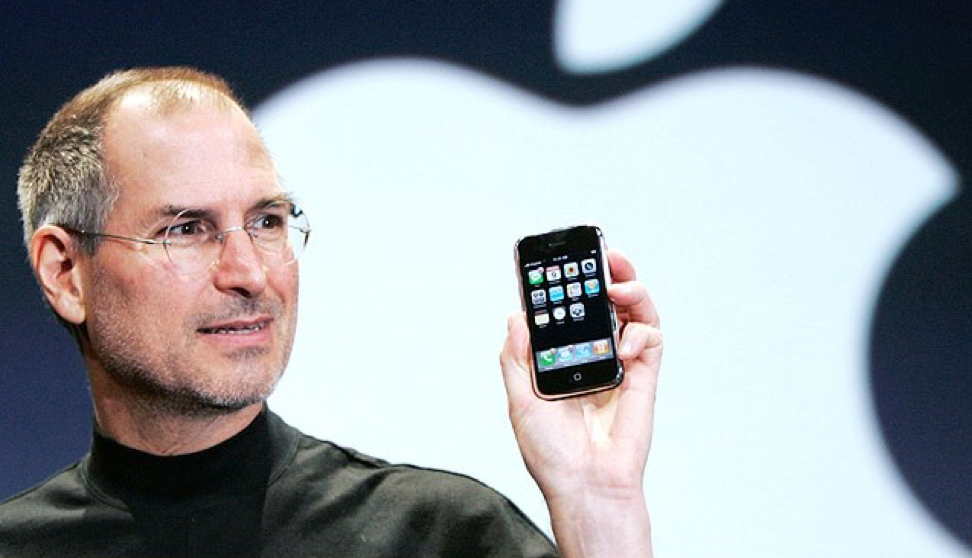
История Стива Джобса
Становление великого предпринимателя и изобретателя
Стив Джобс (Steven Paul «Steve» Jobs) родился в 1955 году, 24 февраля. Биологическими родителями Стива были не состоящие в браке студенты-мигранты. Отец – сириец Абдулфаттах Джандали, а мать – немка из католической семьи Джоан Шибле. Абдула родился в Хомсе. Он был сыном сирийского миллионера, что позволило мальчику поехать учиться в Нью-Йорк. Джандали познакомился с Шибле, будучи ассистентом преподавателя в Висконсинском университете. Джоан получала там образование в магистратуре.
Родственники Джоан Шибле выступали против её союза с Абдулфатаахам Джандали. Более того, отец девушки, который лежал тогда при смерти, и вовсе пообещал лишить её наследства, если та не послушает заветов папы. В итоге Джоане пришлось отдать сына – новорожденного Стива – на усыновление.
Приёмными родителями будущего гения стали Пол Джобс и Клара Джобс. Девичья фамилия женщины – американки армянского происхождения – Агопян. Пара не могла иметь своих детей и решила усыновить чужого ребёнка. Пол и Клара назвали мальчика Стивеном.
Примечательно, что биологическая мать Стива Джоан была убеждена, что её сын должен иметь высшее образование. Её смутило, что за плечами Пола – лишь средняя школа, а Клара бросила колледж. Женщина согласилась подписать документы об усыновлении лишь после того, как приёмные родители дали письменное обязательство оплатить обучение Стива в университете в полном объёме.
Стивен всю жизнь считал Клару и Пола родными родителями и не любил говорить об усыновлении. Однако однажды всё-таки встретился со своей биологической матерью и младшей сестрой. Произошло это лишь спустя 31 год после усыновления.
В семье Стивен был не единственным ребёнком. Когда мальчику было два года, Клара и Пол взяли из приюта девочку Пэтти. Уже вчетвером они переехали из Сан-Франциско в Маунтин-Вью. Клара работала в будущей Кремниевой долине бухгалтером в одной из первых высокотехнологичных компаний. Пол работал в финансовой холдинговой компании. Чтобы выполнить обязательства перед Джоаной и заработать Стивену на колледж, отец семейства ремонтировал в гараже старые машины и продавал их. Именно Пол привил мальчику любовь к электронике, когда копался с ним в автомобилях и радиоприёмниках.
Школьные годы и первое изобретение Стивена Джобса
Стивен не любил школьные занятия за формализм, но учителя его считали прилежным учеником. Сдав блестяще экзамены в четвёртом классе, мальчик сразу «перепрыгнул» в шестой. Притом что директор предлагал Кларе и Полу перевести Стива сразу в седьмой класс, однако родители решение не рисковать настолько сильно.
Помимо школы, мальчик ходил в научно-исследовательский кружок, который организовала одна из крупнейших в то время компаний в сфере информационных технологий Hewlett-Packard. В клуб приглашали инженеров, которые рассказывали ребятам, над каким проектом работают. Там перед взором Стива первый раз предстал персональный компьютер. На мальчика он уже тогда произвёл сильное впечатление.
На курсах ребята работали над собственными проектами. Стиву удалось собрать частотомер – прибор, который позволял определять частоту периодических сигналов. Там же, в клубе, школьнику удалось договориться с главой компании Hewlett-Packard о первой работе. Билл Хьюлетт предложил 13-летнему мальчику встать за конвейер, на что Стив, конечно, согласился. Позже Джобс будет также раздавать газеты и работать на складе в магазине электроники. А к 15-ти годам юный изобретатель уже приобретёт первую машины – конечно, при финансовой поддержке родителей – и поставит на неё новый двигатель.
«Синяя коробочка» Джобса и Возняка
В школе Джобса училась «легенда». Стивен Возняк был выпускником, который всерьёз увлекался компьютерами. Его знал каждый ученик, и между собой все называли просто «Воз». Джобсу удалось познакомиться с Возняком, который был старше на целых пять лет. Позже они и вовсе стали лучшими друзьями.
В 1971 году давно учившийся в университете Возняк узнал о некой субкультуре фриков, которые научились захватывать телефонные линии и звонить бесплатно по всему миру. Делали они это, используя звуковую имитацию тонального сигнала специальной частоты.
Один из таких чудаков выяснил опытным путём, что звук необходимой тональности издаёт свисток, который производители овсяных хлопьев Cap’n Crunch кладут внутрь коробки. Оттуда появился псевдоним — Капитан Кранч. Этот чудак изобрёл специальное устройство для захвата телефонной линии и назвал его Blue Box.
Такое же изобретение решили создать Стив Джобс и Стив Возняк. Первая попытка успехом не увенчалась. «Коробочка» — аналоговый прототип — не выдавала устойчивых тоновых сигналов. Тогда решили сделать полностью цифровое устройство. Blue Box начал воспроизводить сигналы частотой с нужной точностью.
Поначалу друзья просто дурачились, совершая звонки в разные уголки земного шара. Но позже Джобс понял, что «коробочка» может приносить доход. Юноши осознавали, что бизнес — дело рискованное и незаконное, однако начали кустарное производство аппаратов. Джобс и Возняк продали по 150 долларов за штуку порядка сотни Blue Boxes, себестоимость которых была около 40 долларов. Доход предприниматели делили поровну. Несколько раз полицейские наведывались к ним, и производство во избежание дальнейших проблем решено было прекратить. Однако именно первый бизнес научил молодых людей изобретать полезные для общества вещи и делать на этом серьёзные деньги.
Единственная и неудачная попытка Стива Джобса получить высшее образование
В 1972 году Стив покидает родительский дом и поступает в Рид-колледж. Родители юноши выступали против этого учебного заведения из-за стоимости и довольно вольных нравов. Рид-колледж был одним из самых дорогих в США частных гуманитарных университетов. Кроме того, в учебном заведении царила атмосфера хиппи. Притом что программа была насыщенной, а стандарты обучения — высокими. В любом случае — Джобс согласился учиться только там.
В колледже Стив начал интересоваться духовными практиками, стал вегетарианцем, увлекался дзен-буддизмом и даже экспериментировал с голоданием. В вузе Джобс встретил и второго своего близкого друга — Даниэля Коттке, а также познакомился с президентом студенческого совета Робертом Фридланом, который оказал серьёзное влияние на юного предпринимателя.
Джобс полгода проучился в колледже, а затем оставил учёбу. Молодому человеку наскучила обязательная программа. Стива отчислили, но разрешили бесплатно приходить на творческие занятия. Спал при этом юноша у друзей на полу, а еду покупал за счёт сбора и сдачи бутылок.
Прославившие Джобса изобретения: Apple I
В 1975 году Джобс и его давний друг Возняк начали посещать собрания группы энтузиастов, которые называли себя «Клубом самодельных компьютеров». Участники собирались в знаменитом гараже Стива Джобса и думали над тем, как внедрить новые — сложные для понимания простых людей — технологии в жизнь каждого человека.
Вдохновившись идеями участников клуба, Стив Возняк принялся проектировать машину, которую позже назовут Apple I. Уже за несколько месяцев молодой человек получил уникальный для того времени результат. Воз вывел на экране символы, которые набрал на клавиатуре. Итог работы показал Стиву. Джобс, в свою очередь, вновь заговорил о коммерческом потенциале изобретения друга.
20-летние ребята сначала начали создавать и продавать печатные платы, позже дело дошло и до сборки полноценных компьютеров. Уже через год изобретатели взяли себе помощника — чертёжника Рональд Уэйн. Помимо прямых обязанностей, нового сотрудника использовали как третий голос в тех случаях, когда два других спорили. Втроём 1 апреля 1976 года они создали фирму — Apple Computer Co. Для стартового капитала Джобсу пришлось продать свой микроавтобус и пересесть на велосипед, Возняк же простился с самой дорогой сердцу вещи — программируемым калькулятором.
Вскоре ребят ждал первый крупный заказ. Местный магазин электроники попросил 50 компьютеров. Однако денег у предпринимателей на детали для такого количества машин не было. Друзьям пришлось взять кредит, но уже через десять дней компьютеры были готовы и поступили в магазин. Каждый из них Джобс, Уэйн и Возняк продали чуть больше чем за 666 долларов.
Полсотни машин также продали «Клубу самодельных компьютеров». Позже несколько сотен ЭВМ реализовались через магазины и среди знакомых предпринимателей.
Один из самых популярных вопросов: почему Apple? Однозначно ответить на этот вопрос нельзя. Одни говорят, что всё дело в дизайнере Роб Янов, который работал тогда с ребятами. Мужчина якобы принёс из магазина яблоки, принялся их рисовать, надкусил одно и понял, что это идеальный рисунок для рекламы компьютеров. Другие утверждают, что коллеги Джобса долго не придумывали название, тогда Стив поставил ультиматум: если не будет других вариантов, назовём ЭВМ «яблоком». Верить или нет в эти версии, — решать вам. Доподлинно известно лишь, что изначально на логотипе был также Ньютон, на которого с дерева падает фрукт. Затем появилось разноцветное яблоко и только к 1998 году — одноцветное, из-за монохромности которого ряби в глазах уже не возникало, как в первых двух случаях.
Прославившие Джобса изобретения: Apple II
Стивен Возняк утверждал, что у его творения — Apple I — по сравнению с простейшими моделями не было никаких электронных инноваций, кроме «динамической» памяти. Все новые идеи он решил воплотить уже в новой машине — Apple II. Платформа была готова в августе 1976 года. С помощью устройства работали со звуком и цветом, а также подключали игровые контроллеры. По сравнению с предыдущими моделями функции были уникальными.
Apple II стал первым в мире массовым компьютером. Джобс в этот раз впервые позаботился о проведении рекламной компании и создании дизайна, с помощью которого можно было бы обойти конкурентов.
Новую модель продали в разные уголки мира тиражом в пять миллионов экземпляров. Благодаря этому Стив Джобс уже в 25 лет стал миллионером.
После второй модели, последовала третья, а затем Lisa и Macintosh. Фирма Джобса процветала, но среди руководителей компании назревал серьёзный конфликт. В основном — из-за скверного характера Стива.
Lisa, Macintosh и увольнение Стива Джобса
В 1979 году предприниматели работали уже над новой моделью под названием Lisa. Компьютеры были названы в честь дочери Джобса. Тогда сотрудников Apple пригласили в исследовательский центр Xerox, где IT-специалисты впервые увидели компьютеры Alto.
После визита в центр Стив решил во что бы то ни стало разработать интерфейс, который позволял бы давать команды машине с помощью курсора. Новые разработки Джобс решил применить в новой модели — Lisa. Хотел стать главой проекта инновационного компьютера единолично. Столь дерзкие идеи были не по душе другим сотрудникам компании.
Кроме того, в фирме начались проблемы с реализацией другой модели Macintosh. Джобс был уверен, что причина в завышенной цене компьютеров, и принялся обвинять в этом коллег. Стивен решил поставить на машины Lisa эмуляцию не столь популярной модели и продавать ЭВМ под новым брендом — Macintosh XL. Идея дала эффект, но не понравилась ведущим специалистам Apple потому, что по сути была обманом.
Сомнительные действия Джобса вызвали уход нескольких сотрудников. Стив при этом прощался с ними слишком легко, что только пугало коллег. Он становился чересчур требовательным и раздражительным из-за неудачных проектов. Испортились отношения Стивена и другого руководителя — Джона Скалли. Изобретатель решил избавиться от него, однако другие сотрудники не поддержали решение. Напротив, думали отстранить от дел самого Джобса, что и было позже сделано. Некоторое время он формально ещё руководил делами, но поняв, что отсутствия создателя компании никто не замечает и коллеги от него отвернулись, создал новую фирму.
«Я освободился и вошёл в один из самых креативных периодов своей жизни»
Позже именно так про этот период своей жизни скажет Стив Джобс. Ещё до увольнения — в 1985 году — он познакомился с лауреатом Нобелевской премии, биохимиком Полом Бергом. Тот поделился с единомышленником идеями. Джобс решил воплотить их в новой модели компьютера. В Apple предприниматель запустил проект Big Mac, но после ухода исследователя из фирмы его закрыли. Тогда Стиву представилась возможность разрабатывать новые машины уже в другой — своей — фирме.
Чтобы разработать модель, Джобс переманил к себе из команды Macintosh несколько человек и основал новую компанию под названием NeXT Inc. Со стороны тут же последовали обвинения в недобросовестности бывшего сотрудника. Основатель фирмы отшучивался, мол, компания с четырьмя тысячами сотрудников и оборотом в два миллиарда долларов испугалась шестерых простых ребят.
При создании компьютеров NeXT Джобс использовал самые передовые технологии. Однако для массовых потребителей машины были слишком дорогими. Доход вычислительная техника приносила, но для Стивена недостаточный.
Миллионер начинает увлекаться компьютерной графикой и следить за деятельностью компании Pixar (тогда называлась The Graphics Group). Эту корпорацию основали в 1979 году для создания анимации. Спустя семь лет Джобс выкупает её у основателя Джорджа Лукаса за пять миллионов долларов: продавец нуждался в деньгах.
Изначально Стивен хотел использовать анимационные фильмы Pixar как рекламу для компьютеров NeXT. Однако из-за необычайной популярности мультфильмов пересмотрел свои планы. Позже — в 2006 году — Disney покупает Pixar за 7,5 миллионов миллиардов (в 1000 раз больше!), а на киностудии выходят такие популярные фильмы, как «В поисках Немо», «История игрушек», «Корпорация монстров». При этом Джобс остаётся акционером компании.
Возвращение к своему детищу: Think Different
Итак, шёл 1996 год. В это время Стив Джобс — владелец сразу двух предприятий. Речь идёт о компании по производству компьютеров NeXT и киностудии Pixar. Однако компьютерная фирма уже три года как не производит машин — только различные инструменты для разработчиков.
И вот неожиданно 20 декабря Apple — первая компания Джобса — объявляет о намерении купить NeXT. И это несмотря на то, что предложения о покупке компании ранее им уже поступали. В этот раз открылись новые возможности. Руководство «яблока» хотело использовать операционную систему NeXTStep вместо устаревающей Mac OC. Apple приобрели за 427,5 миллионов долларов: 426 миллионов заплатили инвесторам NeXT и ещё 1,5 миллиона — лично Стиву.
Вскоре Джобс — спустя 11 лет изгнания — возвращается в Apple в качестве советника председателя, а позднее становится пожизненным генеральным директором этой компании. Надо отметить, что после возвращения гуру в Apple были закрыты многие проекты и уволены более 3 тысяч сотрудников. Дошло до того, что люди боялись пересекаться с директором в лифте, дабы не лишиться работы. Стив запретил пользовать ПО Apple другим производителям и сократил весь ассортимент до четырёх моделей компьютеров.
Тем не менее, такие меры дали свои плоды. Сократилось малоприбыльное производство, расходы Apple резко сократились, а доходы увеличились. Что же сделал для компании Джобс после своего возвращения?
Новые разработки Стива Джобса
Для своего детища Стив придумывает новый слоган Think Different и выпускает уникальный компьютер iMac. Моноблок сразу привлёк любителей ЭВМ своим футуристическим дизайном и стал самой продаваемой машиной в истории Apple. С помощью iMac Джобсу удалось захватить новый потребительский рынок: треть моноблоков раскупили люди, которые до этого никогда не пользовались компьютерами.
Вторым шагом для Стивена стало создание специализированных магазинов по продаже оборудования Apple. Первые Apple Store были открыты сразу в двух американских городах в мае 2001 года. Основатель компании лично выбирал место для открытия и утверждал каждый элемент дизайна помещений. И это принесло свои плоды. В результате за три года сети удалось достичь показателя почти в 5,6 тысяч посетителей в неделю.
Во многом благодаря Джобсу Apple вернула себе лидирующие позиции на IT-олимпе. Это позволило Стивену осуществить свой план по внедрению операционной системы NeXTStep в персональные компьютеры. Её интерфейс был изменён в стиле Mac и теперь мы знаем её как Mac OS X, ставшую бестселлером.
Затем Джобс решил создать MP3-плеер, и уже в 2001 году на свет вышел первый iPod. Продуманный до мелочей интерфейс, уникальный дизайн, небольшие габариты и удобное управление — это всё про новое изобретение от Apple. Спустя пять лет 75% купленных плееров приходилось именно на iPod, а по объёму продаж этот гаджет сравнялся с компьютером.
Но Джобс не стоит на месте и через год рождает новый хит. Он создаёт первый гаджет, который выполняет функции компьютера, мобильного телефона и плеера. При этом устройством можно управлять при помощи сенсорного интерфейса. Это был, конечно, iPhone.
Но и телефон стал не последним устройством, созданным Джобсом. Венцом его творений является планшет. Именно он прервал господство персональных компьютеров. Первая модель была представлена самим Стивеном на презентации в Сан-Франциско в 2010 году.
Человек, живущий на зарплату в один доллар в год
Как было сказано выше, Стив Джобс стал миллионером уже в 25 лет. Тогда его состояние оценивалось в 256 миллионов долларов. В конце жизни создатель самых технологичных телефонов — предсказуемо — был уже миллиардером.
Причём на своей последней должности — генерального директора Apple — Стив получал годовую зарплату всего лишь в один доллар. Он шутил: «50 центов я получаю за появление на работе и столько же — за эффективность». Но заработная плата ему была уже не нужна. Джобс владел почти 5,5 миллионами акций своей компании общей стоимостью более чем в два миллиарда долларов. Кроме того, ему принадлежали 138 миллионов акций Disney, чья стоимость составляла 4,4 миллиарда долларов. Их изобретатель получил в обмен на продажу студии Pixar.
В 2011 году журнал Forbes поместил Стива Джобса на 39 место в списке самый богатых американцев. Исследователи оценили чистые активы предпринимателя в семь миллиардов долларов.
Жена и дети Стива Джобса
Единственной женой основателя Apple была Лорен Пауэлл. Они познакомились в 1989 году в Стэнфордской школе бизнеса, где Джобс читал лекцию. Их роман развивался стремительно. По признанию Стивена, Лорен вскружила ему голову.
Жена Стива Джобса была младше его на восемь лет. Лорен работала в банке. Они поженились в 1991 году, а спустя полгода у них родился первенец — сын Рид. К 1998 году Стивен стал многодетным отцом. К тому времени у него появились ещё две дочери: Эрин и Ив.
Однако, на самом деле, у Джобса было четверо детей. Он был отцом ещё одной девочки — Лизы Бреннан. Её мать — Крис — первая девушка Стивена. Они начали встречаться ещё в 1972 году, до окончания школы. Спустя четыре года Крис отправляется с их общим другом в Индию, а по приезду понимает, что беременна.
Стивен отрицал отцовство под предлогом того, что у Крис были другие мужчины. Девушка устраивала скандалы, обвиняя Джобса в том, что он хочет выставить её гулящей женщиной. При этом юный гений принимал участие в жизни Лизы и не позволил Крис отдать новорождённую чужим людям, как когда-то поступили с ним.
Через год Стивен сдал тест на отцовство. Он показал, что Джобс с вероятностью почти 95% приходится отцом Лизы. Однако основатель Apple ещё долгое время не признавал дочь, придумывая небылицы, якобы 25% мужчин США могли быть отцами девочки. Суд обязал его выплачивать Крис алименты. Позже Стив всё-таки купил своей первой девушке и дочери дом и даже оплачивал Лизе обучение. В дальнейшем Джобс и морально, и финансово редко помогал Крис с девочкой.
Мать Лизы делала в разное время несколько попыток получить компенсацию за годы нищеты от Джобса. Но на все просьбы получала лишь отказ. «Я не очень хорошо реагирую на шантаж», — отвечал Стив. Однако в наследство он оставил первой дочери несколько миллионов долларов. Существенную часть денег Лиза использовала для помощи больной матери.
Последняя презентация и причина смерти Стива Джобса
Вероятно, основатель Apple мог бы сделать ещё очень много для своей компании, но здоровье помешало ему это сделать. С 2003 года Джобс боролся со страшной болезнью — раком поджелудочной железы. В июне 2011 года 56-летний гений проводит свою последнюю презентацию. Он представляет новую операционную систему для смартфонов iOs 5 и сервис iCloud. Но спустя три месяца Стивену пришлось уйти с поста CEO компании, оставив за собой пост председателя совета директоров. Как следствие — акции Apple и Wall Disney Co. мгновенно упали на несколько процентов. Все понимали, что Джобс создавать былые шедевры уже не сможет.
Последние дни гения
Несмотря на ужасное самочувствие, Стивен старался вникать в дела Apple до самой своей смерти. Он консультировал Тима Кука, которого оставил в качестве своего приемника.
5 октября 2011 года компании Microsoft и Apple приспустили флаги на своих зданиях: в три часа дня Стив Джобс скончался. Он умер в окружении самых близких людей: детей, жены и сестры.
От чего умер Стив Джобс — доподлинно известно. Это был рак поджелудочной железы, с которым он боролся восемь лет. Доктор заявлял позже, что к столь ранней смерти привёл первоначальный выбор альтернативного лечения.
Общественное признание Стива Джобса
Основатель Apple сумел всю жизнь держать руку на пульсе времени, создавая фантастические устройства. Он сам создавал это время и диктовал ему свои законы в IT-сфере. Джобс создал и наладил производство множества миниатюрных, но совершенных по своим возможностям устройств: iPhone, iPad, iPod, а также магазины Apple Store и медиаплеер iTunes. Каждое из них появлялось намного раньше аналогов, предлагая конкурентам стандарты качества. И это не говоря о том, что Стив создал один из первых персональных компьютеров, обладавших невероятным коммерческим успехом.
Ни для кого не секрет, но до сих пор Джобс является символом как минимум одной компании — Apple. В 2010 году Forbes составил список самых влиятельных людей мира, поставив Стивена на 17 место. Спустя месяц Financial Times назвал его человеком года.
Через год в Будапеште появилась первая в мире бронзовая статуя Стива Джобса. Основатель Apple был посмертно награждён премией Grammy. Disney снял посвящённый ему фильм — «Джон Картер», а Pixar — мультфильм «Храбрая серцем». Помимо этого, есть около десятка фильмов о гении XX-XXI столетий. Публицисты и коучи ставят Джобса в один ряд с такими выдающимися изобретателями и предпринимателями, как Генри Форд и Томас Эдисон.
Биография
Стив Джобс — американский предприниматель, промышленный дизайнер и изобретатель, один из основателей Apple Computer Co. Он являлся пионером эры информационных технологий, основателем компаний NeXT и студии Pixar, крупнейшим частным акционером и членом совета директоров Disney.
Детство и юность
Стивен Джобс родился 24 февраля 1955 года (знак зодиака — Рыбы) в Сан-Франциско, Калифорния. Его биологические родители имеют разные национальности. Отец, сириец Абдулфатта Джандали, был ассистентом преподавателя в Висконсинском университете. Мать Джоан Шибле, имеющая немецкие корни, являлась юной студенткой того же учебного заведения. Джоан и Абдулфатта не состояли в браке: семья девушки выступала категорически против отношений молодых людей. Поэтому будущая мать вынуждена была уехать рожать в частную калифорнийскую клинику, а затем отдать сына на воспитание приемным родителям.
Пол Джобс и его супруга Клара не могли иметь своих детей и с радостью усыновили малыша. Джоан выдвинула единственное требование — мальчик должен получить высшее образование.
Через 2 года у Стива появилась сестра Пэтти, которую Пол и Клара также удочерили. Вскоре семья покинула Сан-Франциско и переехала в небольшой городок Маунтин-Вью. Здесь главе семейства, который был автомехаником, было проще найти хорошую работу и копить средства на оплату учебы детей в колледже. Приемный отец старался привить интерес к механике и сыну, но его гораздо больше привлекла электроника. Маунтин-Вью является центром высоких технологий, так что, можно сказать, будущее Стива было предрешено в раннем детстве.
В начальной школе мальчик создавал большие проблемы учителям. Сама система образования казалась ребенку скучной, формальной и бездушной. Лишь после того, как одна из преподавательниц смогла найти правильный подход к ученику, он стал учиться прилежно и даже перескочил через 2 класса. Обучаясь в средней школе, Стив посещал кружок радиоэлектроники, самостоятельно собрал электронный частотомер и даже подрабатывал на конвейере в компании Hewlett-Packard.
Когда юноше исполнилось 16 лет, у него начались конфликты с родителями, прежде всего с отцом: Стив увлекся хиппи-культурой, музыкой Боба Дилана и The Beatles, курил марихуану и употреблял ЛСД. Но до наркозависимости не дошло. Тогда же он познакомился с тезкой Стивом Возняком, который был старше на 5 лет. Ребята стали лучшими друзьями, так как оба увлекались компьютерами и электроникой.
Первое совместное изобретение Джобса и Возняка родилось, когда будущий миллиардер еще был старшеклассником. Они сделали устройство, которое назвали blue box, для взлома телефонной сети путем подбора сигналов тонального режима. Сначала ребята просто развлекались, а затем стали продавать свое изделие и неплохо заработали.
В 1972 году Джобс поступил в частный гуманитарный Рид-колледж, который имел насыщенную учебную программу. Всего через полгода юноша бросил учебу, так как не видел смысла тратить время на неинтересные занятия. В этот период его гораздо больше привлекали восточные духовные практики, вегетарианство, веганство, йога и дзен-буддизм.
Личная жизнь
В молодости Стив был любвеобильным, как и положено в культуре хиппи. Первой заметной женщиной в его жизни стала Крис Энн Бреннан. Отношения были сложными, пара часто ссорилась и расходилась. В 1978 году Крис родила дочь Лизу Бреннан, которую Джобс первоначально не признавал. Но после ДНК-теста согласился на отцовство.
Позже мужчина состоял в отношениях с Барбарой Ясински, занимавшейся рекламой, фолк-певицей Джоан Баэз и консультантом по компьютерам Тиной Редсе, с которой расстался после того, как девушка отказалась выйти за него замуж.
Единственная жена бизнесмена — Лорен Пауэлл, на момент их знакомства была сотрудницей банка. Любопытно, что, сделав предложение в 1990 году, Джобс на несколько месяцев забыл о невесте, так как погрузился в очередной бизнес-проект.
Тем не менее в марте 1991-го влюбленные стали супругами, а в сентябре у них родился первенец — сын Рид. Через 4 года появилась на свет дочь Эрин, а в 1998-м — Ив. Интересно, что Стив запрещал своим детям подолгу пользоваться компьютерами, ограничивал время «общения» с «Айфонами» и «Айпадами».
В середине 80-х годов Джобс разыскал свою биологическую мать и познакомился с родной сестрой Моной, с которой стал поддерживать дружеские отношения.
В отличие от стиля своей техники Стивен был крайне непритязателен к выбору одежды, как и Билл Гейтс. На протяжении 13 лет миллиардер носил тонкий черный свитер, светлые джинсы Levi’s 501 и кроссовки New Balance. В этом можно убедиться, изучив фото бизнесмена с официальных встреч и выступлений.
Неотъемлемым атрибутом легендарного предпринимателя являются и очки. Любимым аксессуаром гения была модель Classic Rund от немецкого производителя Lunor с идеально ровными круглыми линзами и тонкими изящными заушниками. Они стали невероятно популярными благодаря Джобсу.
Что касается часов, то у Стивена были две модели — повседневные «Сейко M159-5028 Quartz LC» на браслете из металла и роскошные винтажные золотые Baume & Mercier Hampton на ремешке из коричневой кожи ящерицы. У мужчины была одна причуда — он ездил на автомобиле Mercedes-Benz SL55 AMG без номеров.
Имя миллиардера никогда не было связано с благотворительностью, но Стивен и его жена анонимно жертвовали деньги на благотворительные цели. Для этого Лорен Пауэлл-Джобс открыла общество с ограниченной ответственностью Emerson Collective. Поскольку организация не была заявлена как благотворительная, на нее не распространялись налоговые льготы, зато супруги не афишировали свою деятельность и могли более ответственно подходить к выделению средств. Кстати, состояние Джобса достигало $ 7 млрд.
Компания Apple
Стивен устроился работать в качестве техника в начинающую компанию Atapi, которая занималась производством компьютерных игр. В это же время Возняк работал над созданием и совершенствованием плат для персонального компьютера. Когда идея стала вырисовываться практически, Джобс предложил другу создать совместную компьютерную фирму. Так началась история успеха и появилась ставшая впоследствии легендарной компания Apple.
Кстати, у Apple изначально было три сооснователя — помимо друзей, ею владел и коллега Джобса по Atari Рональд Уэйн. Но он уступил свою долю (10 %) за $ 800 через 3 месяца после создания компании.
При работе над первым вариантом компьютера Apple I Стивен проявил себя как авторитарный, несколько тираничный и агрессивный, но в то же время умеющий организовывать дело руководитель.
Первый компьютер, собранный в гараже — пристройке дома родителей гениального парня, был примитивным и больше напоминал электронную печатную машинку. А вот новая плата, которую Возняк разработал в 1976 году, уже умела работать с цветом, звуком, могла подключать внешние носители.
Джобс проявил лидерские таланты и в продвижении устройства и смог переориентировать производство на создание компьютеров для неискушенного пользователя. Именно его идеям новый Apple II обязан красивым пластиковым корпусом и аккуратным внешним видом. Также Стив нанял профессионального специалиста по рекламе Реджиса Маккена, и о новом компьютере заговорили все.
Затем последовали Apple III, Apple Lisa и Macintosh. С коммерческой точки зрения фирма процветала, но среди руководителей царили раздор и скандалы во многом из-за тяжелого характера Стивена.
Компания NeXT и студия Pixar
В итоге Джобса отстранили от работы, и в 1984 году он покинул свое детище, но сразу организовал новую компанию NeXT Computer. Компьютеры этой фирмы предлагали рынку исключительно передовые новинки, слегка опережающие время. Но, как и в Apple, инновации оказались слишком дорогими для массового потребителя.
Параллельно с этим проектом Стив, который как раз увлекся компьютерной графикой, выкупил у Джорджа Лукаса студию Pixar за $ 5 млн. Изначально его идеей было использовать анимацию как рекламу возможностей предлагаемых NeXT компьютеров. Но после того как вышедший в 1987 году мультипликационный фильм «Оловянная игрушка» получил премию «Оскар», Джобс пересмотрел свое мнение. Позже на этой студии создали такие знаменитые полнометражные анимационные ленты, как «История игрушек», «Корпорация монстров», «В поисках Немо», «Суперсемейка», «Тачки», «Рататуй» и другие.
В 2006 году Стив продал Pixar компании Disney за $ 7,5 млрд. При этом он остался акционером.
Возвращение в Apple
В 1996 году Джобс продал NeXT своей первой компании почти за $ 0,5 млрд и вернулся в Apple в качестве советника председателя.
Первым достижением в новом качестве стал серийный выпуск нового моноблочного компьютера iMac, который привлекал своим необычным футуристическим дизайном. Это устройство стало самым продаваемым в истории Apple, причем около трети экземпляров купили пользователи, которые ранее не были владельцами компьютерной техники. Следовательно, Стив смог найти для компании новый рынок потребителей.
Вторым успешным шагом стало создание Apple Store — специализированного магазина по продаже оборудования компании Apple.
Уникальность Стивена заключалась в том, что он не просто держал руку на пульсе времени, а сам создавал новое время и диктовал законы моды в IT-индустрии. Поняв, что новый век становится стремительным, он наладил производство миниатюрных, но совершенных по своим возможностям устройств: медиаплеер iTunes, музыкальный плеер iPod, сенсорный мобильный телефон iPhone, интернет-планшет iPad. Каждое из них появлялось раньше аналогов и навязывало компаниям-конкурентам стандарт и параметры.
В 2007 году во время кадровой чистки Джобс лично тестировал кандидатов на увольнение, задавая загадку, решить которую нужно было за 30 секунд. Требовалось найти выход из блендера, если человека уменьшили до монеты в 5 центов. Загадка имеет как минимум четыре правильных ответа.
Болезнь и смерть
Последний раз в своей жизни мужчина выступил на публике 6 июня 2011 года. За несколько лет до этого у бизнесмена диагностировали рак поджелудочной железы. Именно он стал причиной смерти Джобса. Миллиардер боролся с болезнью различными способами, в том числе альтернативными, но она победила. Нынешний глава компании Apple Тим Кук предложил коллеге фрагмент своей печени — у них один и тот же редкий тип крови. Но перед смертью Стив наотрез отказался от операции и скончался 5 октября 2011 года в возрасте 56 лет в кругу своей семьи.
После похорон основателя Apple соцсети наводнили цитаты из предсмертной речи Стива. Они звучали примерно так:
«Мне удалось достичь вершины успеха в мире бизнеса. Многие считают, что моя жизнь — это олицетворение успеха. Но признаюсь, помимо работы у меня не так много радостей. И вообще, богатство — это только факт жизни, к которому я просто привык…»
Однако дело в том, что последние слова умирающего человека не могли звучать именно так. В последние часы жизни Стив утратил связь с реальностью и практически не говорил, что подтверждают многочисленные свидетели: жена, дети, сестры Джобса. Более того, речь появилась только в 2015 году. Попытка найти первоисточник не удалась, поскольку текст быстро распространился в постах социальных сетей.
По решению семьи на могиле Джобса не установлен памятник. Чтобы попрощаться с кумиром, фанаты несли открытки, цветы и зажженные свечи к кампусу Apple в Пало-Альто и даже к обычным Apple Store. Стивен завещал похоронить его рядом с приемными родителями в Альта-Месе. Из-за наплыва людей, которые хотели найти захоронение предпринимателя, руководство кладбища выделило специальную книгу для памятных записей от поклонников. В ряде стран уже есть памятники, посвященные талантливому изобретателю.
Память
О миллиардере написано множество книг и снято большое количество документальных и художественных фильмов. Наиболее интересным печатным изданием является авторизованная биография «Стив Джобс», вышедшая в 2011 году. Автор книги — американский журналист Уолтер Айзексон. Еще одно произведение «Стив Джобс. Уроки лидерства» Уильяма Саймона и Джей Эллиот вышло в 2012-м.
В 2015 году журналисты Брент Шлендер и Рик Тетцели написали книгу «Стать Стивом Джобсом», в которой обнародованы ранее не известные подробности из жизни предпринимателя. В 2016 году список биографий сооснователя Apple пополнился книгой Бориса Соколова «Стив Джобс. Человек-легенда».
Из фильмов стоит выделить документальную работу «iГений: как Стив Джобс изменил мир», который снял канал Discovery, «Стив Джобс. Потерянное интервью», «Стив Джобс: хиппи с миллиардом долларов» и художественный фильм «Джобс: империя соблазна», где роль легендарного изобретателя исполнил актер Эштон Катчер.
В 2015 году состоялись премьеры документальной биографии «Стив Джобс: человек в машине» режиссера Алекса Гибни и художественной ленты «Стив Джобс» Дэнни Бойла с Майклом Фассбендером в главной роли.
В 2017 году закончилось строительство штаб-квартиры компании в Купертино. Круговое 4-этажное здание занимает общую площадь 260 тыс. м² и вмещает свыше 12 тыс. работников. Официальное название кампуса — Apple Park, а название именной аудитории изобретателя звучит как «Театр Стива Джобса». В последний год жизни миллиардер активно занимался этим проектом, участвовал в разработке общей концепции. В последнем публичном выступлении миллиардер сказал, что у компании «есть шанс на создание лучшего офисного здания в мире». Стоимость только земельного участка составила $ 160 млн, а всего проекта — свыше $ 5 млрд.
Последние годы стали для Apple кризисными. Продажи «Айфонов» падают, а сама техника уже не вызывает у пользователей трепета. Более того, в июле 2019 года компания потеряла главного дизайнера бренда Джонатана Айва. По неофициальной информации, дизайнер покинул фирму из-за творческих разногласий с Тимом Куком, сменившим Джобса на посту генерального директора.
Интересные факты
- В 2010 году в результате проверки выяснилось, что на одном из китайских заводов, поставляющих комплектующие для гаджетов iPod и iPhon, используется детский труд.
- Во время визита Дмитрия Медведева в Кремниевую долину в 2010 году глава компании Apple подарил ему iPhone 4.
- Перед смертью Джобс написал последнее письмо совету директоров и сотрудникам компании, которое в свободном доступе находится на корпоративном сайте Apple.
- Для снятия стресса, прояснения ума и развития креативности признанный гуру в мире IT-технологий использовал медитацию осознанности. На сегодняшний день пользу таких упражнений подтвердили многочисленные исследования, а ведущие компании мира, включая Google, Ford, Target, обучают своих сотрудников подобным практикам.
- Когда Джобса пригласили выступить на вручении дипломов, в своей речи выпускникам Стэнфорда он произнес фразу, которая впоследствии стала популярным афоризмом: «Оставайтесь голодными. Оставайтесь безрассудными».

